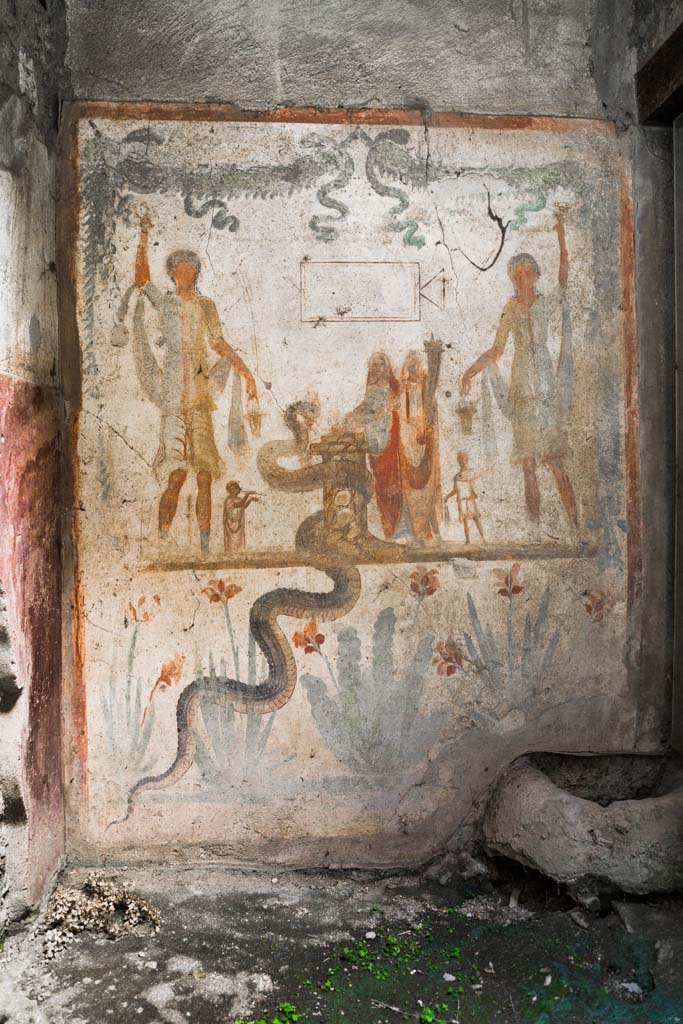Pompeii.
Household shrines to the domestic gods, IX.7.15 to IX.14.4.
These pages contain all the references to Lararia, Aedicula, Niches, Sacrarium/Sacellum, and Lararium paintings, found inside properties in Pompeii.
For some of these the actual purpose is unknown.
The individual locations identified on each item may contain further photos and details, you can see these by looking at the pompeiiinpictures pages in question.
Back to household shrines list
Region IX.
IX.7.14 or 16 Pompeii.
Aedicula lararium in garden whose west wall borders the vicolo.

IX.7.12, 14 or 16 (?) Pompeii. 2017.
Looking down from the Casina dell’Aquila towards an aedicula lararium in the north-west corner of the garden area “e”, on the right in the photo.
Photo courtesy of Google Earth.
Due to the fact that the area has not been fully excavated, it is not known whether this garden area belongs to IX.7.12, 14 or IX.7.16 or any other house in IX.7 entered from south or east side of Insula and still unexcavated.

IX.7.14 or 16 Pompeii. 2023.
Looking down from the Casina dell’Aquila towards a possible aedicula in the north-west corner of the garden area, in the centre of the photo.
Photo courtesy of Google Earth.
Due to the fact that the area has not been fully excavated, the garden area may belong to either house IX.7.14 or IX.7.16.

IX.7.12, 14 or 16 (?) Pompeii. October 2024.
Garden area “e”, north wall with lararium in north-west corner. Photo courtesy of Klaus Heese.

IX.7.12, 14 or 16 (?) Pompeii. October 2024.
Garden “e”, looking towards south side of lararium in north-west corner. Photo courtesy of Klaus Heese.

IX.7.12, 14 or 16 (?) Pompeii. October 2024.
Garden area “e”, looking north-west towards lararium. Photo courtesy of Klaus Heese.

IX.7.12, 14 or 16 (?) Pompeii. October 2024.
Garden area “e”, lararium in north-west corner. Photo courtesy of Klaus Heese.
According
to Boyce –
Against
the west wall of the garden stands an aedicula, built upon a square masonry
base (0.92 square, h.0.70).
The
sides of the base are decorated with green plants painted on the white ground.
Above
the base, walls enclose a niche (h.0.42, w.0.52, d.0.62).
In
front of the structure stands a small altar (0.24 by 0.23, h.0.80).
The
roof (no longer preserved) originally extended out over the altar as well as
the niche, and the front of it was adorned with a pediment.
It
was supported by two columns, the marks of the bases of which are still to be
seen near the corners of the base.
On
the walls within the niche is the lararium painting.
On
the back wall to the right of an altar, stands the Genius pouring a libation
upon it.
To
the left of the same altar is a serpent, the head of which was done in stucco
relief.
On
each of the side walls are painted three figures: from back to front – a plant,
a Lar, a man in a white garment holding in his left hand an object resembling a
black cup, with a patera in his right hand.
He
quotes references – Not. Scavi, 1881, 92-93; Bull. Inst., 1883,
146.
In Not.
Scavi, it is described as House, only partly excavated – “and corresponds
to, after the sixth doorway, west side, counting from the north-west”.
In Bull.
Inst, it is described as “West side, first entrance counting from the
south, garden in part excavated.”
See Boyce G. K., 1937. Corpus of the Lararia of Pompeii. Rome: MAAR 14. (p.89, no.445).

IX.7.12, 14 or 16 (?) Pompeii. October 2024.
Garden area “e”, remains of painting on north side wall of lararium. Photo courtesy of Klaus Heese.

IX.7.12, 14 or 16 (?) Pompeii. October 2024. Garden area “e”, detail from north wall of lararium. Photo courtesy of Klaus Heese.
According to Boyce -
“On
each of the side walls are painted three figures: from back to front –
a
plant, a Lar, a man in a white garment holding in his left hand an object
resembling a black cup, with a patera in his right hand.”
See Boyce G. K., 1937. Corpus of the Lararia of Pompeii. Rome: MAAR 14. (p.89, no.445).

Looking north-west from Casina dell’Aquila to rear of IX.7.14, in centre. December 2007.
According to Boyce and Jashemski, a garden was excavated near here.
The west wall of the garden can be partially seen on the right side of the doorway of IX.7.14.
Whether it belonged to IX.7.12, 14, or 16 cannot be seen until further excavation.
See Boyce G. K., 1937. Corpus of the Lararia of Pompeii. Rome: MAAR 14. (p.89, no.445)
According to Jashemski, she quoted the location as IX.7.12(?).
She said in the north-west corner of this partially excavated garden, at the left of the entrance, stood an aedicula lararium.
In front of the lararium was a small altar, and a lararium painting on the wall around the shrine.
Many marble sculptures decorated the garden.
See Jashemski, W. F., 1993. The Gardens of Pompeii, Volume II: Appendices. New York: Caratzas. (p.239).
IX.7.16 Pompeii.
Painting on north and west wall of kitchen (d). (No trace survives).

IX.7.16 Pompeii. October 2024.
Room “d”, on south side of room 3, on right, looking south through site of wall and doorway into kitchen, no longer in situ.
On the left would be a doorway into room 6. Photo courtesy of Klaus Heese.
According to Boyce –
“In the kitchen, which is entered through the first room on the right of the atrium, on the north wall to the right of the entrance and on the west wall, is the lararium painting (h.1.50, w. on north wall 0.60, on the west wall 1.94): on the right of an altar stands the Genius in the usual attire, pouring a libation from a patera; on the left is the lower part of the figure of the tibicen and behind him stands a camillus wearing white tunic and carrying in his left hand, a shallow dish, taeniae in the right hand. Behind the Genius the popa, wearing a crown of leaves, holds a knife to the throat of a hog adorned with a red band around its belly. On each side of this group of four is a Lar in the usual attire. In the lower zone two yellow serpents, each with red crest, are confronted at an altar. The painting thus described is all on the west wall of the room. On the north wall are painted the following kitchen objects (from top to bottom): a hearth, an uncertain object – perhaps the fire-wood for the hearth – a hog’s head, a pot on a fire.
Traces of the older lararium painting, not entirely covered over by the later, are to be seen on the west wall, where the figure of a Lar can be made out on the left side.”
See Boyce G. K.,
1937. Corpus of the Lararia of Pompeii.
Rome: MAAR 14. (p. 87, no. 436)
and Boyce gives the reference Bullettino dell’Instituto di Corrispondenza Archeologica (DAIR),
1883, 145.

IX.7.16 Pompeii. May 2010. Cubiculum, with
kitchen area, at rear, upper left.
According to Boyce, the room behind this wall
would have been the kitchen.
This would have had a lararium painting on
the north and west wall (h.1.50, width on north wall 0.60, width on west wall
1.94).
See Boyce G. K., 1937. Corpus of the Lararia of Pompeii. Rome: MAAR 14. (p. 87, no. 436)
and Boyce gives the
reference Bullettino dell’Instituto di
Corrispondenza Archeologica (DAIR), 1883, 145.
See Giacobello, F., 2008. Larari Pompeiani: Iconografia e culto dei Lari in ambito domestico. Milano: LED Edizioni, (p.209, no.105).
IX.7.19 Pompeii.
Fragment of Lararium painting on east wall of north ala.

IX.7.19 Pompeii. October 2024. Looking north-east in ala c towards east wall, on right. Photo courtesy of Klaus Heese.
According to Boyce, on the east wall of the left ala, a fragment of a lararium painting was seen at the time of excavation.
The fragment represented a single serpent moving amongst foliage.
See Boyce G. K., 1937. Corpus of the Lararia of Pompeii. Rome: MAAR 14. (p.88, no.437)
See Fröhlich, T., 1991. Lararien und Fassadenbilder in den Vesuvstädten. Mainz: von Zabern. (p.112).
Lararium painting on east wall in small room (k).

IX.7.19 Pompeii. October 2024. Room k, looking south through doorway in corridor f. Photo courtesy of Klaus Heese.
The east wall and south-east corner are on the left, presumably the site of the lararium painting, but nothing now remains.
According to Boyce,
a small room, room k, located between kitchen and garden on the south side of
the house, was originally part of the garden.
This small room had
a doorway into the kitchen.
Then the room was
separated from the garden and the doorway to the kitchen was bricked-up.
On the east wall of
this new room was a lararium, with a Genius standing to the right of a tripod.
On the other side of
the tripod stood the tibicen. Below and to the right, ran a camillus.
Below this were two
serpents, gliding, one from each side, amongst plants towards an altar.
Between this
painting and the south-east corner of the room were painted, two pots, a large
bottle, sausages, a calf’s head, ribs of pork on a spit, and a phallus.
He references – Not.
Scavi, 1880, 491; Bull. Inst., 1883, 82.
See Boyce G. K.,
1937. Corpus of the Lararia of Pompeii.
Rome: MAAR 14. (p.88, no.438)
According to NdS, the were also two Lares:
To right in the atrium there is a room communicating with the back room of the
following taberna, and the access to the kitchen with the latrine, and to a
cell, where the lararium painting is divided into two strips; in the lower part there
are the two serpents, which rush towards the altar with the offerings, and in
the upper part the sacrificing Genius Familiaris, with tibicen and a camillus
between the two Lares.
See Notizie degli Scavi di
Antichità, 1880, p. 491.
Fröhlich notes: Boyce
does not mention Lares.
Boyce 438 (IX 7, 19) describes the Genius with Camillus and Tibicen grouped
around the altar in the usual way, but without the Lares.
See Fröhlich, T., 1991. Lararien und
Fassadenbilder in den Vesuvstädten. Mainz: von Zabern. (p.112).
See Giacobello, F., 2008. Larari Pompeiani: Iconografia e culto dei Lari in ambito domestico. Milano: LED Edizioni, (p.209, no.106)
IX.7.20 Pompeii.
Rectangular niche set in panel of stucco on south wall of atrium.

IX.7.20 Pompeii.
October 2019. Looking towards south wall of atrium with niche.
Foto Annette Haug,
ERC Grant 681269 DÉCOR.
According to Boyce –
A section of the
south wall of the atrium was covered with a panel of white stucco and in it was
set a rectangular niche (h.0.53, w.0.41, d.0.27, h. above floor 1.45).
It was framed by a
stucco aedicula façade (h.0.90, w.0.70) consisting of two applied half-columns
resting upon a projecting cornice and supporting a pediment. Within the niche
stood a bronze lamp and three bronze statues.
See Boyce G. K.,
1937. Corpus of the Lararia of Pompeii.
Rome: MAAR 14. (p.88, no 439).

IX.7.20 Pompeii.
1968.
Rectangular niche in
atrium with stucco aedicula facade. Photo by Stanley A. Jashemski.
Source: The
Wilhelmina and Stanley A. Jashemski archive in the University of Maryland
Library, Special Collections (See collection page) and made available under the Creative
Commons Attribution-Non-Commercial License v.4. See Licence and use details.
J68f1525

IX.7.20 Pompeii. April 2022.
Rectangular niche in atrium with stucco aedicula facade. Photo courtesy of Johannes Eber.

IX.7.20 Pompeii. April 2022. Detail from west side of niche. Photo courtesy of Johannes Eber.

IX.7.20 Pompeii. April 2022. Shelf at base of niche. Photo courtesy of Johannes Eber.

IX.7.20 Pompeii. April 2022. Detail of shelf from base of niche. Photo courtesy of Johannes Eber.

IX.7.20 Pompeii. April 2022. Rectangular niche in atrium with stucco aedicula facade. Photo courtesy of Johannes Eber.

IX.7.20 Pompeii.
December 2007. Rectangular niche in atrium with stucco aedicula facade.
Found within the
niche were a bronze lamp and three bronze statuettes.
See Boyce G. K.,
1937. Corpus of the Lararia of Pompeii.
Rome:
MAAR 14. (p88, No 439, Pl.5,1)

IX.7.20 Pompeii.
Bronze lamp in the
shape of a foot, and three bronze statuettes found in the rectangular niche in
atrium.
See Niccolini F, 1890. Le case ed i
monumenti di Pompei: Volume Terzo. Napoli, Isola VII Regione IX, Tav. III.
Niche in west wall of kitchen.

IX.7.20 Pompeii. May
2005. Niche in kitchen, room (p).
According to Boyce,
in the west wall of the kitchen, in the south-west corner of the house, was
once a niche (w.0.50).
This niche was
coated with white stucco but was subsequently bricked-up.
He quotes reference
– Bull. Inst., 1883, 76.
See Boyce G. K.,
1937. Corpus of the Lararia of Pompeii.
Rome:
MAAR 14. (p.88, no.440).
See Giacobello, F., 2008. Larari Pompeiani: Iconografia e culto dei Lari in ambito domestico. Milano: LED Edizioni. (p.210, no.107).
Aedicula lararium in garden bordering against east wall of the peristyle of IX.7.20 (but may belong to a house not yet excavated).

IX.7.20 or IX.7.(?) Pompeii. June 2024. Looking west from
above rear of Casina dell’Aquila. Photo
courtesy of Giuseppe Ciaramella.

IX.7.20 (or 25) Pompeii. Undated watercolour by Luigi Bazzani.
Looking south-west towards fountain, and an aedicula niche on its south side.
Now in Naples Archaeological Museum, inv. no. 139427.
(described as
“Fountain of the House of C. Virnius Modestus (IX 7, 16) in Pompeii”.

IX.7.20 Pompeii. December 2007. Mosaic fountain, looking towards remains of aedicula niche on south side of fountain.

IX.7.20 or IX.7.(?) Pompeii. October 2017. Looking south along west wall. Photo courtesy of Johannes Eber.
(Note: this has also been entered at IX.7.16).

IX.7.20 Pompeii. December 2007. Aedicula with niche on north side of fountain.
According to Boyce –
In the centre of the west wall of the garden is a fine mosaic fountain and on each side of it a simple aedicula (h.3.0), consisting of a rectangular niche (h.1.52, w.0.81, d.0.51) enclosed by walls built on the top of the rectangular podium (1.40 by 0.32, h.0.80).
The opening of the niche is framed by two pilasters which seem to support the simple architrave and pediment above them.
The base is coated with red stucco, the upper part of the structure with white, including the interior of the niche, the back wall of which is outlined in green.
Within the niche on the right of the fountain were found five terracotta statuettes.
He quotes references – Not. Scavi, 1881, 24; Bull. Inst., 1883, 154.
See Boyce G. K., 1937. Corpus of the Lararia of Pompeii. Rome: MAAR 14. (p.89, no. 446).

IX.7.20 Pompeii. December 2007. Aedicula with niche on north side of fountain, looking west.
According to Boyce -
When excavated this one, found on the north side (to the right) contained the following terracotta statues –
Asclepius with snake, Bacchus with a leopard, a clothed woman holding a bird, and fragments of a fourth – perhaps Minerva.
Also found was a small terracotta bird resembling a dove on a cylindrical base.
See Boyce G. K., 1937. Corpus of the Lararia of Pompeii. Rome: MAAR 14. (p. 89, no.446)
See Jashemski, W. F., 1993. The Gardens of Pompeii, Volume II: Appendices. New York: Caratzas. (p.242-3, no.504, location given as IX.7.25).
According to Kuivalainen, one of the group of terracotta figures, Bacchus (Now in Naples Archaeological Museum, inventory number 116664), was discovered with traces of colour; the left hand of the youth and the head of the animal are missing.
Kuivalainen comments –
The figurine follows the customary model of the marble statues depicting a young Bacchus giving wine to a panther. It was not, however, a popular subject as a terracotta figurine, nor in bronzes. As it was discovered in a lararium it surely had religious meaning.
See Kuivalainen, I., 2021. The Portrayal of Pompeian Bacchus. Commentationes Humanarum Litterarum 140. Helsinki: Finnish Society of Sciences and Letters, (H11, p.217).
IX.7.21 Pompeii.
Painting of Fortuna, on south wall of passage leading to latrine.

IX.7.21 Pompeii. May 2005. Corridor leading
to latrine. Looking west.
According to Boyce, on the south wall of the
passage leading to the latrine was painted the figure of Fortuna (h.058).
See Boyce G. K., 1937. Corpus of the Lararia of Pompeii. Rome: MAAR 14. (p.88, no.442
and Pl. 26,2)
![Lararium wall painting of Isis Fortuna found in corridor leading to latrine of IX.7.21/2. Now in Naples Archaeological Museum. Inventory number: 112285. According to Boyce, to the left of Fortuna is a nude man, squatting in a position appropriate to the wording painted above his head -
Cacator
Cave Malv [CIL IV 3832].
A serpent rises on each side of him, as if he is replacing the usual altar with offerings. Below the painting a terracotta monopodium stood against the wall, perhaps serving as an altar. See Boyce G. K., 1937. Corpus of the Lararia of Pompeii. Rome: MAAR 14. (p.88, no.442 and Pl. 26,2) See Fröhlich, T., 1991. Lararien und Fassadenbilder in den Vesuvstädten. Mainz: von Zabern. (L106, Picture 10,1) According to Hobson, a painting from a latrine shows the goddess Fortuna next to a man between 2 snakes, apparently advising the person entering the toilet to beware of the danger of the pollution of defecation: Cacator cave malu(m). [CIL IV 3832]. See Hobson, B., 2009. Latrinae et foricae: Toilets in the Roman World. London; Duckworth. (p.111)](Pompeii%20Household%20Shrines%20p15_files/image041.jpg)
Lararium wall painting of Isis Fortuna found
in corridor leading to latrine of IX.7.21/2.
Now in Naples Archaeological Museum.
Inventory number 112285.
According to Boyce, to the left of Fortuna is
a nude man, squatting in a position appropriate to the wording painted above
his head -
Cacator
Cave Malv [CIL IV 3832].
A serpent rises on each side of him, as if he
is replacing the usual altar with offerings.
Below the painting a terracotta monopodium
stood against the wall, perhaps serving as an altar.
See Boyce G. K., 1937. Corpus of the Lararia of Pompeii. Rome: MAAR 14. (p.88, no.442 and
Pl. 26, 2)
See Fröhlich, T., 1991. Lararien und Fassadenbilder in den
Vesuvstädten. Mainz: von Zabern. (p.296, L106, Picture 10,
1)
According to Hobson, a painting from a
latrine shows the goddess Fortuna next to a man between 2 snakes, apparently
advising the person entering the toilet to beware of the danger of the
pollution of defecation:
Cacator cave malu(m).
[CIL IV 3832].
See Hobson, B., 2009. Latrinae et foricae: Toilets in the Roman World. London; Duckworth.
(p.111).

Cacator Cave Malu(m) inscription found on
lararium wall painting of Isis Fortuna found in IX.7.21/22.
Now in Naples Archaeological Museum.
Inventory number 112285
According to Giacobello, the house
communicated with the workshop, across the atrium.
In the corridor that led to the latrine, was
found the fresco figuring Fortuna, a male figure and serpents, with the
inscription Cacator cave malu(m).
See Giacobello, F.,
2008. Larari Pompeiani: Iconografia e
culto dei Lari in ambito domestico. Milano: LED Edizioni.
(p.250).
IX.7.22 Pompeii.
Niche in panel on west wall, with painting, no trace remains.

IX.7.22/21 Pompeii. December 2018.
West wall of atrium, with hearth below niche.
Photo courtesy of Aude Durand.

IX.7.21/22 Pompeii. 1937. Lararium in
north-west corner of atrium of IX.7.21.
According to Boyce, in the north-west corner
of the atrium was the hearth.
Above the hearth in the west wall was a panel
(h.1.10, w.1.0) of white stucco.
In the panel was a niche (h.0.28, w.0.34,
d.0.12, h. above floor 1.75).
Its edges were outlined in red against the
white background and below it was a cornice projecting (0.10) from the wall.
On the reddish coloured back wall of the
niche was painted a white object, which Mau was unable to identify.
He did state that it was not a phallus.
Below the niche was a painted garland of red
and green leaves and below it a burning altar with a pine-cone.
On either side of the altar was a yellow
serpent.
The serpent on the left had a red crest and
beard, the head of the other was damaged.
See Boyce G. K., 1937. Corpus of the Lararia of Pompeii. Rome: MAAR 14. (p.88, no.441, and Pl.4, 4)
According to Giacobello, the painting is no
longer conserved.
See Giacobello, F.,
2008. Larari Pompeiani: Iconografia e
culto dei Lari in ambito domestico. Milano: LED Edizioni. (p.250,
no.A40)
See Mau in Bullettino dell’Instituto di Corrispondenza
Archeologica (DAIR), 1882, (p.195).

IX.7.22/21 Pompeii. December 2018. Detail of
lararium niche in west wall of atrium. Photo courtesy of Aude Durand.
IX.7.24 Pompeii.
Vaulted niche in south wall.

IX.7.24 Pompeii. May 2005. Looking south
across thermopolium (a) to doorway to atrium (2) of IX.7.25
The doorway between the shop and the atrium
had the threshold of a dark marble and was closed by two battens.
See Mau in Bullettino dell’Instituto di Corrispondenza
Archeologica (DAIR), 1882, (p.148)
Its
inside walls were coated with orange-coloured stucco.
Above
the niche was a painting (h.0.30, w.0.73) of the two serpents confronting at an
altar.
He
references – Not. Scavi, 1880, 395; Bull. Inst., 1882, 148.
See
Boyce G. K., 1937. Corpus of the Lararia
of Pompeii. Rome: MAAR 14. (p.88 no.443)

IX.7.24 Pompeii.
December 2018.
Looking
south through arched niche. Photo courtesy of Aude Durand.

IX.7.24 Pompeii. December 2018.
Detail of arched niche, looking south. Photo
courtesy of Aude Durand.

IX.7.24 Pompeii. May 2003.
Looking towards the south wall and vaulted
niche. Photo courtesy of Nicolas Monteix.

IX.7.25 Pompeii. December 2018. Looking north
from IX.7.25 into IX.7.24.
Looking north into IX.7.24, from north-west
corner of atrium. Photo courtesy of Aude Durand.
Remains of hearth in atrium, below the fallen
rear of arched niche, as described by Boyce (see IX.7.24).
IX.7.26 Pompeii.
Rectangular niche set in east wall. (No photo).

IX.7.26 Pompeii.
December 2018.
Looking
south from end of small roadway towards entrance and room (d). Photo courtesy
of Aude Durand.
According to Boyce –
In the east wall of the room entered directly
from the street is a rectangular niche (h.0.38, w.0.41, d.0.15, h. above floor
1.50).
Its walls were coated with white stucco, its
floor projecting slightly from the surface of the wall; the report calls it a
lararium.
He quotes reference – Bull. Inst., 1882,
182.
See Boyce G. K., 1937. Corpus of the Lararia of Pompeii. Rome: MAAR 14. (p.88, no.444).
IX.8.1 Pompeii.
Arched niche set in south wall (north wall, according to Boyce).

IX.8.1 Pompeii. December 2007. Looking
towards south wall and niche in shop.
According to Boyce, in the north wall of the
main room was an arched niche (h.0.48, w.0.54, d.0.33, h. above floor 1.65.
Its walls were coated with white stucco.
See Boyce G. K., 1937. Corpus of the Lararia of Pompeii. Rome: MAAR 14. (p. 89, no. 447).

IX.8.1 Pompeii. December 2018.
Niche at west end of south wall in shop, and
area of latrine, on right. Photo courtesy of Aude Durand.

IX.8.4 Pompeii.
Painting on north wall, on right and left side of doorway. (No photo).
![IX.8.4 Pompeii. May 2006. Looking south to entrance doorway of shop.
According to Della Corte, on the right side of the doorway, was a recommendation –
Ambriaeus (?) cum Vibia rogat [CIL IV 3746]
See Della Corte, M., 1965. Case ed Abitanti di Pompei. Napoli: Fausto Fiorentino. (p.137, but note this is 3746 and NOT 3476 as shown in book)
According to Epigraphik-Datenbank Clauss/Slaby (See www.manfredclauss.de) [CIL IV 3746] read as -
Aed(ilem) AVABRIEVS cum Vibia La [3]
rogat v(iis) a(edibus) s(acris) p(ublicis) p(rocurandis) o(ro) v(os) f(aciatis)
According to Cooley, a translation of graffito CIL IV 3820, found here was -
Neighbours beg you to elect Tiberius Claudius Verus (duumvir) with judicial power. Aemilius Celer wrote this. [CIL IV 3820]
See Cooley, A. and M.G.L., 2004. Pompeii : A Sourcebook. London : Routledge. (p.126)
According to Della Corte, CIL IV 3820 was found in the vicolo between Insula VIII and IX, and not here. (see IX.9.e)
See Della Corte, M., 1965. Case ed Abitanti di Pompei. Napoli: Fausto Fiorentino. (p.131)
According to Boyce, on the north wall to the right of the door, were painted the Genius, and below him, a single serpent.
To the left of the door, Mercury was painted between a cock and an omphalos around which a serpent was coiled.
Not.Scavi, 1879, pp.241, 282.
See Boyce G. K., 1937. Corpus of the Lararia of Pompeii. Rome: MAAR 14. (p.90, no.449)
On the west (right) can be seen a doorway to steps to upper floor, with latrine below.](Pompeii%20Household%20Shrines%20p15_files/image060.jpg)
IX.8.4 Pompeii. May 2006. Looking south to
entrance doorway of shop.
According to Boyce, on the north wall to the
right of the door, were painted the Genius, and below him, a single serpent.
To the left of the door, Mercury was painted
between a cock and an omphalos around which a serpent was coiled.
See Notizie degli Scavi di Antichità, 1879, pp.241, 282.
See Boyce G. K., 1937. Corpus of the Lararia of Pompeii. Rome: MAAR 14. (p. 90, no. 449).
IX.8.6/3/a Pompeii.
Painted area, with niche, in south-east corner of small atrium entered from rear doorway.

IX.8.a Pompeii. February 2020.
Looking east from rear doorway towards
lararium. Photo courtesy of Aude Durand.

IX.8.6 Pompeii. 1966. Room 23, household
shrine or lararium. Photo by Stanley A. Jashemski.
Source: The Wilhelmina and Stanley A.
Jashemski archive in the University of Maryland Library, Special Collections (See
collection page) and made available under the Creative
Commons Attribution-Non Commercial License v.4. See Licence
and use details.
J66f0660

The Bacchus painting is not shown in this
watercolour.
Photo © Victoria and Albert Museum. Inventory
number 1063-1886.
According to Boyce –
Two low walls enclose a precinct (1.80 by
1.0) and within it is the lararium.
The outer surface of these walls is painted a
uniform black, the inside - like the lower portions of the two walls of the
room within the precinct – to represent yellow marble; along the top of the
wall originally ran a wooden rail.
In the north wall of this precinct a space
was left for the door.
In the centre of the space within the walls
stands a small stone altar, consisting of a rectangular plinth supported upon a
conical base; against the east and south walls outside of the precinct stand
two masonry benches.
See Boyce G. K., 1937. Corpus of the Lararia of Pompeii. Rome: MAAR 14. (p.89, no.448).
According to
Frohlich, this is described as a Sacellum.
See Fröhlich,
T., 1991. Lararien und Fassadenbilder in
den Vesuvstädten. Mainz: von Zabern.
(p.297, L107, Taf: 11).

IX.8.6
Pompeii. Old photo no. 156, possibly just after excavation circa
1879-1881?
Room
23. Servants’ quarters on west side of house.
Household
shrine or lararium with Bacchus painting still in situ.
According
to Boyce –
In
the south wall within the precinct is a rectangular niche (h.0.56, w.0.51,
d.0.26, h. above floor 1.25), adorned with an aedicula facade (h.1, w.0.64), of grey marble, consisting of
a plain rectangular slab on each side of the niche, a pediment above and a
heavy block (0.12 thick) projecting on the level of the floor. Within the niche
a low step is built against the back wall and in front of it a circular
depression for offerings is cut in the block that forms the floor. In the
pediment is painted an owl. On the wall on each side of the niche is the
painted figure of a Lar with rhyton and situla, standing between two trees.
On
the adjoining east wall is the panel with the famous painting of Bacchus beside
Vesuvius (Now in Naples Museum).
See
Boyce G. K., 1937. Corpus of the Lararia
of Pompeii. Rome: MAAR 14. (p.89-90, no.448).
See Fröhlich, T., 1991. Lararien und
Fassadenbilder in den Vesuvstädten. Mainz: von Zabern. (p.297, L107, Taf. 11).

IX.8.3-6 Pompeii. Room 23, Lararium painting
found in atrium of servants’ quarters.
Lararium painting of Bacchus wearing a bunch
of grapes.
Also in the painting are a garland, birds and
a serpent approaching a round altar from the left.
Bacchus is pouring wine for the panther to
drink. The mountain slopes are covered in vines.
Now in Naples Archaeological Museum. Inventory number 112286.
See Fröhlich, T., 1991. Lararien und
Fassadenbilder in den Vesuvstädten. Mainz: von Zabern. (p.297, L107, T: 11).
See Boyce G. K., 1937. Corpus of the Lararia of Pompeii.
Rome: MAAR 14. (p.89, no.448 and Pl. 40, 2).

IX.8.3-6 Pompeii.
Room 23, detail from lararium painting found
in atrium of servants’ quarters.
Now in Naples Archaeological Museum. Inventory number 112286. Photo by Stanley A.
Jashemski.
Source: The Wilhelmina and Stanley A.
Jashemski archive in the University of Maryland Library, Special Collections (See
collection page) and made available under the Creative
Commons Attribution-Non Commercial License v.4. See Licence
and use details.
J57f0514
Kuivalainen comments –
“A fully covered Bacchus is the
personification of the vine. The volcano has generally been identified as
Vesuvius as it was before the eruption of 79AD, making this picture a local
landscape; the owner of the house may have had vineyards on the slopes of the
mountain. Or else it depicts Mount Nysa, where Bacchus was raised…………”
See Kuivalainen, I., 2021. The Portrayal
of Pompeian Bacchus. Commentationes
Humanarum Litterarum 140. Helsinki: Finnish Society of Sciences
and Letters, (p.116-18, C17).

IX.8.3/6/a Pompeii. Photo dated May 1886.
Lararium in kitchen area of House of the Centenary.
The Bacchus painting has been removed.
Photo courtesy of Society of Antiquaries. Fox
Collection.

IX.8.6 Pompeii. March 2009.
Room 23, lararium in south-east corner of
room 22, atrium of servants’ quarters, with bench against east wall.
IX.8.6 Pompeii. (No photo).
Painting, from an unknown room at the rear of the peristyle, seen at the moment of excavation.
IX.8.6 Pompeii. Ambiente (?). Pittura.
Sul fondo del peristilio e segnalata una
pittura, leggibile al momento dello scavo, composta, nel registro superiore,
dal Genio sacrificante presso un altare, affiancato da un tibicine e da un popa
intento a spingere un maiale. Nel registro inferiore era dipinto un serpente di
grosse proporzioni.
At
the rear of the peristyle there is a painting, legible at the time of the
excavation, composed, in the upper register, of the Genius sacrificing at an
altar, flanked by a tibicen and a popa intent on pushing a pig. In the lower register a large snake was painted.
See Giacobello, F., 2008. Larari Pompeiani: Iconografia e culto dei Lari in ambito domestico. Milano: LED Edizioni, (p.213, no.109).
IX.8.7 Pompeii.
Painting on south wall of shop-room.

IX.8.7 Pompeii. March 2009. Entrance doorway,
looking south-east from Via di Nola.

IX.8.7 Pompeii. March 2009. South wall, with
stone base of stairs, and line of stairs visible in the plaster.
According to Boyce, on the south wall beneath
the stairs leading to the upper floor, a panel (h.0.95, w.1.10) of white stucco
was bordered with red stripes.
On this panel was painted a single serpent,
advancing left towards a burning altar, which stood amongst plants.
See Notizie degli Scavi di Antichità, 1880, 98.
See Boyce G. K., 1937. Corpus of the Lararia of Pompeii. Rome: MAAR 14. (p.90, no.450).
IX.8.b Pompeii.
Niche in south wall of atrium, decorated with a painted pattern.

IX.8.b Pompeii. December 2018. Looking south
towards doorway on Vicolo del Centenario. Photo courtesy of Aude Durand.

IX.8.b Pompeii. February 2020.
Looking south-west across atrium, towards
niche in south wall, on left, and entrance doorway in west wall, in centre.
Photo courtesy of Aude Durand.

IX.8.b Pompeii. February 2020. Lararium niche
set into south wall of atrium. Photo courtesy of Aude Durand.
According to Boyce, this large arched niche
(h.0.60, w.0.78, d.0.30, h. above floor 1.90) had its inside walls decorated
with a painted pattern representing blocks of coloured marble. The report in the Not. Scavi, called it “la
nicchia dei Penati”.
See Notizie degli Scavi di Antichità, 1880, p. 185.
See Boyce G. K., 1937. Corpus of the Lararia of Pompeii. Rome: MAAR 14. (p.90, no.451).

IX.8.b Pompeii. May 2005. Lararium niche on
the south wall, in the south-west corner of the atrium.

IX.8.b Pompeii. May 2005. Detail of painting
from lararium niche on the south wall.
IX.8.c Pompeii.
Rectangular niche in west wall of kitchen, with lararium painting above. (No photo).

IX.8.c Pompeii. May 2005. Looking east from
entrance doorway.

IX.8.c Pompeii. February 2020.
Looking from rooms on north side across
peristyle towards rooms on south side, and into the unexcavated. Photo courtesy
of Aude Durand.

IX.8.c Pompeii. May 2005. Site of east
portico, looking south into unexcavated.
According to Boyce –
In the west wall of the kitchen, reached from
the south side of the peristyle, was a rectangular niche (h.0.44, w.0.65,
d.0.26, h. above floor 1.0). On the wall above it was a lararium painting.
The Genius was on the right of a flaming
tripod adorned with garlands.
On the left was a tibicen and to the right
stood a camillus. On each side of this group stood a Lar.
The serpents were painted on the back wall of
the niche.
Both serpents were red and yellow, and their
tails extended over onto the side walls of the niche.
The altar between them was painted as
imitation red and yellow variegated marble.
The layer of plaster on which the serpents
had been painted had partly fallen away, revealing beneath it an earlier layer.
The earlier layer was also decorated with
painted figures, however Boyce thought it was impossible to ascertain what they
were.
He quoted reference – Not. Scavi, 1880,
298.
See Boyce G. K., 1937. Corpus of the Lararia of Pompeii. Rome: MAAR 14. (p. 90, no. 452).
IX.9.1 Pompeii.
Vaulted niche set into west wall of bar-room.

IX.9.1
Pompeii. May 2003.
Looking
across counter towards the west wall with display shelving and niche. Photo
courtesy of Nicolas Monteix.

IX.9.1
Pompeii. March 2009. Remains of niche.
According
to Boyce –
In
the west wall is a vaulted niche (h.0.43, w.0.42, d. varies from 0.17 to 0.21,
h. above floor 1.20).
Its
inside walls were coated with white stucco.
He quoted Notizie
degli Scavi di Antichità, 1888,
514 as his source.
See
Boyce G. K., 1937. Corpus of the Lararia
of Pompeii. Rome: MAAR 14. (p.90 no. 453)
IX.9.2 Pompeii.
Arched niche in west wall of peristyle, with painting below.

IX.9.2/a Pompeii. March 2009. Looking west across
wide north portico of peristyle.
The arched niche with lararium painting
below, referred to by Boyce as IX.9.2 is in the rear west wall of the
peristyle.
For further photos of peristyle area, and
surrounding rooms see IX.9.a.

According to Boyce –
In the west wall of the peristyle is an
arched niche (h.0.35, w.0.40, d.0.30, h. above floor 1.27).
The white ground of the back wall of the
niche shows faint traces of a painting; in the floor is a hole for the base of
a statuette.
The wall below the niche is marked off as a
panel by red stripes (h.0.65, w.2.0), and in the panel is the lararium
painting.
In the centre stands an altar furnished with
an egg, and on the left of it is a serpent coiling amidst plants with red
flowers.
On the right of the same altar is the Genius
accompanied by camillus and popa.
The Genius is wreathed, wears white tunic
with a vertical stripe on the left side (the right side is covered by the toga)
and the toga with the broad red band which is visible in the fold which he has
drawn over his head, and carries the usual cornucopia and patera; the camillus
is wreathed, wears white tunic with two vertical red stripes, and carries in
the left hand a shallow dish with unidentified objects represented in it, in
his right hand – leaves and fillets; the popa stands farthest to the right, is
also wreathed, wears a garment around the lower part of his body, and holds a
sacrificial knife in his right hand, while he conducts a hog adorned with a
broad red band towards the altar.
His references – Not. Scavi,1888, 515.
See Boyce G. K.,
1937. Corpus of the Lararia of Pompeii. Rome: MAAR
14. (p. 90-91, no. 454)
See Giacobello,
F., 2008. Larari Pompeiani: Iconografia e
culto dei Lari in ambito domestico. Milano:
LED Edizioni. (IX.9.2:110, p.213, no.110).
See IX.9.a for further photos of peristyle
area, and surrounding rooms.
IX.9.4 Pompeii.
Vaulted niche in north wall of
portico. (No photo).

IX.9.4 Pompeii. May 2006.
Looking south across atrium, with doorway to
room ‘g’, triclinium, left of centre, and doorway from room ‘f’, tablinum to
garden.
According to Boyce –
In the north wall of the portico which looks
out onto the garden from the north side, is a vaulted niche (h.0.40, w.0.40,
d.0.12, h. above floor 1.60) – probably the lararium, according to Mau. On the
ground before it lies a cube of travertine (0.24) which may have served as
altar.
See Boyce G. K., 1937. Corpus of the Lararia of Pompeii. Rome: MAAR 14. (p.91, no.455).
Small masonry altar found near west wall of garden area. (No photo).

IX.9.4
Pompeii. May 2006.
Looking
south across atrium, with doorway to room ‘g’, triclinium, left of centre, and
doorway from room ‘f’, tablinum to garden.
Near
the west wall of the garden, opposite the masonry triclinium, stands a small
masonry altar (0.43 by 0.37 at the bottom) coated with stucco.
He
references – Not. Scavi, 1888, 516.
See
Boyce G. K., 1937. Corpus of the Lararia
of Pompeii. Rome: MAAR 14. (p.91, no.456).
IX.9.6 Pompeii.
West wall of room in north-west
corner of atrium.

IX.9.6 Pompeii. May 2006. Doorway to
cubiculum in north-west corner of atrium.

IX.9.6 Pompeii. May 2006. Niche in west wall
of cubiculum.
According to Boyce –
this niche (h.0.45, w.0.41, d.0.18, h. above
floor 1.27) had walls coated with white stucco decorated with green, yellow and
violet spots, probably representing flowers.
See Boyce G. K., 1937. Corpus of the Lararia of Pompeii. Rome: MAAR 14. (p. 91 no. 457).
West wall of portico.

IX.9.6 Pompeii. May 2006. West wall of wide portico, with
lararium niche.
This portico was supported by two pillars, by
a masonry arch and a long architrave.
The portico had rustic walls with a high
black zoccolo/plinth, which, however, was not continuous: in the west wall, and
really in the vertical wall from which the arch originated, a semicircular
niche covered in white plaster was hollowed out. Underneath of which, was a
matching masonry altar, leaning against the wall and parapet of the
inter-columnisation.
See Notizie degli Scavi di Antichità, 1889, p.123.

IX.9.6 Pompeii. May 2006. Arched lararium
niche with white stucco walls in west wall of portico, with masonry altar built
under it.
According to Boyce –
Against the west wall of the portico which
precedes the garden area, is built an altar (h.1.13), and in the wall above it
an arched niche (h.0.44, w.0.40, d.0.18), with its walls coated with white
stucco. On the floor of the niche, a coin of Claudius was found.
See Boyce G. K., 1937. Corpus of the Lararia of Pompeii. Rome: MAAR 14. (p.91 no. 458)
See Giacobello, F., 2008. Larari Pompeiani: Iconografia e culto dei Lari in ambito domestico. Milano: LED Edizioni, (p.292, no.C18)
IX.9.6/10 Pompeii.
Sacellum in garden against south wall.

IX.9.10 Pompeii. March 2009. Sacellum, or former kitchen. Looking east.
Room with three niches and an altar, with a masonry bench along the north wall and the north-east corner.
See Boyce G. K.,
1937. Corpus of the Lararia of Pompeii.
Rome: MAAR 14. (p.91, no. 459, PL
41, 1)

IX.9.10 Pompeii. 1966.
Detail of niche and painted garland on east wall. Photo by Stanley A. Jashemski.
Source: The Wilhelmina and Stanley A. Jashemski archive in the University of Maryland Library, Special Collections (See collection page) and made available under the Creative Commons Attribution-Non Commercial License v.4. See Licence and use details.
J66f0344
IX.9.8/9 Pompeii.
Room in south-west corner of house, with masonry altar. (No photo).

IX.9.9
Pompeii. May 2005. Looking south from corridor, towards doorway to light-yard
(seen on upper right side).
Through
the doorway on the left, was an open courtyard garden area at the south of the
corridor.
At
the rear of the doorway (on upper left-side) would be another room with a
doorway from the open courtyard and with window into the courtyard on its west
side.
According
to Eschebach, on the right was a kitchen with a window to the light-yard.
At
the rear was a windowed triclinium, and a courtyard garden.
See Eschebach, L., 1993. Gebäudeverzeichnis und Stadtplan der antiken Stadt Pompeji. Köln: Böhlau. (p.442)
According
to NdS, the room on the right would have been a narrow storeroom.
The
room in the upper left-rear side was a “mystery” room (stanza mistica) with a
projecting window into the courtyard.
In
the courtyard was the doorway to the “mystery” room, on its external wall was
seen the remains of a painting of a large serpent.
In
its north-west corner, and bricked into the pilaster, was a terracotta tub or
basin ?
See Notizie
degli Scavi di Antichità, 1889,
p.526
According
to Boyce –
In
the room in the south-west corner of the house, in the north-west corner stands
a masonry altar (0.50 by 0.35).
See
Boyce G. K., 1937. Corpus of the Lararia
of Pompeii. Rome: MAAR 14. (p.91, no.460).
IX.9.11 Pompeii.
Room used as a possible Sacrarium, according to Boyce.

IX.9.11 Pompeii. March 2009. Entrance
doorway, looking north along vicolo.
Room 2, used as sacellum, according to Boyce.

IX.9.11 Pompeii. March 2009. Room 2, south wall of cubiculum.
According to Boyce, this room housed an unusual sacellum.
The south wall was coated with poor white stucco, and in it were set three arched niches.
A larger niche (h.0.51, w.0.56, d.0.28, h. above floor 1.50) was in the centre, with a smaller one
(h.0.39, w.0.36, d.0.24, h. above floor 1.55) on either side. All were coated with white stucco.
In the street wall was yet another niche, formed by bricking up a former window.
Thus, the room was left without any windows.
The recess in the south-east corner must date from when the room was a simple cubiculum.
See Boyce G. K., 1937. Corpus of the Lararia of Pompeii. Rome: MAAR 14. (p.92, no.462).
Arched niche with lararium painting in west wall, to the right of the entrance into the garden.

IX.9.11 Pompeii. March 2009. Niche on west
wall of atrium, with doorway and window to room 6, garden.

IX.9.11
Pompeii. May 2005. West wall of atrium, between doorways to rooms 6 and 5.

IX.9.11 Pompeii. March 2009. Niche on west
wall of atrium.
According to Boyce, this was an irregular
arched niche (h.0.45, w.0.40, d.0.25, h. above floor 1.50).
The walls were coated with white stucco and
decorated with green plants and red flowers.
The same decoration extended onto the wall on
each side of the niche, where apart from the plants, was a painted bird.
Above the niche was a garland, on the left
side was seen a part of a figure of a Lar, the only part that remained of the
Lararium painting.
In the floor of the niche, near the back
wall, was a square hole for the base of a statuette.
See Boyce G. K., 1937. Corpus of the Lararia of Pompeii. Rome: MAAR 14. (p. 91, no. 461)
See Notizie degli Scavi di Antichità, 1891, p. 261.
Unusual Lararium painting on west wall of garden area near south end.

IX.9.11 Pompeii. March 2009. Doorway to room
6, garden area, from atrium. Looking west.
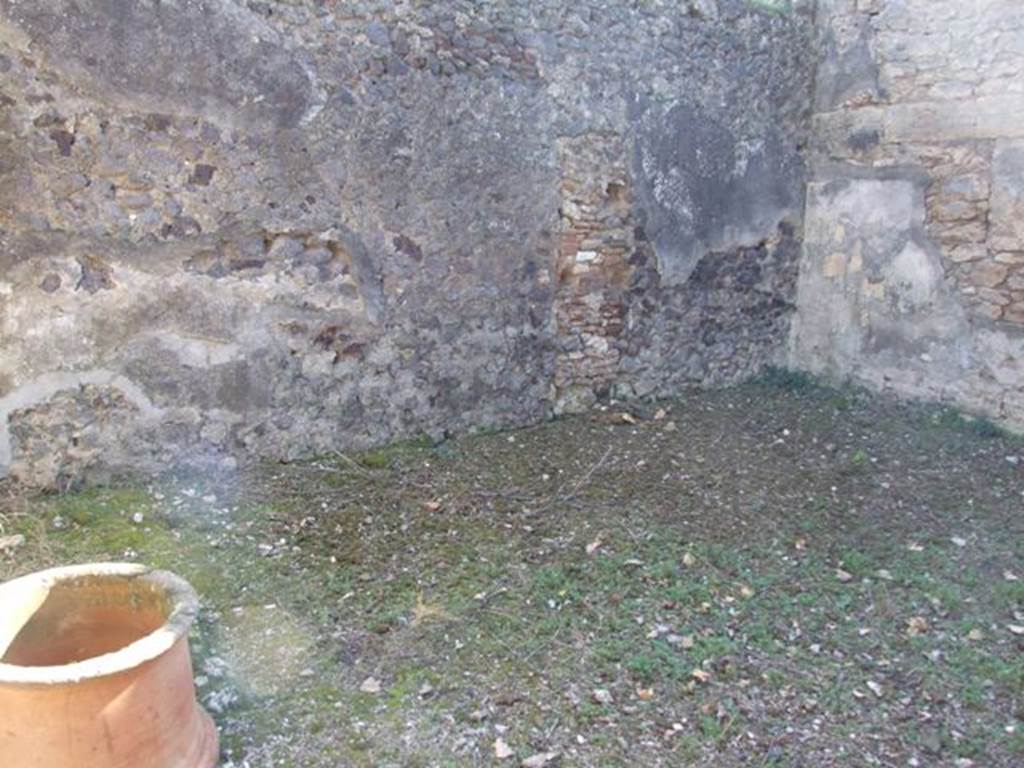
IX.9.11 Pompeii. March 2009. Room 6, garden
area. South wall and south-west corner, with remains of lararium painting.
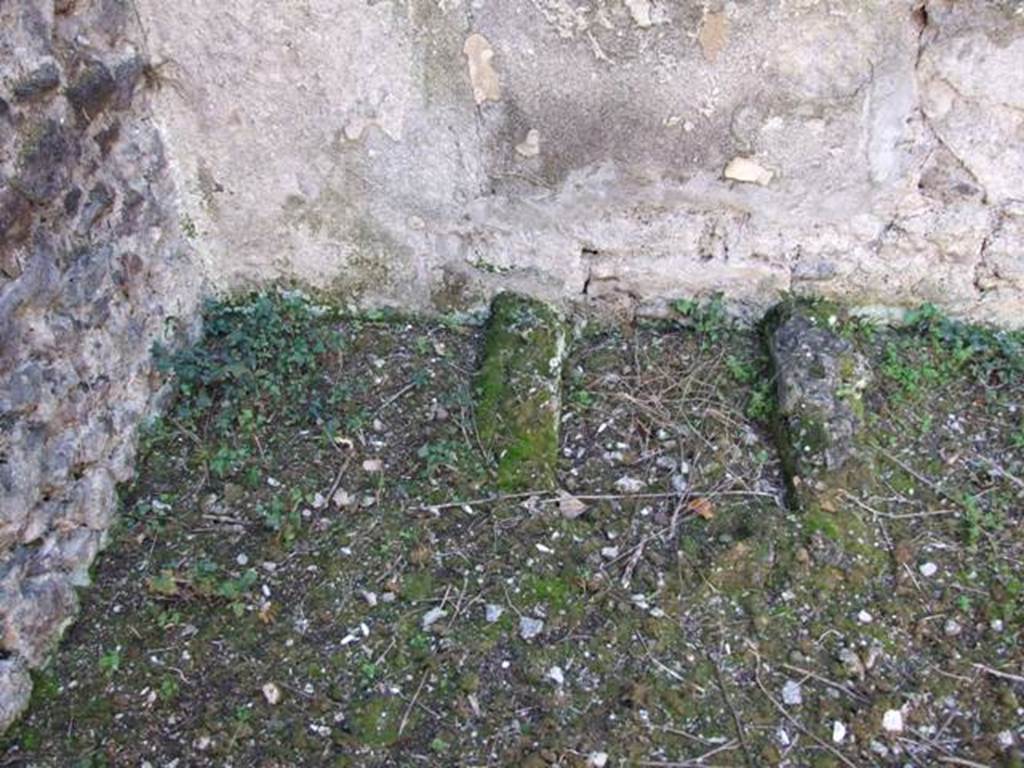
IX.9.11 Pompeii. March 2009. Room 6, garden
area. South-west corner, with a kind of rectangular basin with masonry walls.
Above this basin was an unusual lararium
painting (h.1.60, w.2.15), badly damaged when found.
The lararium included a painting of Bacchus,
a male follower of Bacchus and two maenads, Agave with the head of Pentheus,
and Silenus.
A terracotta pot containing the burnt bones
of animals was found in the basin.
A short distance away, near the south wall,
stood a small altar of travertine (diam.0.27, h.0.28).
See Jashemski, W. F., 1993. The Gardens of Pompeii, Volume II:
Appendices. New York: Caratzas, p. 247.
See Boyce G. K., 1937. Corpus of the Lararia of Pompeii. Rome: MAAR 14. (p. 92, no. 463).
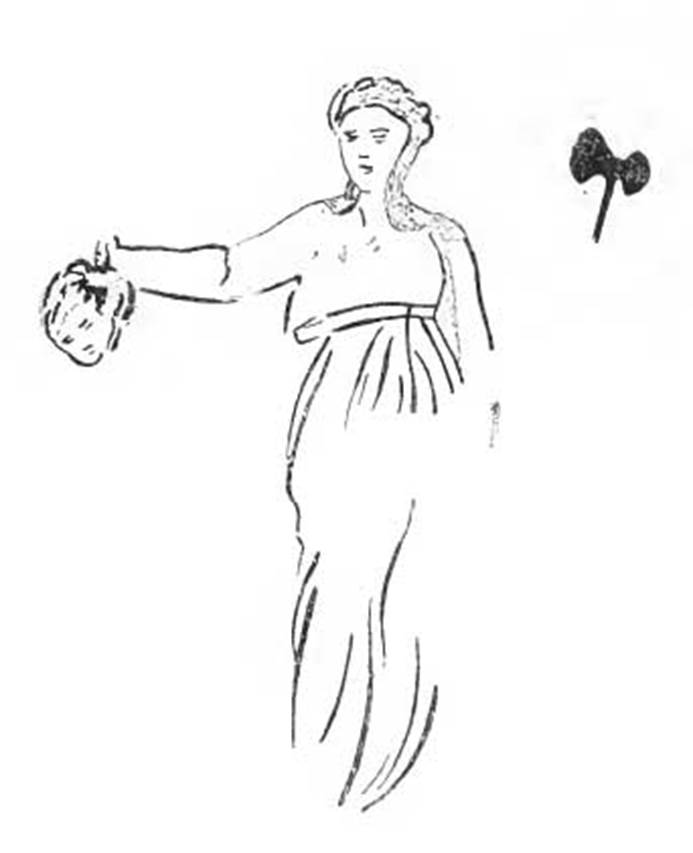
IX.9.11 Pompeii. 1890 drawing of part of the
lararium painting, room 6, garden area.
Agave holds the head of Pentheus in her outstretched
right hand. To her left is an axe.
See Bullettino
dell’Instituto di Corrispondenza Archeologica (DAIR), 1890, p. 251.
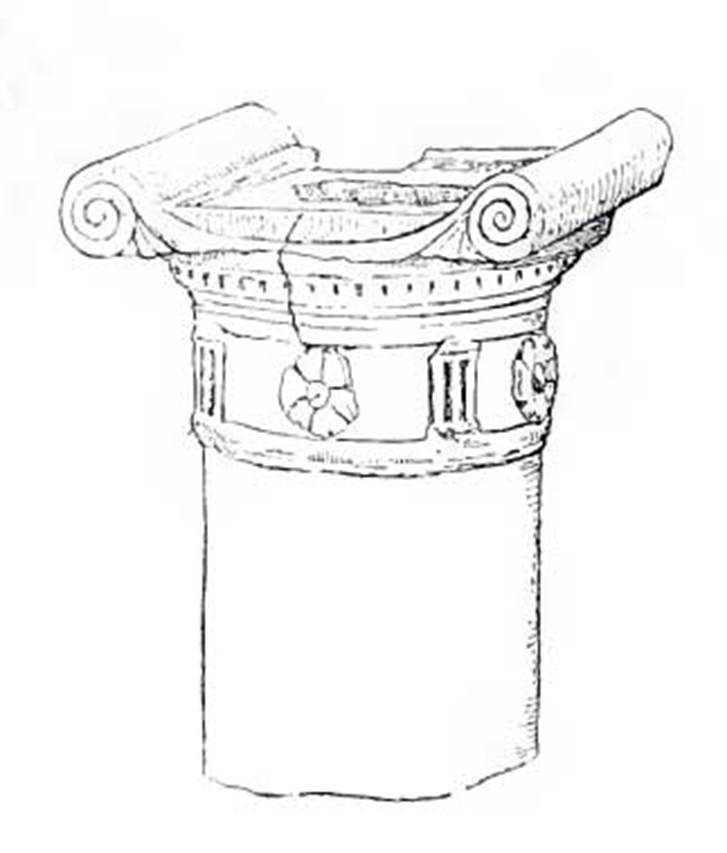
IX.9.11 Pompeii. Room 6, garden area, south
west corner, under the lararium painting.
Drawing of small cylindrical terracotta
altar, the top of which showed signs of burning.
See Bullettino dell’Instituto di Corrispondenza Archeologica (DAIR),
1890, p. 251.
IX.9.12 Pompeii.
Sacrarium built in south-west corner of central courtyard room, no trace remains.
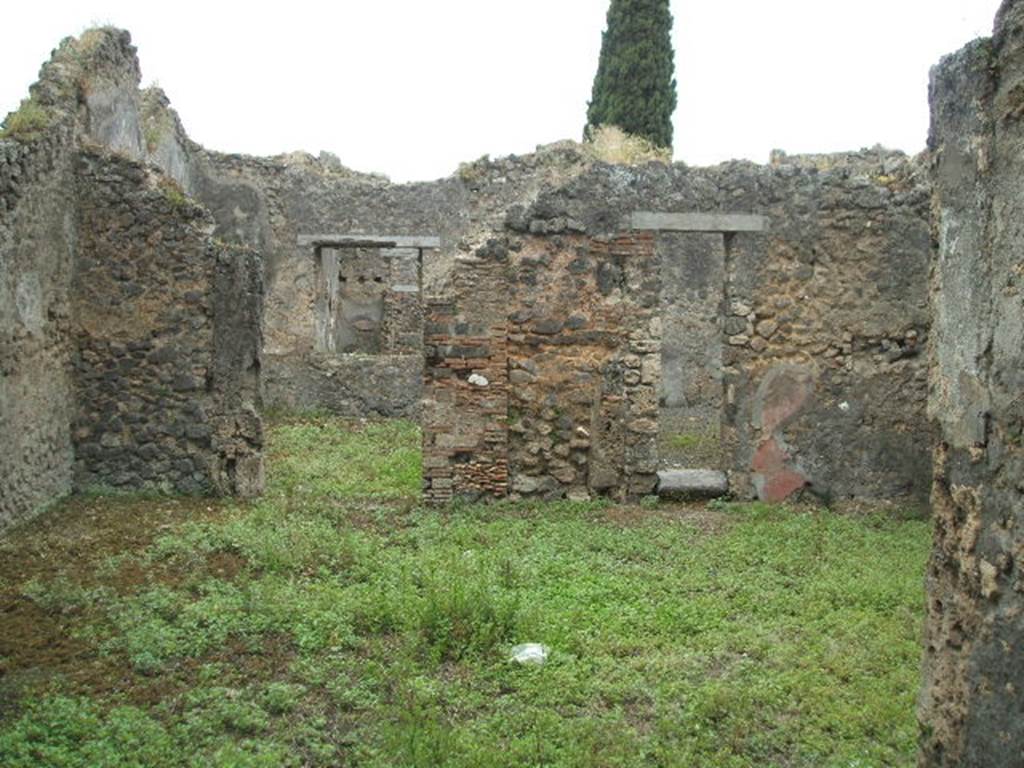
IX.9.12 Pompeii. May 2005. Looking west across room 11, the central courtyard room.
According to Boyce – on the left in the south-west corner a sacrarium was built by running a wall parallel to the south wall, and extending 1.14 from the west wall, and covering the enclosure with a sloping roof (height varies from 1.60 to 2.0).
At the east end of this sanctuary stood a small altar of tufa (0.50 by 0.40, h.0.60) originally coated in stucco.
The inside surface of the north wall is decorated upon a white ground with a line-drawing: an aedicula and within it a male figure, standing clad in a yellow, tunic-like garment, the front of which is white between two red stripes running vertically from shoulder to hem; his flesh is reddish; in his left hand he holds a palm (?) branch at the level of his waist, in his right hand three taeniae; around his head is a fillet. The opposite south wall is also covered with white stucco, the west wall with a coarser variety.
Near the sacellum was found a female head of terracotta (h.0.17) with idealized features, apparently part of a statue.
He quotes reference Not. Scavi, 1889, 136, 1891, 255.
See Boyce G. K., 1937. Corpus of the Lararia of Pompeii. Rome: MAAR 14. (p. 92-3, no.464).
Square niche set into north wall of kitchen.
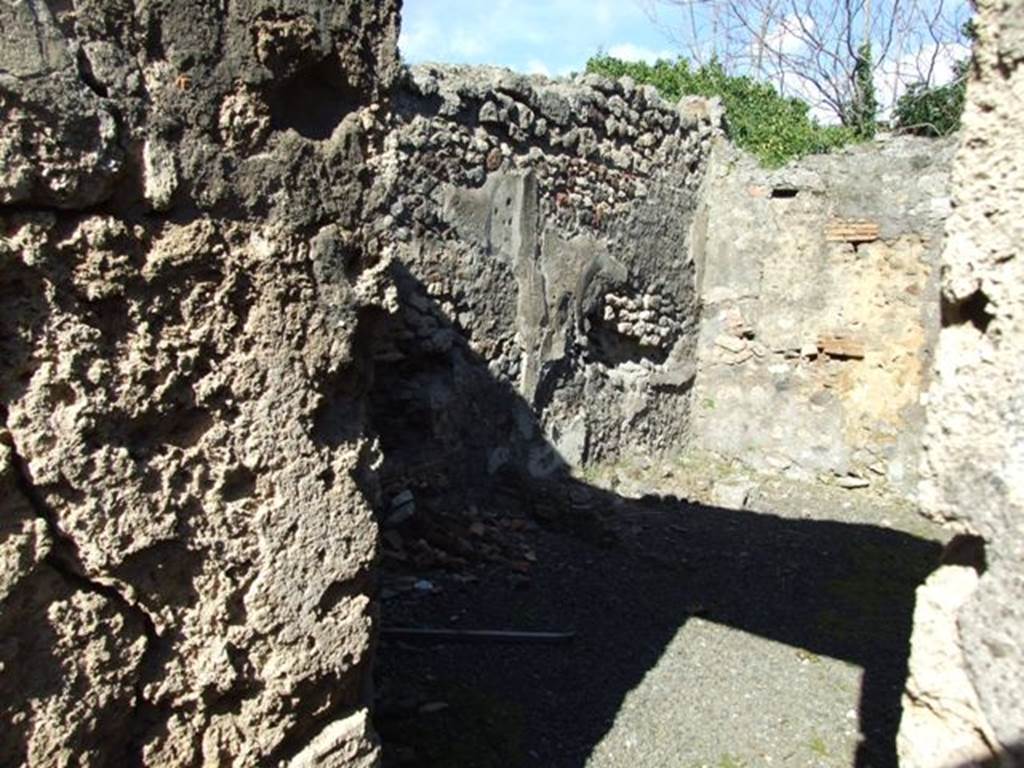
IX.9.12 Pompeii. March 2009. Doorway to room
15, kitchen. Looking east from room 16, the light yard or small courtyard.
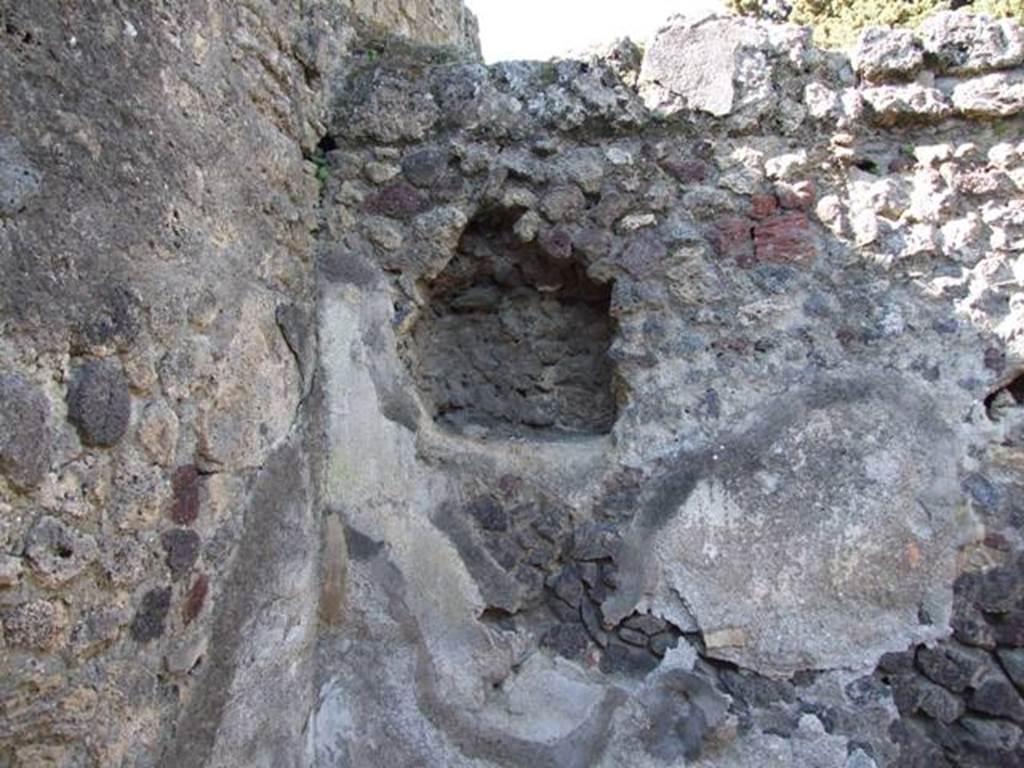
IX.9.12 Pompeii. March 2009. Room 15, remains
of niche in north-west corner of kitchen
According to NdS, on the extreme west of the
north wall of the kitchen was a rectangular niche, protected by a small roof.
Near this was found the usual painted
lararium with Lares, the family Genius sacrificing at the altar, and a tibicin
with double flute.
See Notizie degli Scavi di Antichità, 1891, (p.256).
In
the north wall of the kitchen is a square niche (0.65 square, d.0.25, h. above
floor 1.50), with a projecting tile below.
On
the wall to the right of it are visible traces of a lararium painting: in the
centre, the Genius (h.0.48) with a fold of the toga drawn over his head pours a
libation from a patera upon an altar; behind him is the tibicen (h.0.38); on
each side stands a Lar (h.0.67) in short tunic, a wreath of leaves upon his
head, carrying rhyton and patera.
See
Boyce G. K., 1937. Corpus of the Lararia
of Pompeii. Rome: MAAR 14. (p.93, no.465).
IX.9.13 Pompeii.
Arched niche in west wall of south-west corner of garden, with lararium painting, no trace remains.
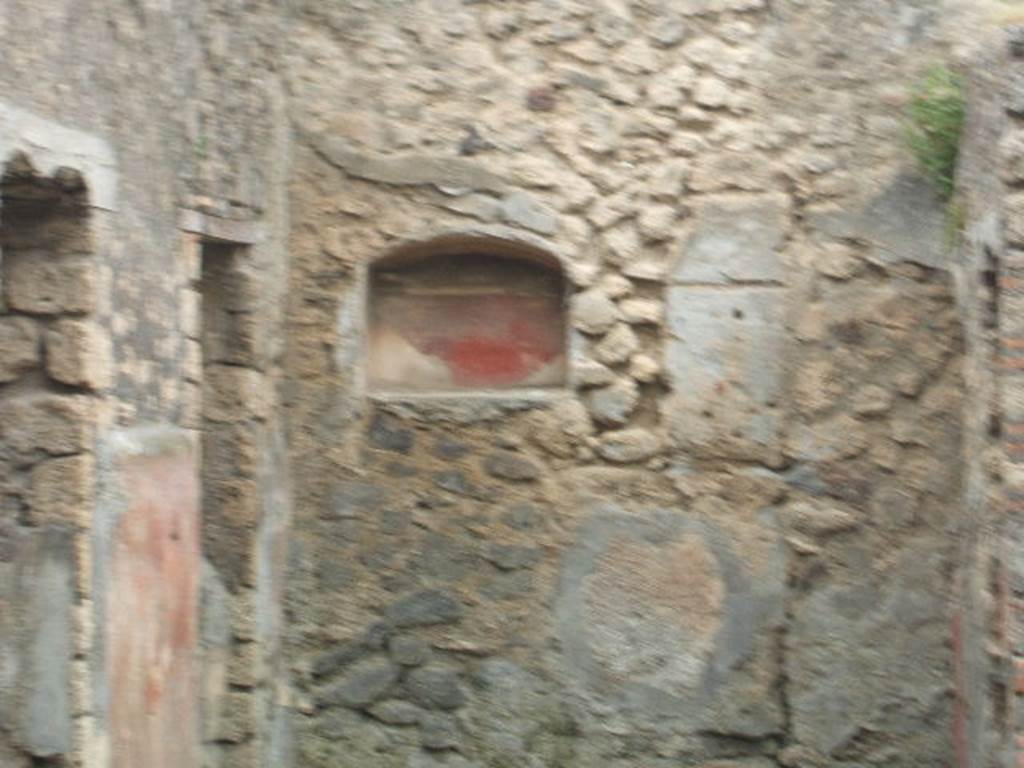
IX.9.13 Pompeii.
May 2005. Room 6, arched niche set in west wall in south-west corner of garden.
According
to Boyce –
On
the wall to the right of the niche was the lararium painting: on the left
stands a tripod of unusual form with a dark coloured vessel upon it. The
Genius, standing to the right, pours a libation upon the tripod; he wears a
wreath of leaves; the toga does not seem to be drawn over hs head as usual,
though the preservation of the painting is poor at this point; he holds no
cornucopia. Behind and to the right stand two figures: in the first plane, a
camillus, also wreathed, and carrying fruit in a shallow dish; above and
farther right, a popa, wreathed and carrying an axe.
To
the left of the Genius are two wreathed figures apparently women, though it is
impossible to be certain, for only the upper portions of their figures are
preserved.
On
the left side of the niche there was not room for painted figures, but on the
adjoining south wall the figure of the Genius appears again, clad in white toga
and pouring a libation upon a yellow cylindrical altar with a fire; he is
unbearded, his flesh is reddish, and in is left hand he holds a yellow
cornucopia.
This
double Genius certainly has some special significance. …….
See
Boyce G. K., 1937. Corpus of the Lararia
of Pompeii. Rome: MAAR 14. (p. 93, no. 466).
See Notizie degli Scavi di Antichità, 1891, p. 258
See Jashemski, W. F., 1993. The Gardens of Pompeii, Volume II:
Appendices. New York: Caratzas. (p. 247).
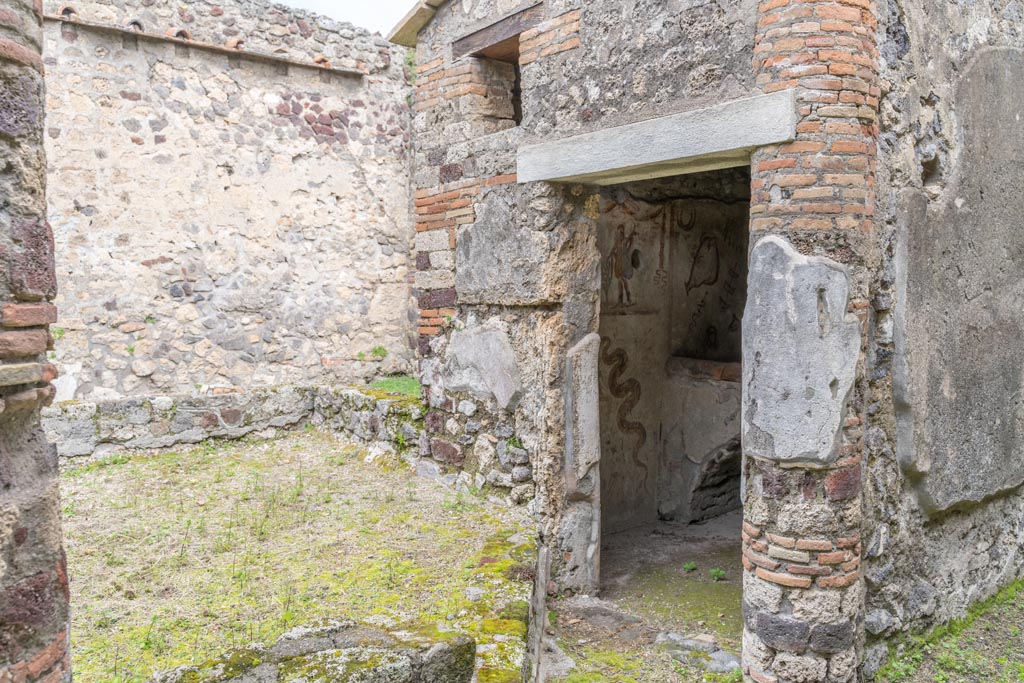
IX.9.13 Pompeii. March 2009.
Lararium arched niche (h.0.50, w.0.65,
d.0.25, h. above floor 1.50) in the south-west corner of room 6, garden.
The walls of the niche were coated with white
stucco bordered in red, its back wall adorned with a stucco cornice.
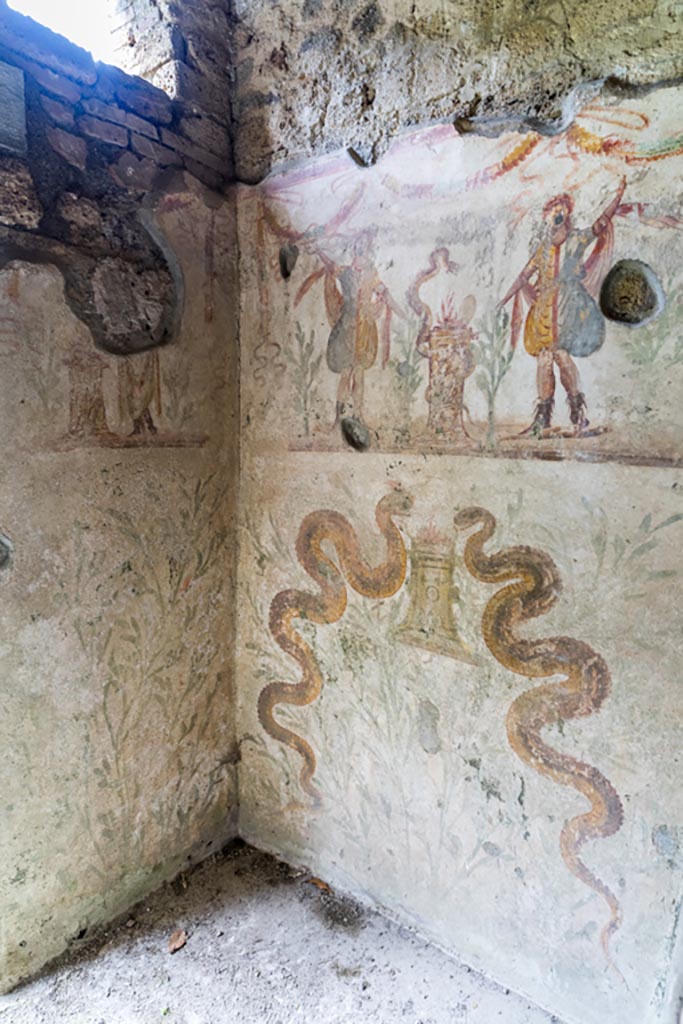
IX.9.13 Pompeii. March 2009. Room 6, detail
of lararium niche.
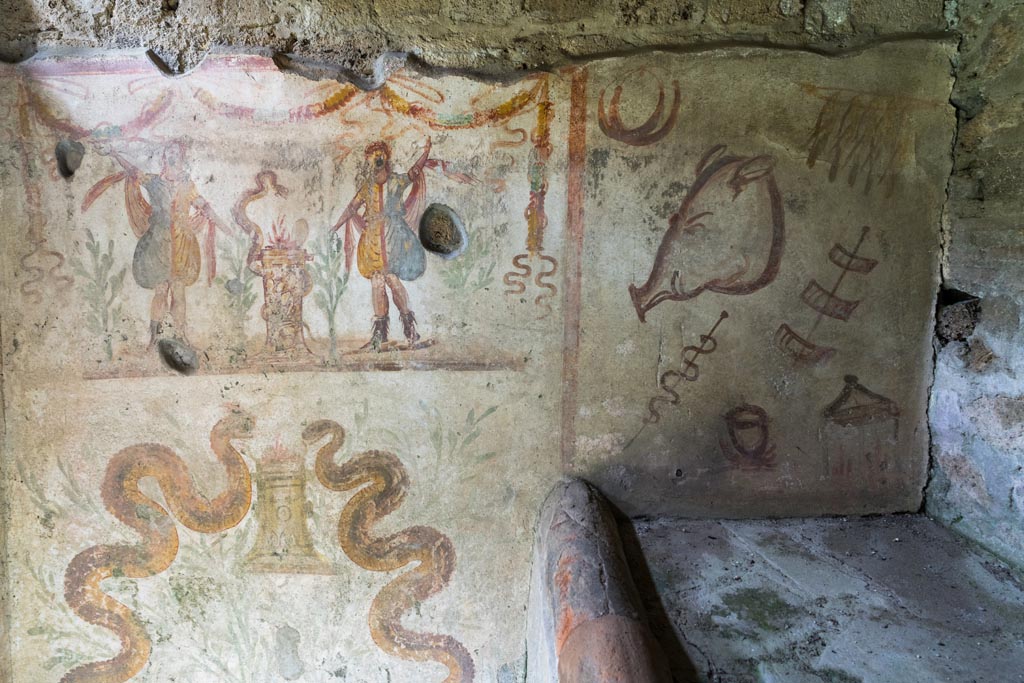
IX.9.13 Pompeii. March 2009. Room 6, detail
of lararium niche.
IX.9.c Pompeii.
Rectangular niche on north side of peristyle.
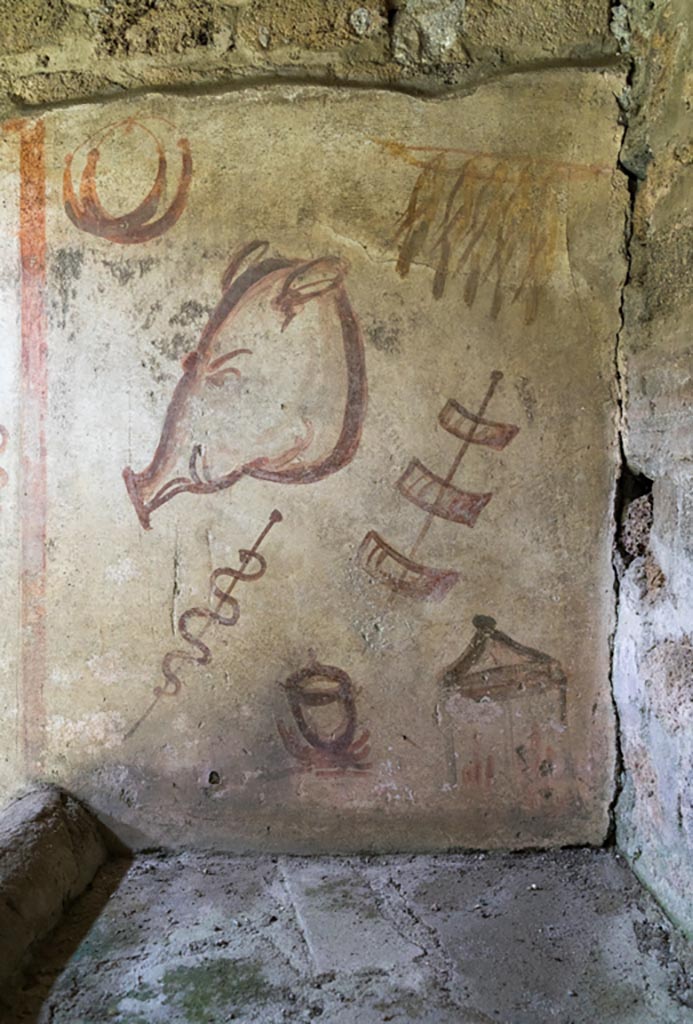
IX.9.c Pompeii. March 2009. North wall of north-west corner of portico.
According to Boyce –
in the pillar that separates two doorways on the north side of the peristyle was a rectangular niche (h.0.30, w.0.28, d.0.20, h. above floor 1.38).
The niche was adorned with a stucco aedicula façade which consisted of two half-columns supporting a pediment.
In the tympanum was a patera upon a bluish background.
Also according to Boyce, a bronze figure of Hygeia seated upon a throne with her feet upon a footstool, was found in a room to the left of the fauces.
On each side of the throne stood a small tree, around which coiled a serpent.
See Boyce G. K., 1937. Corpus of the Lararia of Pompeii. Rome: MAAR 14. (p. 93, no. 467, and Note 4).
Giacobello described it as a pseudo-aedicula
lararium.
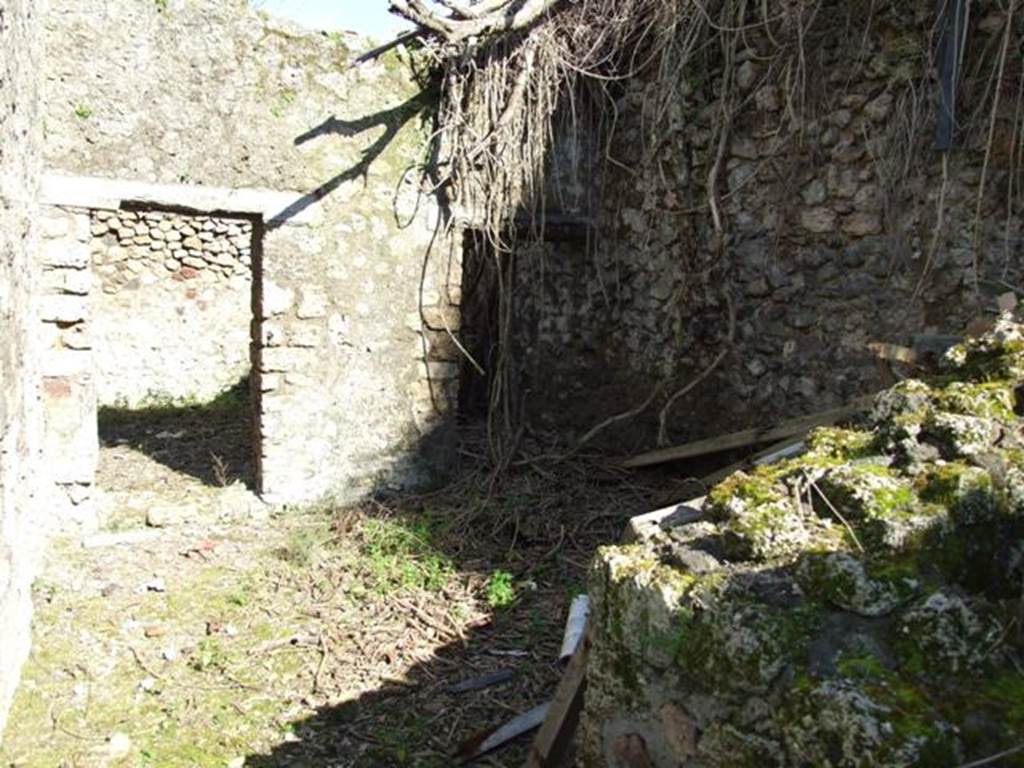
IX.9.c Pompeii. March 2009.
Lararium niche, with remains of aedicula façade on the north wall between two cubicula.
This shows a small portion of the stuccoed half-column and pediment on its east end.
Lararium painting on west and north walls in kitchen.
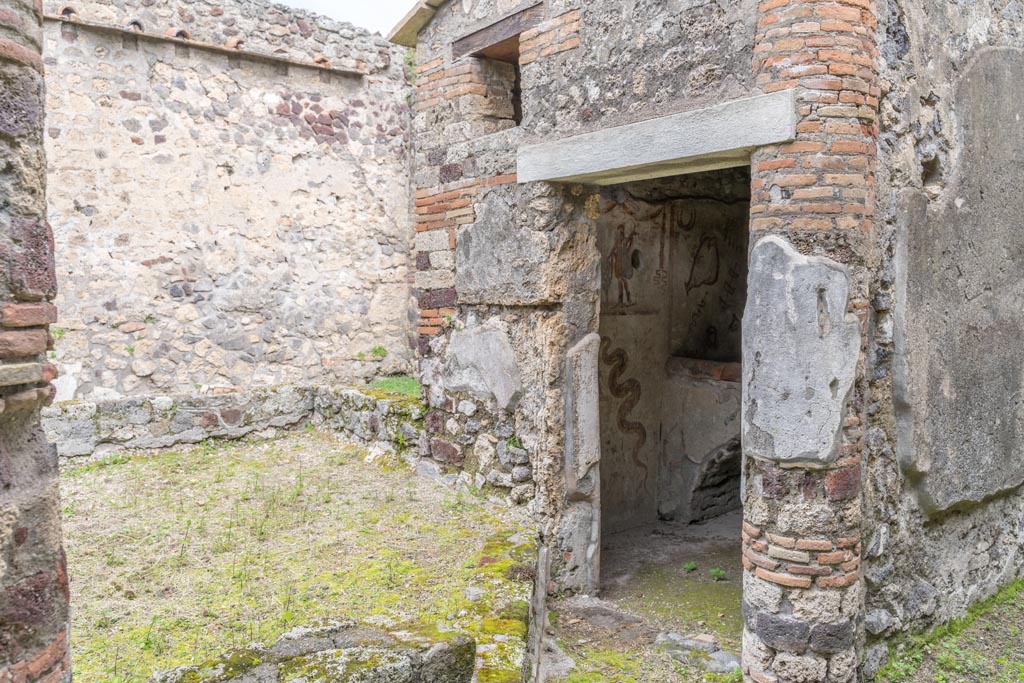
IX.9.c Pompeii. March 2023. Doorway into
kitchen at east end of peristyle/garden. Photo courtesy of Johannes Eber.
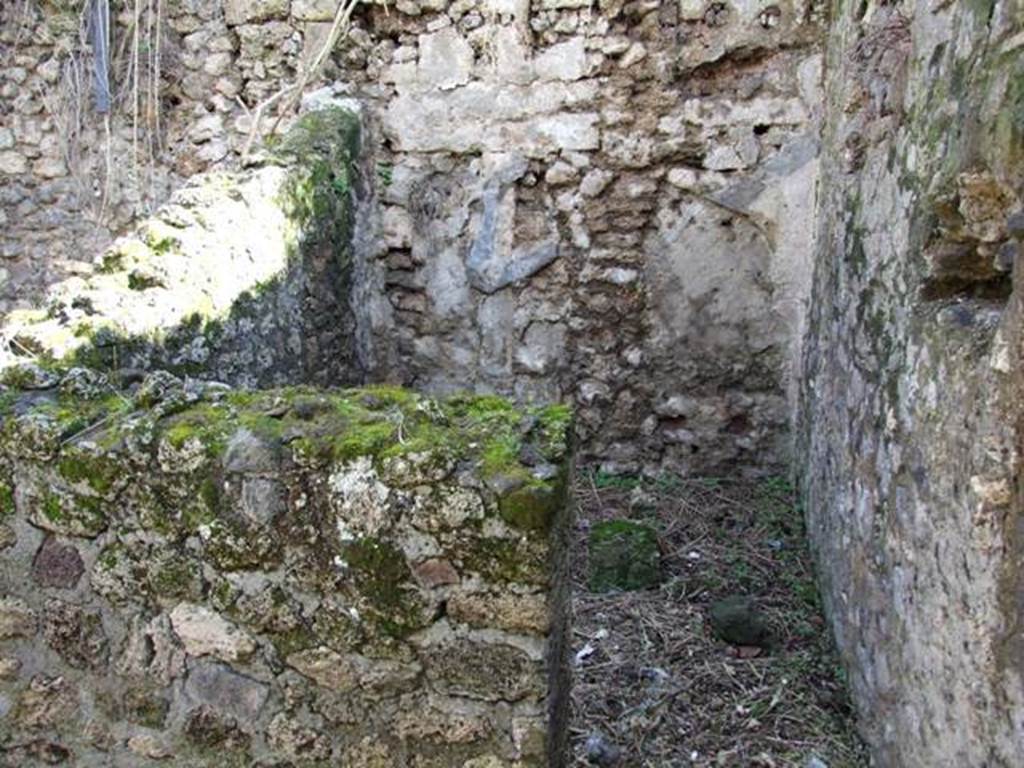
IX.9.c Pompeii. March 2023. Looking
north-east through kitchen doorway. Photo courtesy of Johannes Eber.
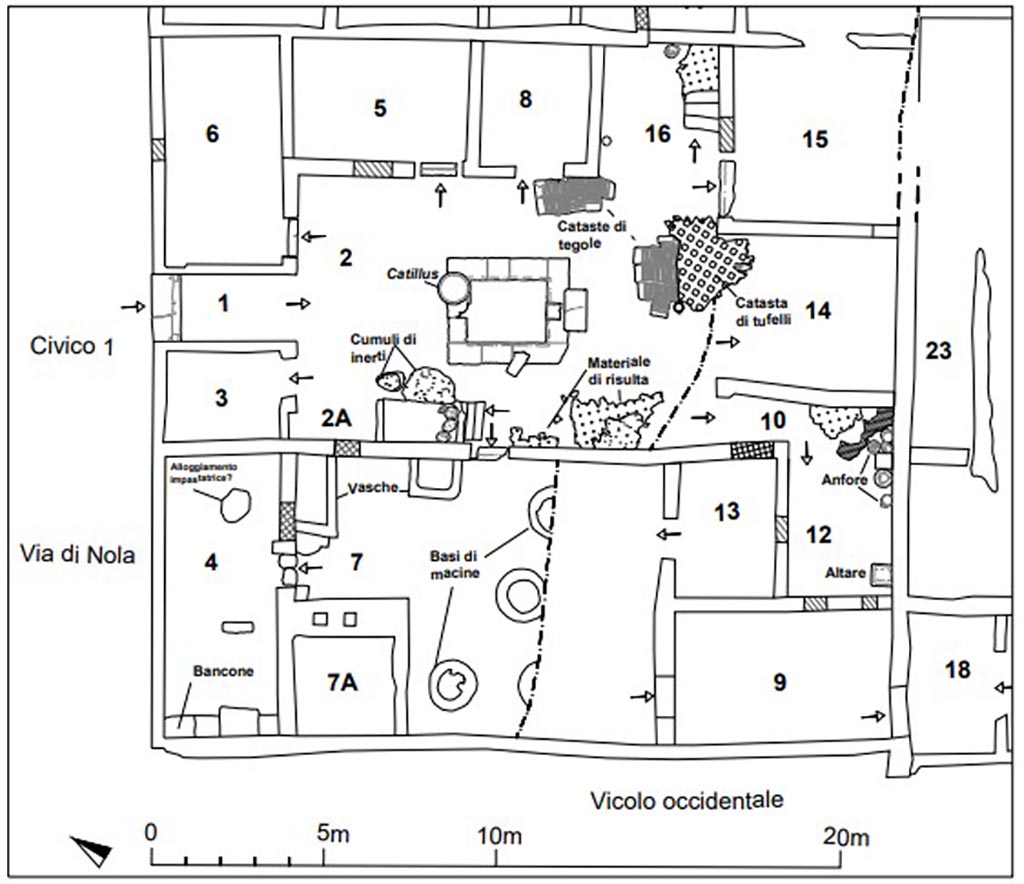
IX.9.c Pompeii. March 2023. North-west corner
of kitchen. Photo courtesy of Johannes Eber.
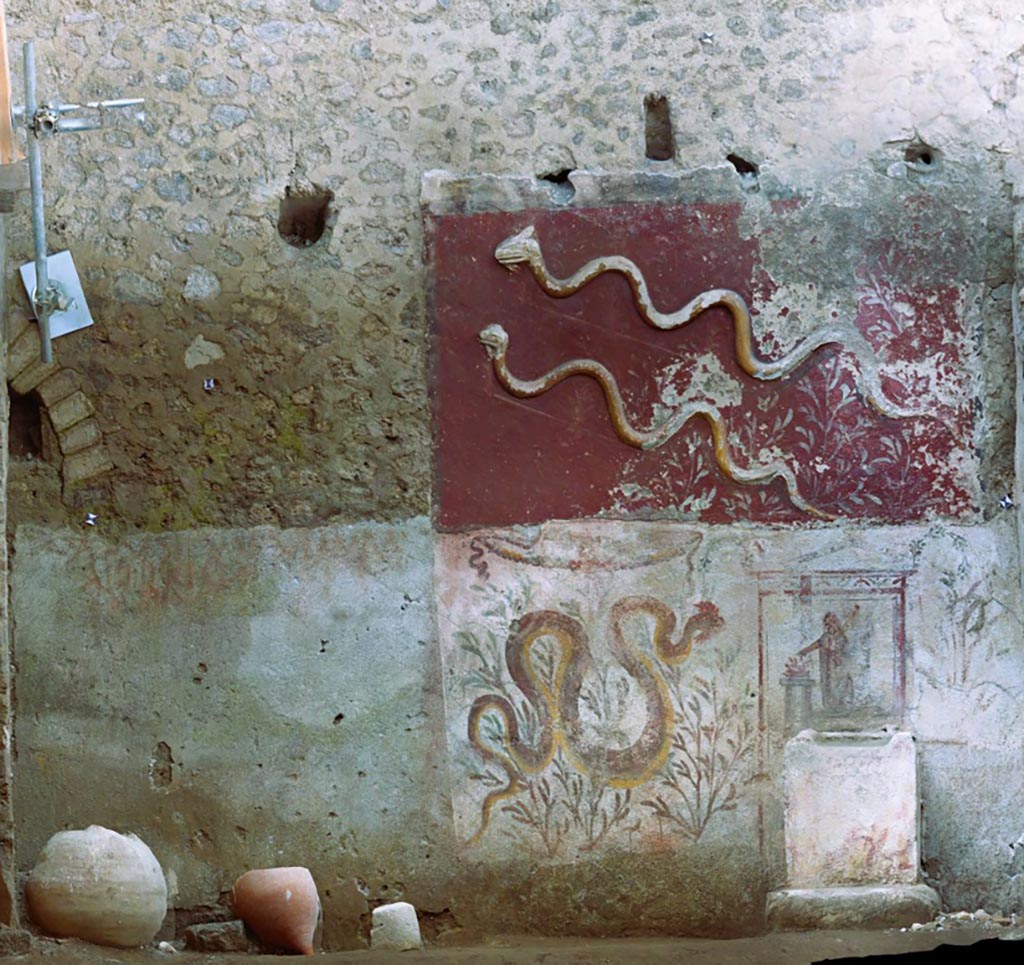
IX.9.c Pompeii. March 2023. Detail of Genius
next to a round altar on west wall of kitchen area. Photo courtesy of Johannes
Eber.
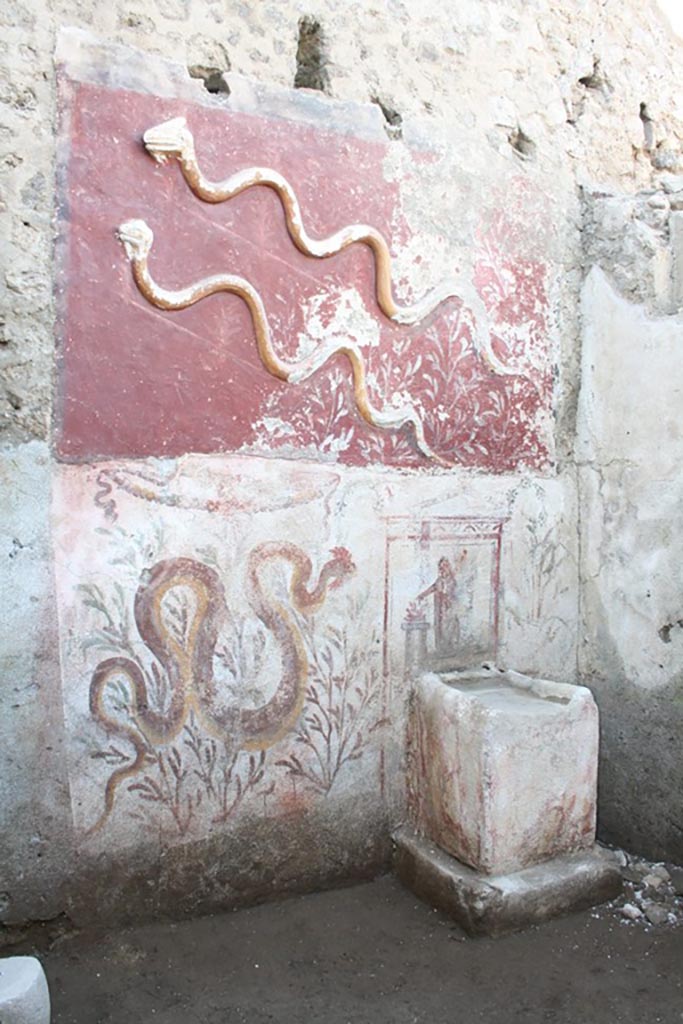
IX.9.c Pompeii. March 2023. North wall of
kitchen with Lararium painting. Photo courtesy of Johannes Eber.
See Boyce G. K., 1937. Corpus of the Lararia of Pompeii. Rome: MAAR 14. (p. 93, no. 468, & Pl. 22,1).
See Fröhlich, T., 1991. Lararien und Fassadenbilder in den
Vesuvstädten. Mainz: von
Zabern. (p.297, L108, Taf. 12, 1-2 & 13,1).
See Giacobello, F., 2008. Larari Pompeiani:
Iconografia e culto dei Lari in ambito domestico. Milano: LED Edizioni,
(p.214, no.111).
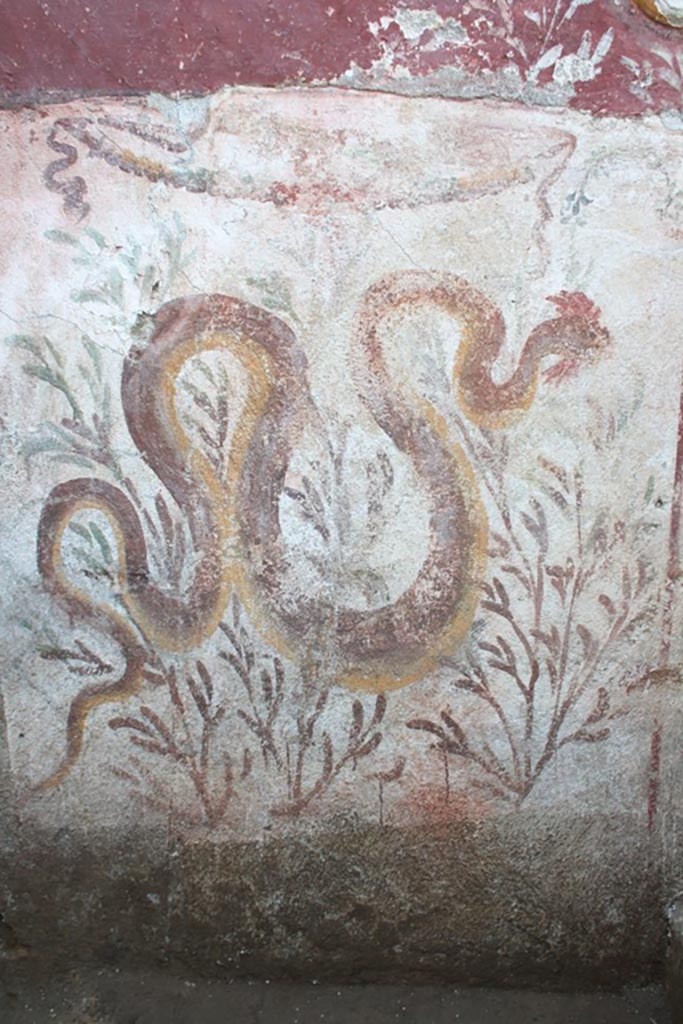
IX.9.c Pompeii. March 2023.
Detail of two Lares either side of a round
altar which has a serpent winding around it. Photo courtesy of Johannes Eber.
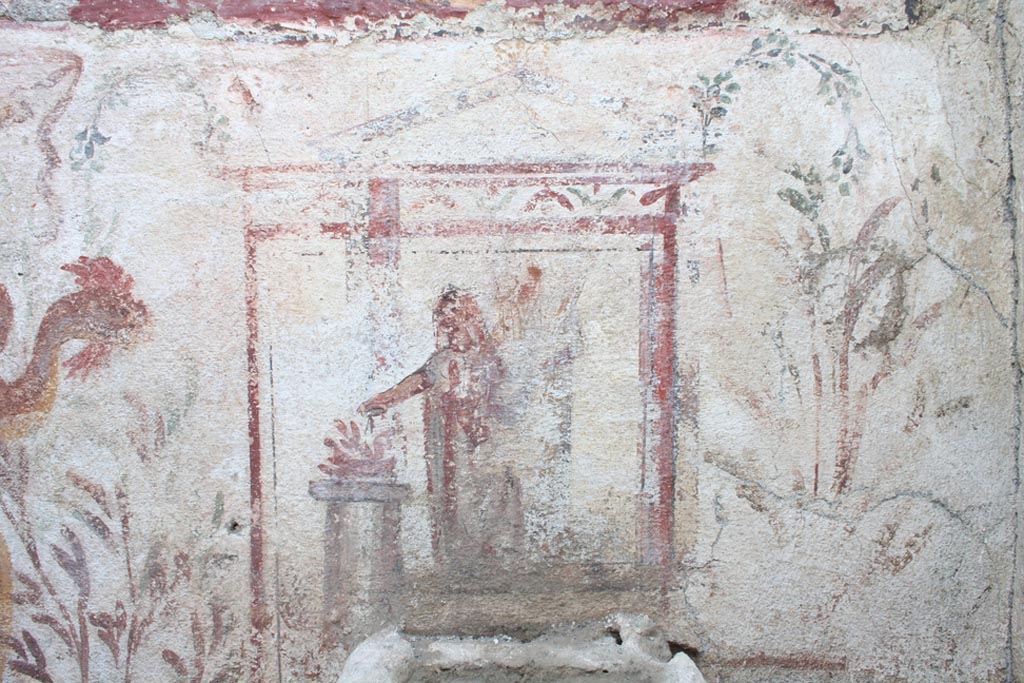
IX.9.c Pompeii. March 2023.
East end of north wall of kitchen, wall
painting of hanging birds, ring sausages, a pig’s head and meat on a stick.
Photo courtesy of Johannes Eber.
IX.9.g Pompeii.
Lararium painting on south wall of kitchen, no trace remains.
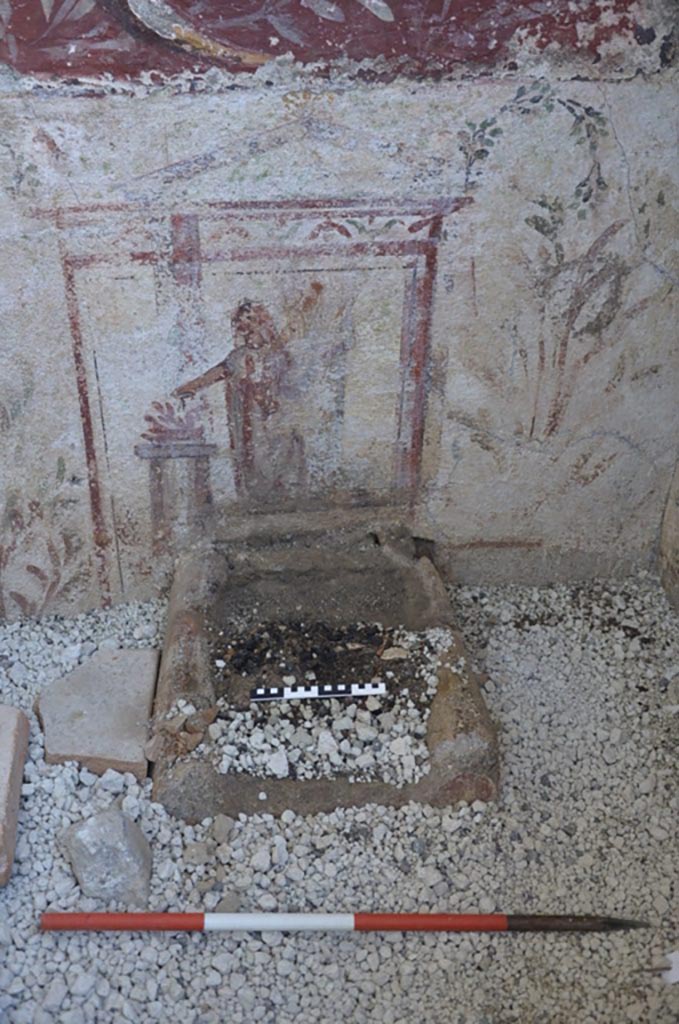
IX.9.g Pompeii. March 2009.
Looking east across small atrium, to doorway
to rustic cubiculum (on left), and area of light-yard, (behind the atrium on
the right).
According to NdS, the atrium was of an
irregular shape.
In the middle of the front of the atrium was
the cistern, the mouth of which was covered by a terracotta puteal.
On the right of the entrance was a cubiculum
with a high window overlooking the roadway.
On the left was the latrine and the base of
the Sarno stone staircase, by which one went up to the upper room and balcony.
Opposite on the east side of the atrium was
another rustic cubiculum.
In the south-west corner of the atrium, a
small hearth protected by a vaulted roof was found.
This kitchen area was formed by the east wall
of the cubiculum, the south wall of the atrium, and the wall of the impluvium.
The impluvium was placed against the south
wall of the atrium.
See Notizie degli Scavi di Antichità, 1891, p.264.
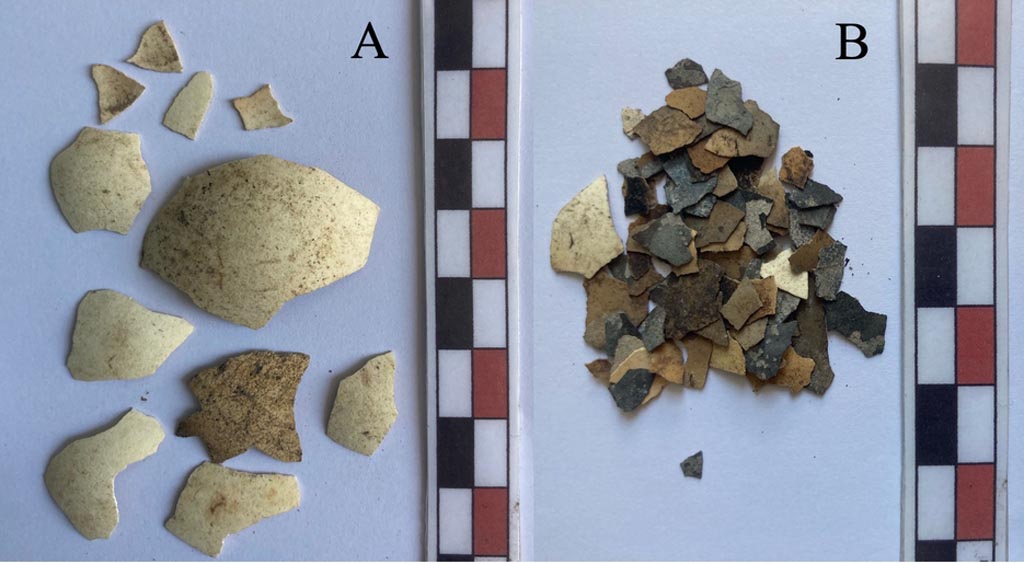
IX.9.g Pompeii. March 2009. Looking south
into doorway into cubiculum on south side of entrance atrium.
On the left would be the east wall of the
cubiculum, and straight ahead would be the south wall.
The small hearth in the kitchen area would
have been in the area behind the east wall, on the left.
Boyce’s west wall would have been the other
side of this “east wall”.
According to Boyce, the hearth stood against
the south wall of the atrium and on the west wall near it was the lararium
painting.
The Genius (h.0.48) stands beside an altar,
holding a cornucopia in his left hand and pouring a libation from a yellow
patera held in his right hand. On the opposite side of the altar is the tibicen
(h.0.40), his foot upon a scabellum. Behind the Genius is a small camillus
(h.0.20), clad in white tunic with two vertical red stripes on his breast, and
holding in his left hand a shallow dish, in his right – taeniae.
On each side of this group is a Lar in
short-girded tunic – green with violet stripes at the neck and down the front,
and a red pallium which passes over his arms and behind his back, and carrying
rhyton and situla. On the right and
higher up is the popa, holding a knife in outstretched right hand, while with
his left he pushes a hog along.
In the lower zone, a crested serpent glides
among plants towards a burning altar.
Finally near the Lar on the right is a dolium
and above it hang festoons.
Found in the cubiculum on the right of the
entrance doorway was a small altar composed of a terracotta cylinder supporting
a square plate of travertine.
See Boyce G. K., 1937. Corpus of the Lararia of Pompeii. Rome: MAAR 14. (p. 94, no. 469)
According to Giacobello, on the south wall of
kitchen (e) was a lararium painting (not conserved).
Perhaps this does not apply to this house, as
it is headed IX.9.7, (IX.9.g?)
See Giacobello, F.,
2008. Larari Pompeiani: Iconografia e
culto dei Lari in ambito domestico. Milano: LED Edizioni. (p.216,
no.112).
IX.10.1 Pompeii.
Lararium and altar recently found in room 12.
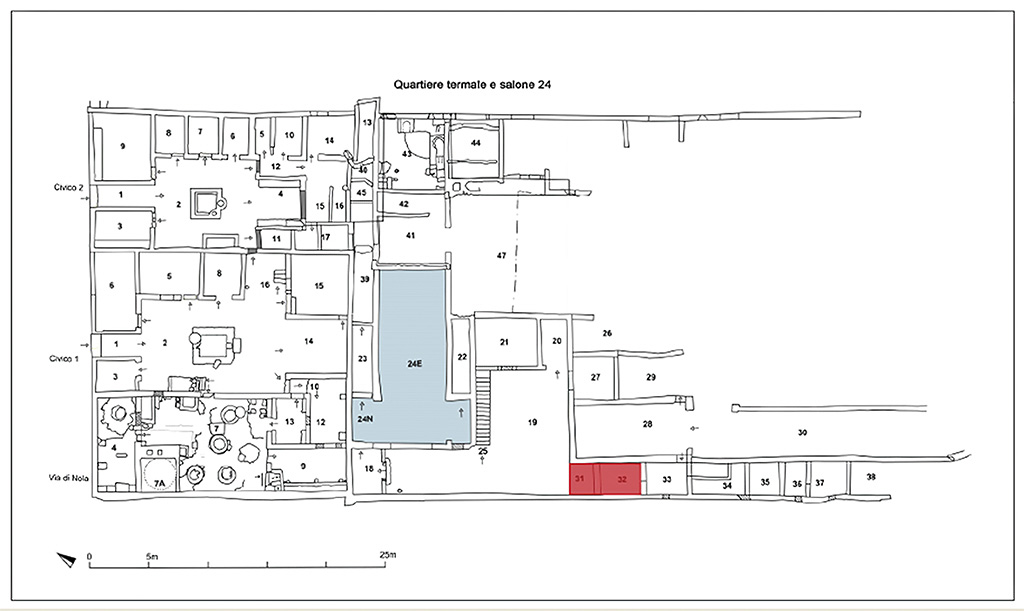
IX.10.1 Pompeii. Lararium and altar recently found in room 12. 2023 plan showing location of altar.
Room 12 of House IX, 10, 1, located to the southwest of the atrium, is accessible through a narrow corridor (10) that originally led to a now blocked doorway into the southern sector of the house. The extensive restoration and redistribution of the rooms of the dwelling and the internal routes to reach the individual functional sectors of the dwelling also affected this small rectangular space, possibly open at the time of the eruption, in which three windows open on the north and west walls to illuminate the adjoining rooms (13 and 9). Standing on the south wall is a large lararium found in an excellent state of preservation and with the burnt remains of the last offerings still in place (see below).
Planimetria dopo i recenti scavi del 2023 che mostra la posizione
dell'altare nella sala 12.
L’ambiente 12 della casa IX, 10, 1, posto a sud ovest dell’atrio, è
accessibile da uno stretto corridoio (10) che in origine conduceva ad una porta
tamponata, che immetteva nel settore meridionale della casa. I consistenti
lavori di restauro e ridistribuzione degli ambienti della dimora e dei percorsi
interni per raggiungere i singoli settori funzionali della stessa hanno
interessato anche questo piccolo spazio rettangolare, forse a cielo aperto al
momento dell’eruzione, in cui si aprono sulle pareti nord ed ovest tre finestre
per illuminare gli ambienti attigui (13 e 9). A campeggiare sulla parete sud è
un grande larario ritrovato in ottimo stato di conservazione e con i resti
combusti delle ultime offerte ancora al loro posto (cfr. infra).
See PAP e-journal 6, 28.09.2023, p. 61, fig.
1. Download:
PAP e-journals 2023 collection volumes
01-09
Photograph
© Parco Archeologico di Pompei.
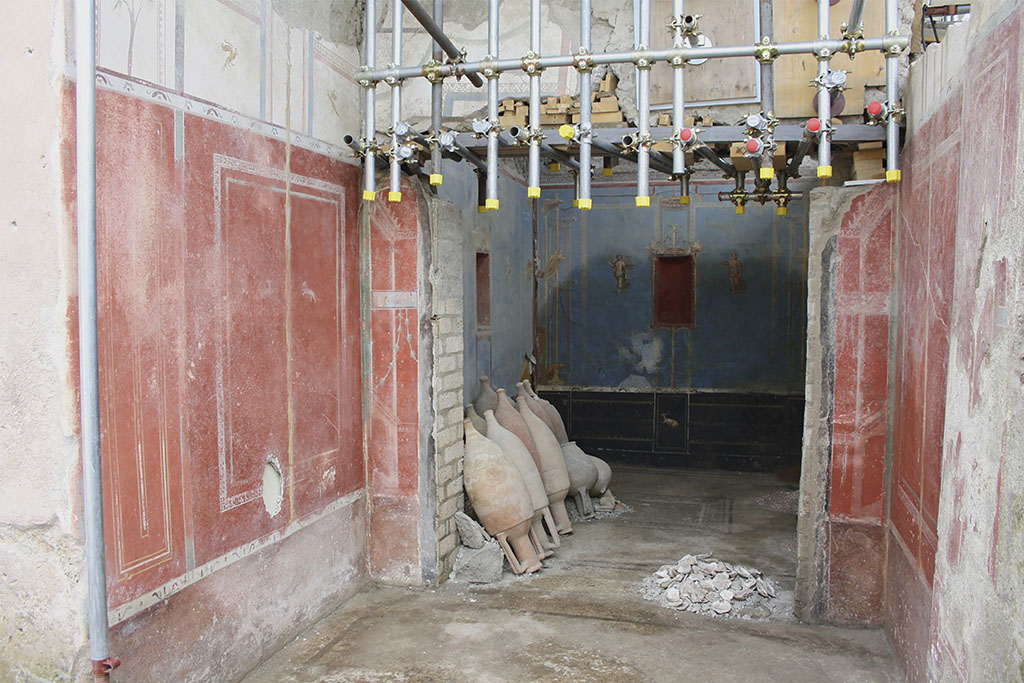
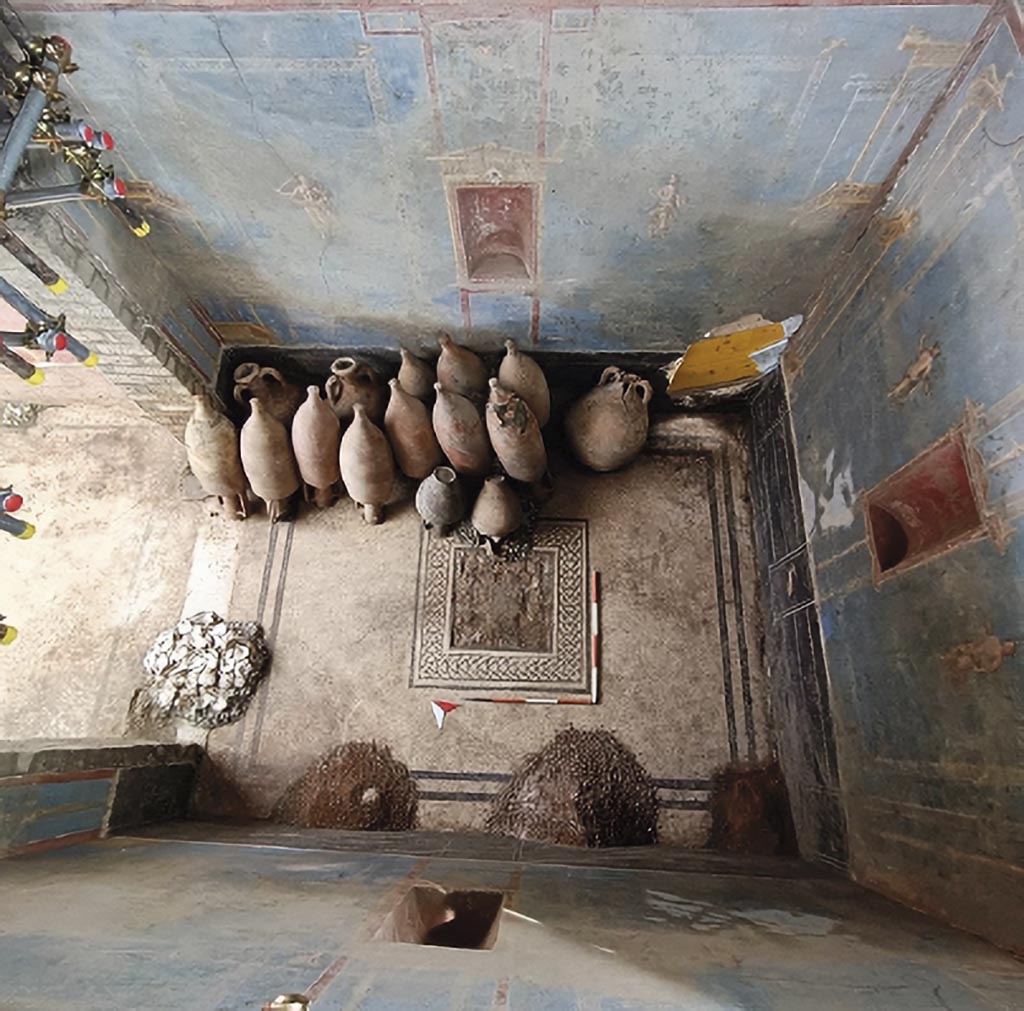
IX.10.1 Pompeii. Lararium and altar recently
found in room 12. Photo of the south wall of the lararium (12).
The lararium is structured on two
superimposed registers with an upper register decorated with stucco and a lower
register decorated with frescoes.
Fotopiano della parete sud del larario (12).
La rappresentazione è strutturata su due registri sovrapposti con un registro
superiore decorato a stucco ed uno inferiore decorato ad affresco.
See PAP e-journal 6, 28.09.2023, p. 64, fig.
10. Download:
PAP e-journals 2023 collection volumes
01-09
Photograph
© Parco Archeologico di Pompei.
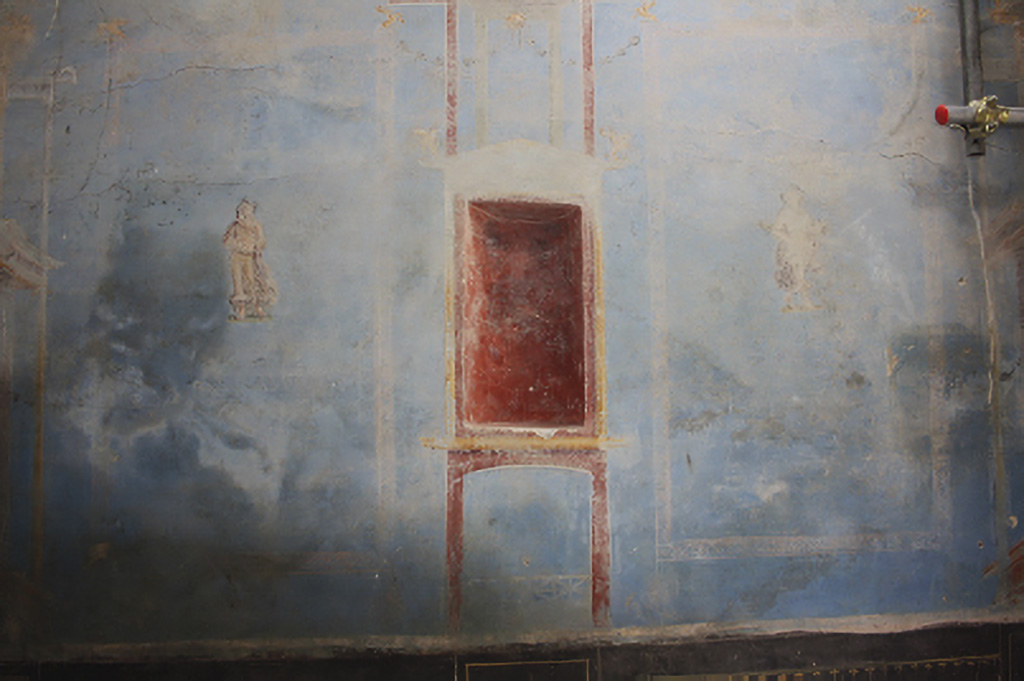
Room 12, altar and lararium at west end of south wall. Photo courtesy of Johannes Eber.
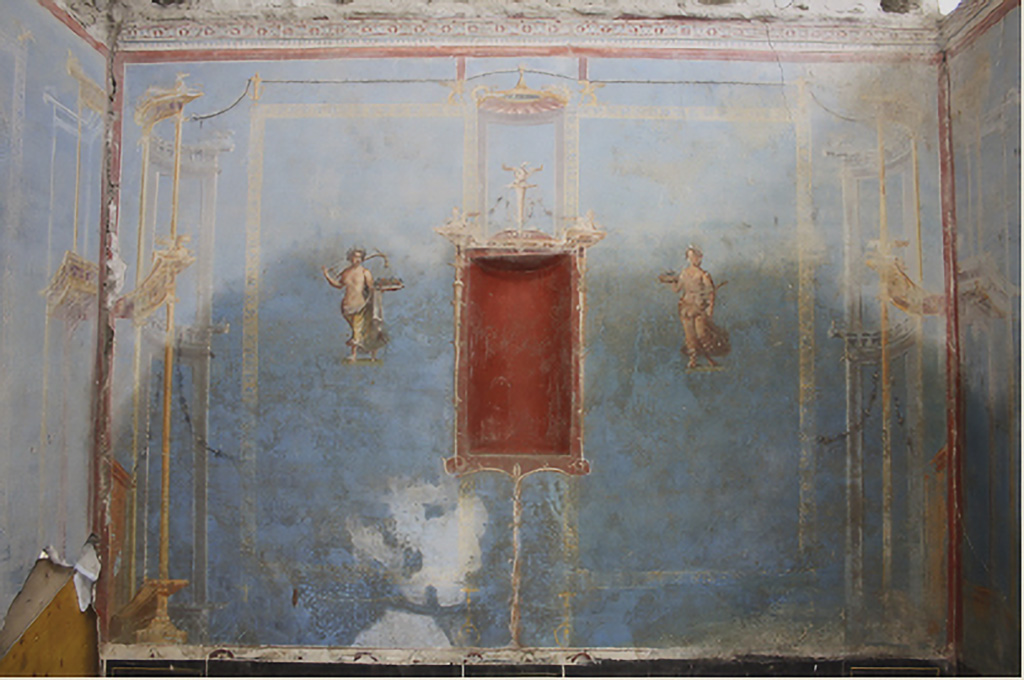
Room 12, lararium and painted altar at west end of south wall. Photo courtesy of Johannes Eber.
The lower register consists of a white background into which the masonry pulvinus altar decorated in fresco with brown faux-marble highlights is inserted. On the left side there is a fresco of a crested and bearded serpent heading towards the altar, which is surmounted by a painted rectangular aedicule terminating in vegetal whorls, and which frames the Genius patris familias with cornucopia and patera making libations at a circular altar.
The partial deterioration of the painted plaster base on which the scenes of the last phase are laid reveals, in a position off-centre from the previous one, a similar scene belonging to an older decorative phase.
Il registro inferiore è costituito da una specchiatura a fondo bianco (1,55
x 2,20 m) in cui si inserisce l’altare a pulvino in muratura (0,75 x 0,50 m)
decorato ad affresco con lumeggiature brune a finto marmo. Sulla sinistra è
affrescato un serpente crestato e barbato che si dirige verso l’altare (Fig.
12), sormontato da un’edicola rettangolare dipinta e terminante in girali
vegetali, che inquadra il Genius patrisfamilias con cornucopia e patera che
compie libagioni presso un altare circolare (Fig. 13). La parziale consunzione
della base pittorica a grassello di calce su cui sono stese le scene di ultima
fase lascia intravedere, in posizione decentrata rispetto alla precedente, una
scena simile appartenente ad una fase decorativa più antica.
See PAP e-journal 6, 28.09.2023, p. 64, fig.
11. Download:
PAP e-journals 2023 collection volumes
01-09
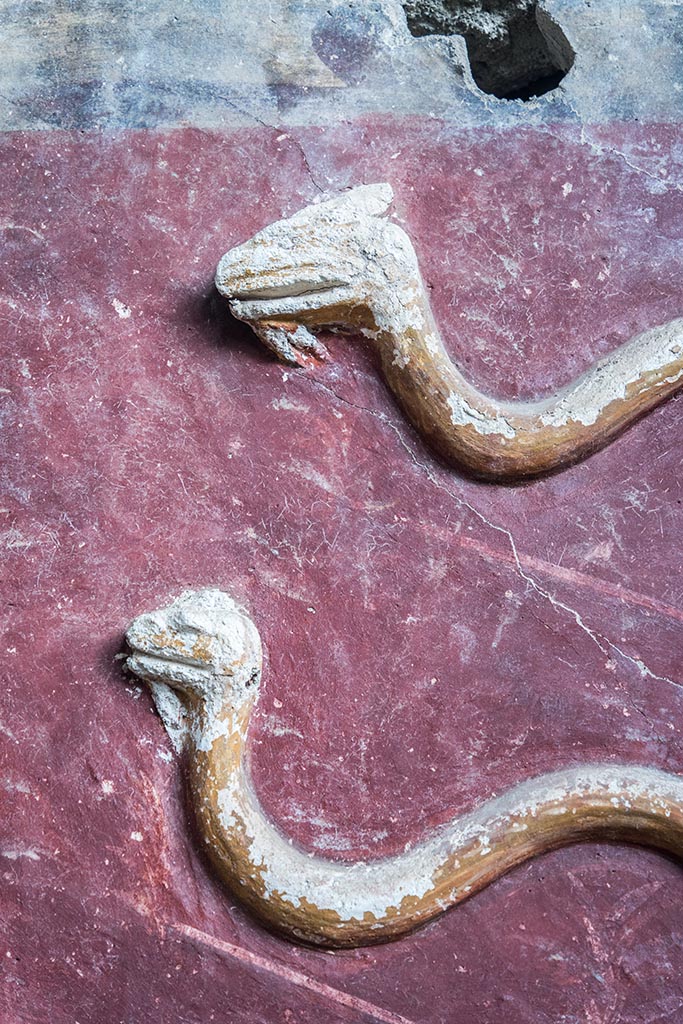
IX.10.1, Pompeii. July 2024.
Room 12, detail of stucco serpents from centre of upper south wall. Photo courtesy of Johannes Eber.
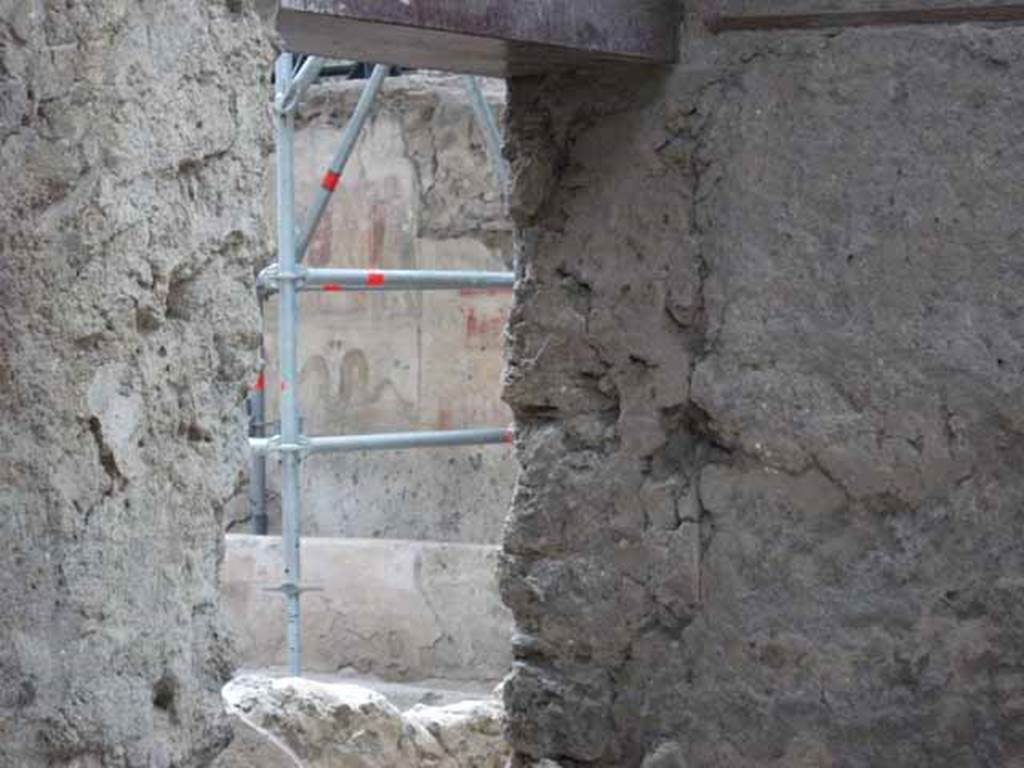
Stucco snakes from the
upper register.
The upper register
consists of a red background (1.30 x 2.10 m) surrounded by brown, in which two
crested and bearded snakes are represented in stucco relief, among shrubs.
Serpenti in stucco dal registro superiore.
Il registro superiore è costituito da una
specchiatura a fondo rosso (1,30 x 2,10 m) contornata di bruno, in cui sono
rappresentati in rilievo di stucco due serpenti crestati e barbati, tra
arbusti.
See PAP e-journal 6, 28.09.2023, p. 65, fig.
15. Download:
PAP e-journals 2023 collection volumes 01-09
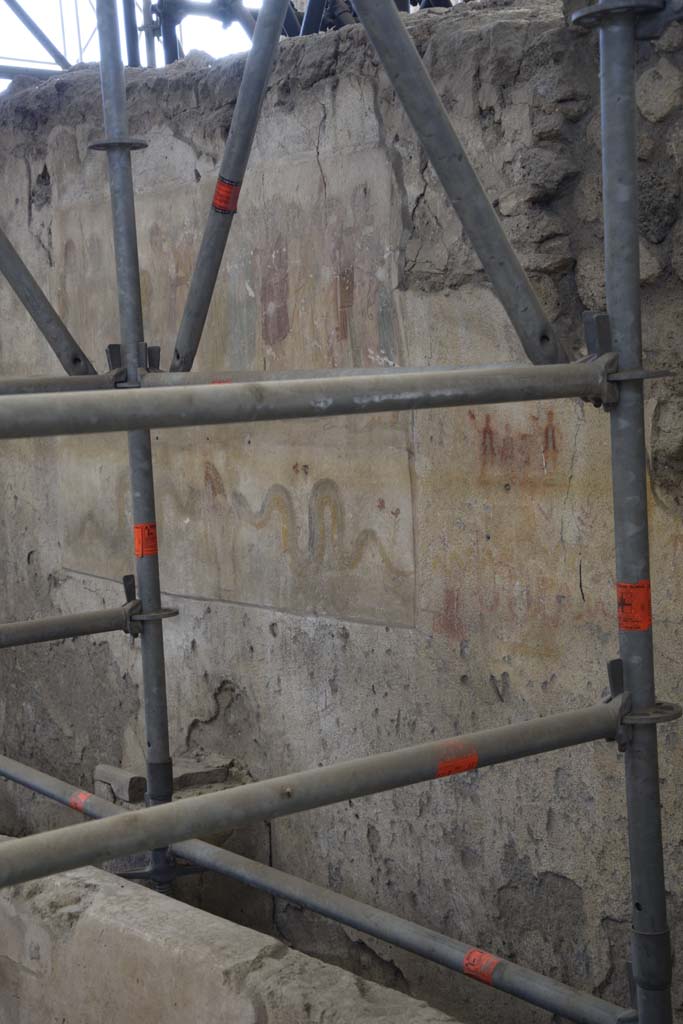
Snake in the lower register.
On the left side there is a fresco of a crested and bearded serpent heading towards the altar.
Serpente nel registro inferiore.
Sulla sinistra è affrescato un serpente crestato e barbato che si dirige
verso l’altare.
See PAP e-journal 6, 28.09.2023, p. 65, fig.
12. Download:
PAP e-journals 2023 collection volumes
01-09
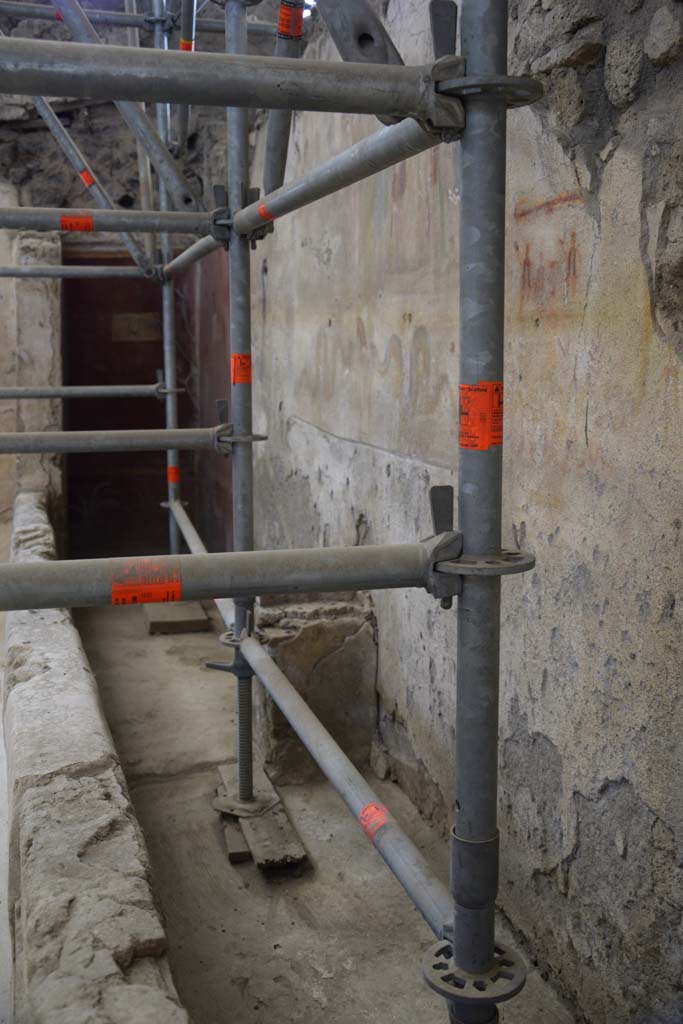
IX.10.1, Pompeii. July 2024.
Room 12, altar and painted lararium at west end of south wall. Photo courtesy of Johannes Eber.
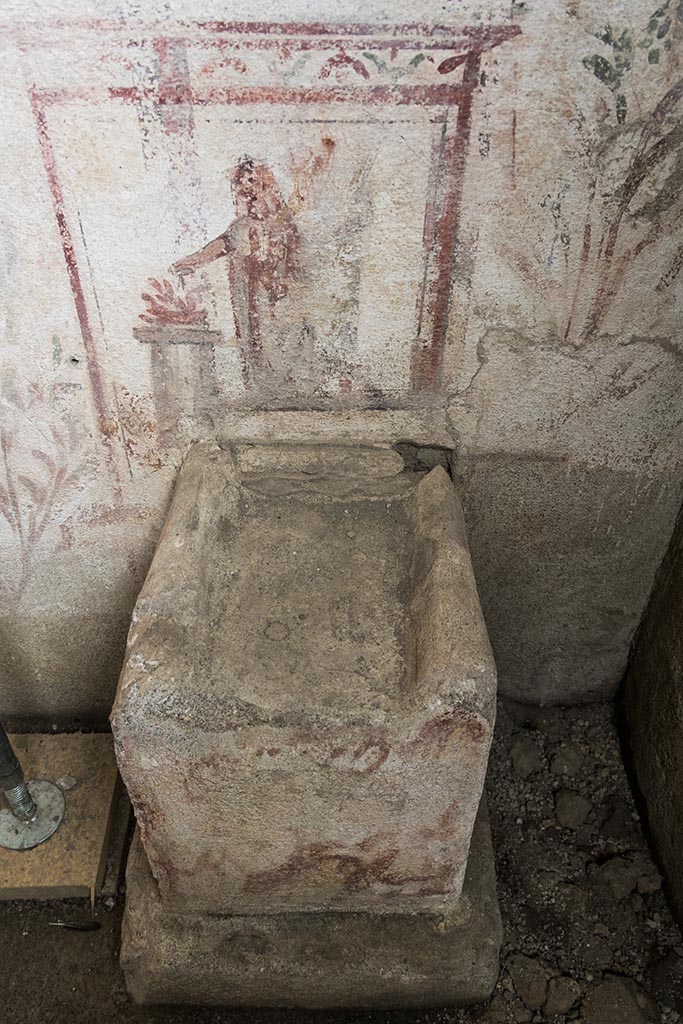
IX.10.1, Pompeii. July 2024. Room 12, lararium and altar. Photo courtesy of Johannes Eber.
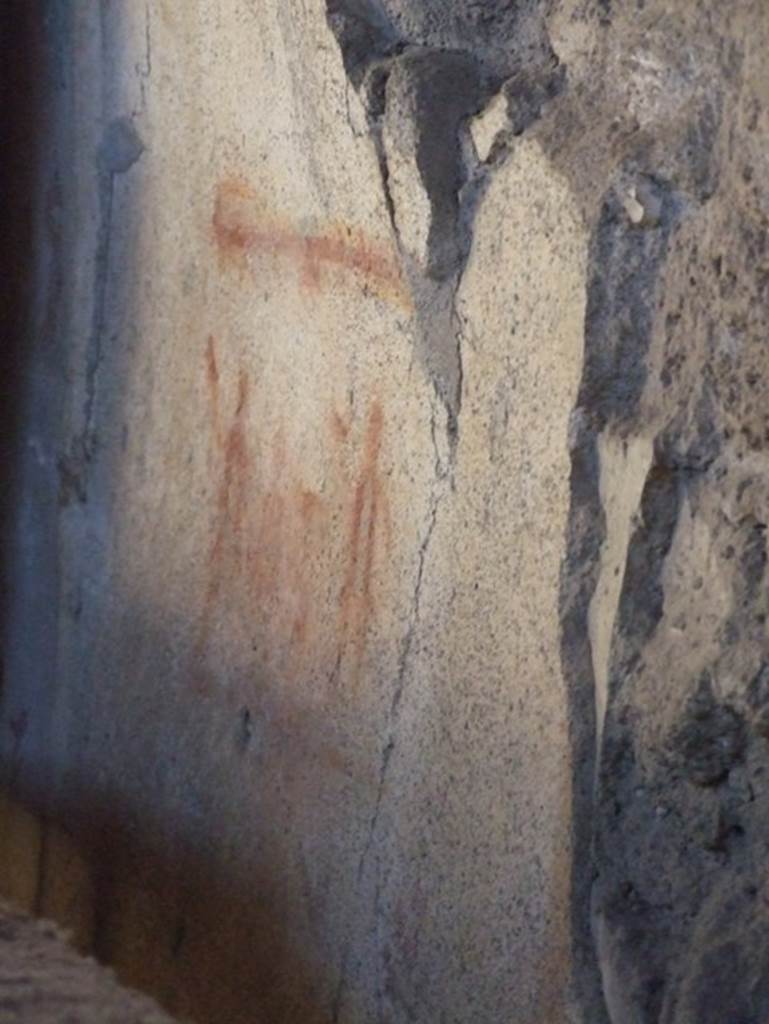
Room 12, south wall, detail of painted lararium. Photo courtesy of Johannes Eber.
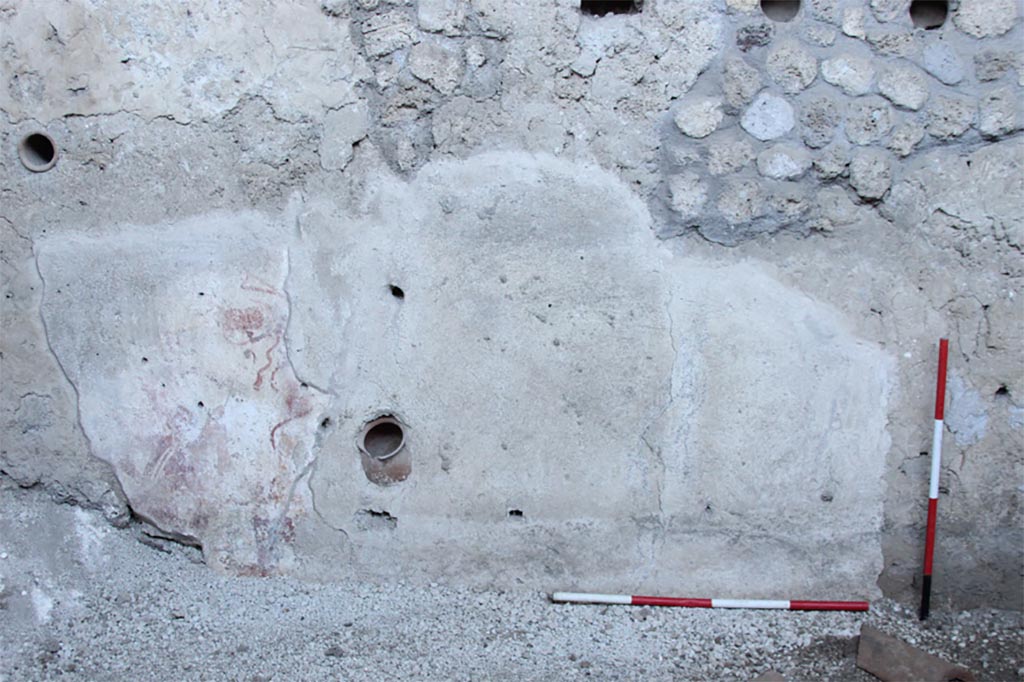
IX.10.1, Pompeii. July 2024.
Room 12, south wall, painted lararium above altar. Photo courtesy of Johannes Eber.
The altar is surmounted by a painted rectangular aedicule terminating in vegetal whorls, and which frames the Genius patris familias with cornucopia and patera making libations at a circular altar.
L’altare è sormontato da un’edicola rettangolare dipinta e terminante in
girali vegetali, che inquadra il Genius patrisfamilias con cornucopia e patera
che compie libagioni presso un altare circolare.
See PAP e-journal 6, 28.09.2023, p. 65, fig.
14. Download:
PAP e-journals 2023 collection volumes
01-09
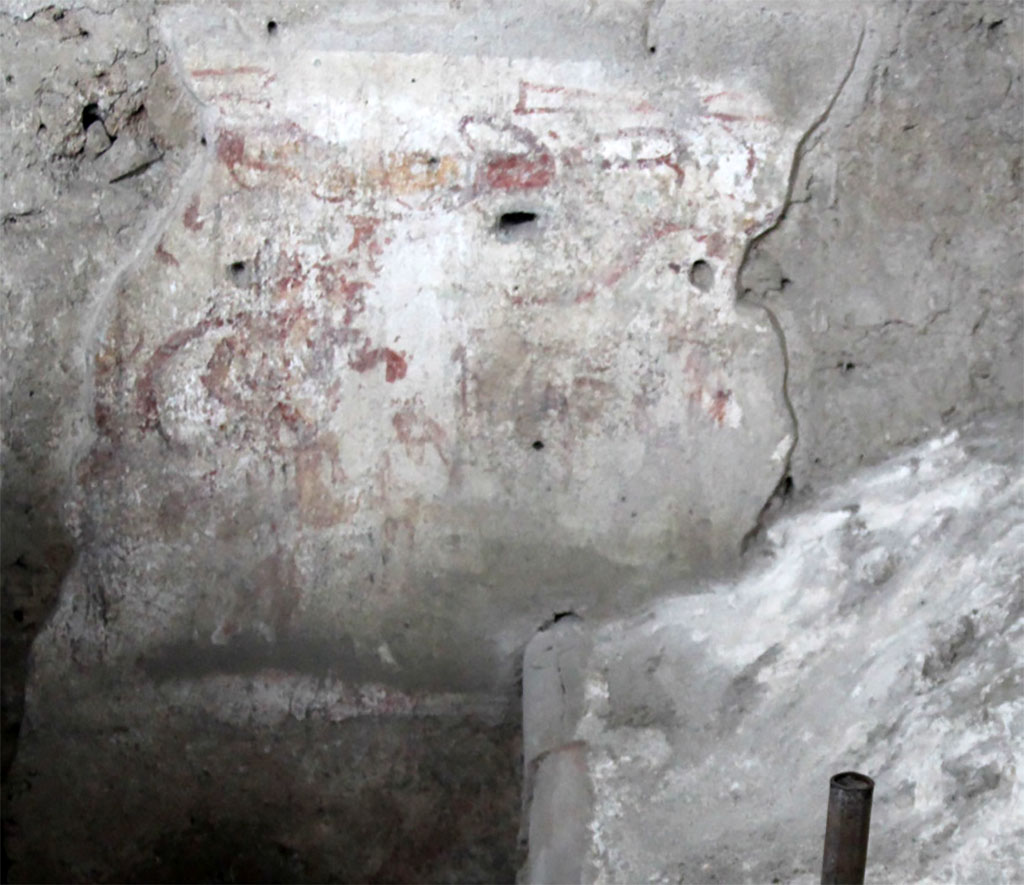
Room 12, altar against south wall. Photo courtesy of Johannes Eber.
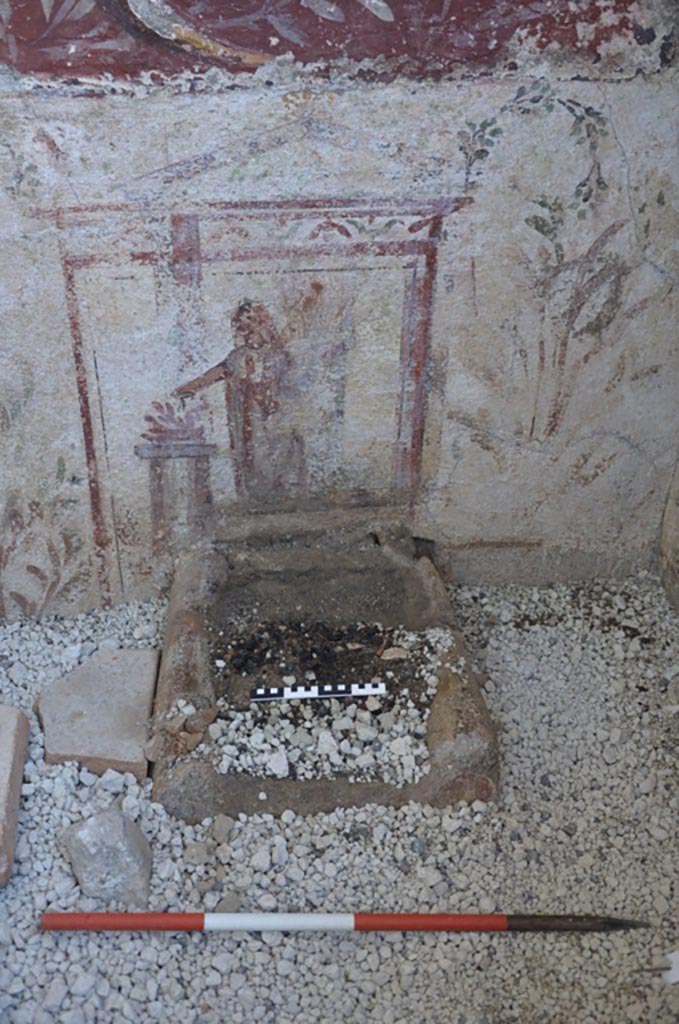
IX.10.1 Pompeii. Lararium and altar recently found in room 12.
The burnt deposit on the altar of the lararium (12).
Il deposito combusto sull’altare del larario (12).
See PAP e-journal 6, 28.09.2023, p. 67, fig.
17. Download:
PAP e-journals 2023 collection volumes 01-09
Photograph
© Parco Archeologico di Pompei.
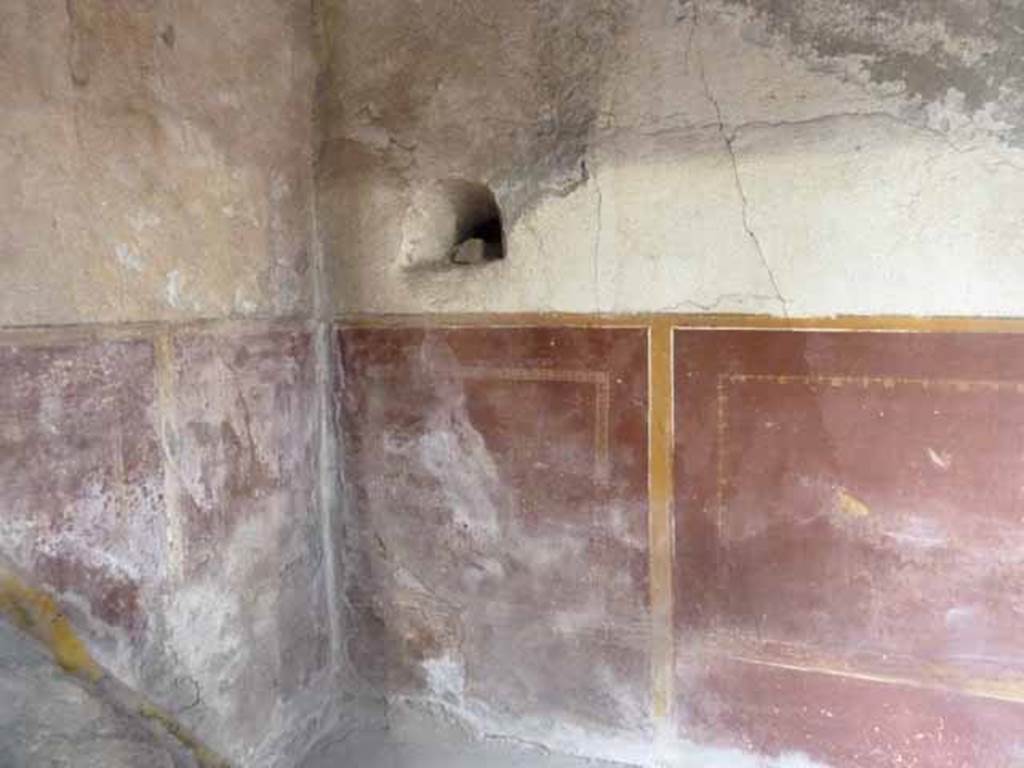
IX.10.1 Pompeii. Lararium and altar recently found in room 12.
Traces
of combustion on the altar during micro-excavation. Detail of the first level
of the deposit (A); Deposit in section (B).
Tracce di combustione sull’altare
in fase di microscavo. Dettaglio del primo livello del deposito (A); Sezione
del deposito (B).
See PAP e-journal 6, 28.09.2023, p. 67, fig.
18. Download:
PAP e-journals 2023 collection volumes 01-09
Photograph
© Parco Archeologico di Pompei.
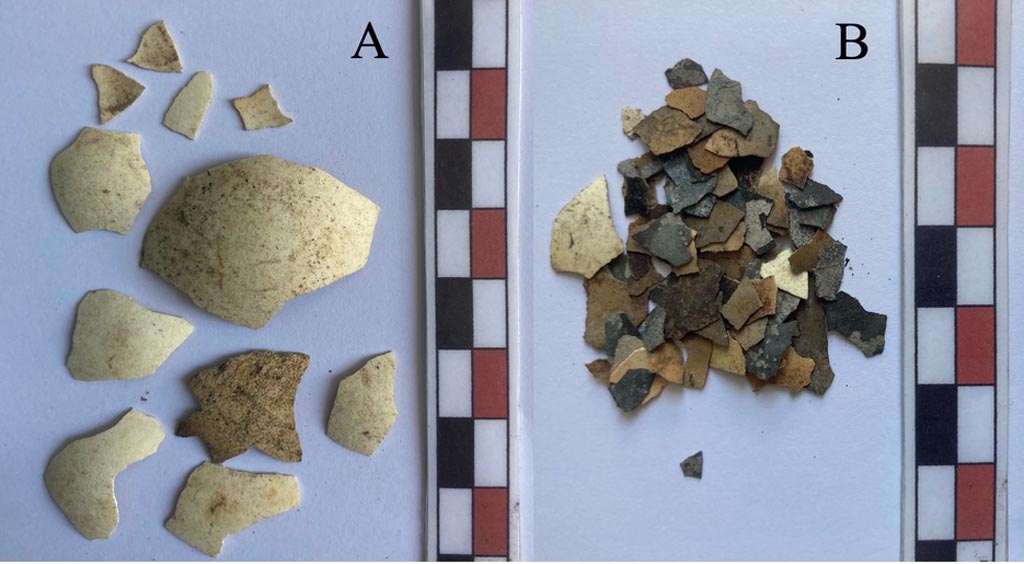
IX.10.1 Pompeii. Lararium and altar recently found in room 12.
Eggshell fragments from the surface level (A) and the deepest layer (B). There is a greater degree of fragmentation and widespread traces of combustion for the remains coming from the deeper level.
Frammenti di guscio d’uovo dal livello superficiale (A) e da quello più
profondo (B). Si nota un maggiore grado di frammentazione e diffuse tracce di
combustione per i resti provenienti dal livello più profondo.
See PAP e-journal 6, 28.09.2023, p. 68, fig.
20. Download:
PAP e-journals 2023 collection volumes 01-09
Photograph
© Parco Archeologico di Pompei.
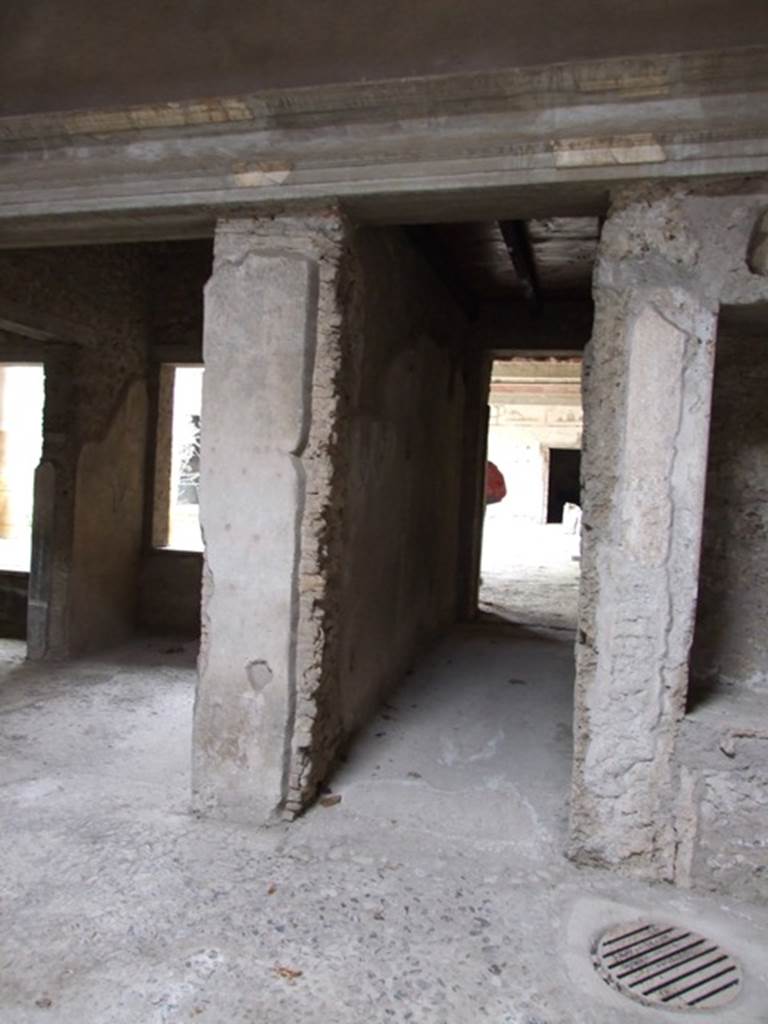
IX.10.1, Pompeii. July 2024. Room 12, south-west corner. Photo courtesy of Johannes Eber.
IX.10 Pompeii. Unnumbered house on west side of insula, south of IX.10.1.
Room 32. Sacrarium with blue walls and niches in red centrally placed on 3 walls.
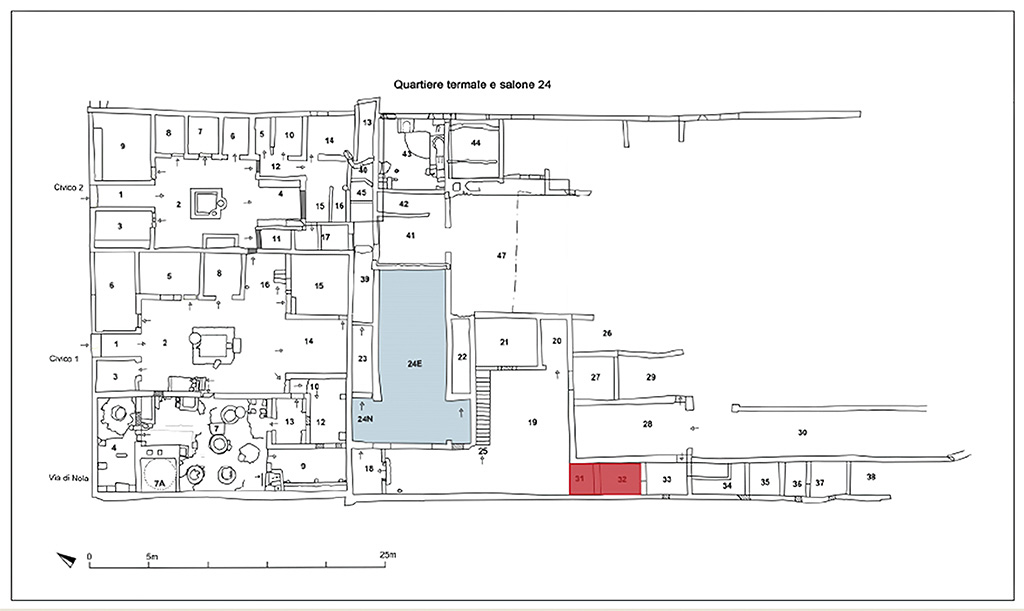
IX.10 Pompeii. House on west side of insula, south of IX.10.1. June 2024. Plan showing location of sacrarium 32, with ante-room 31.
See PAP press release 3rd June 2024
Download PAP 15-E-Journal-Sacrario-Regio-IX.pdf Tav. 1.
Photograph
© Parco Archeologico di Pompei.
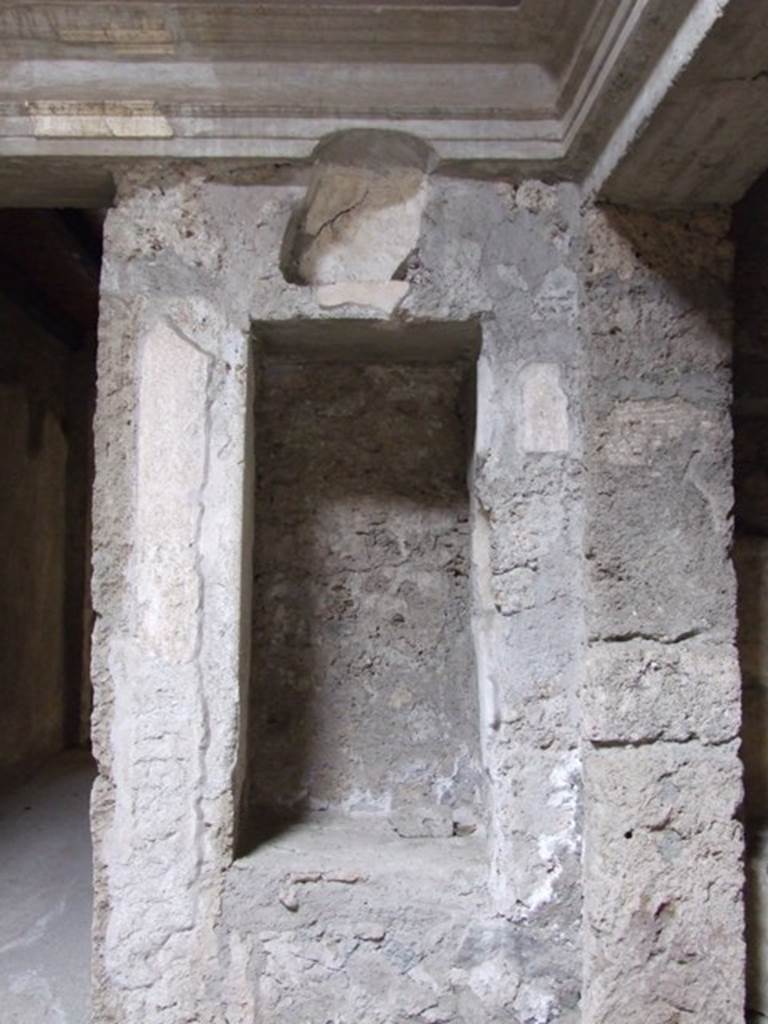
IX.10 Pompeii. House on west side of insula, south of IX.10.1. June 2024.
Sacrarium room 32 (rear) with blue decoration, with ante-room 31 in red.
The excavations underway in Insula 10 of Regio IX in Pompeii have recently uncovered a room that can be interpreted as a shrine, with walls on a blue background, attributable to the Fourth Style and decorated with female figures representing the seasons, as well as two allegories, respectively of agriculture and pastoralism (fig. 1).
According to Ferdinando De Simone's analysis (De Simone 2017), by the time the shrine of Regio IX, 10 was decorated with the ancient divinities of the seasons and rural life, the surrounding area was already densely occupied by villas specialised in the production of wine, which was exported throughout the Mediterranean.
Download
PAP
15-E-Journal-Sacrario-Regio-IX.pdf, Fig. 1., p. 3.
Photograph
© Parco Archeologico di Pompei.
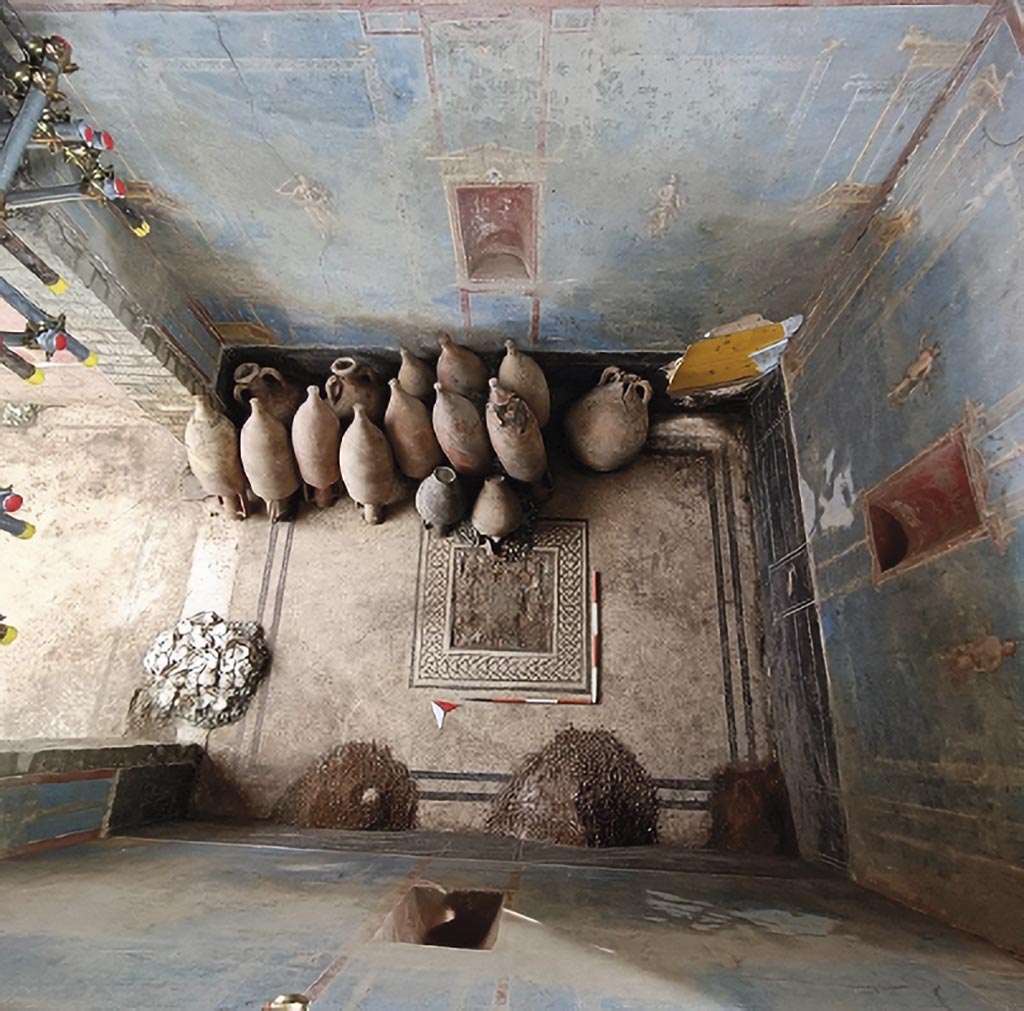
IX.10 Pompeii. House on west side of insula, south of IX.10.1. June 2024.
Sacrarium room 32 with blue decoration, showing identical niches in red on three walls.
Once the stratigraphic sequence was removed, two piles of cocciopesto of different grain sizes and a third pile with a mixture of lime, aggregates and cocciopesto were brought to light (fig. 6). The accumulations of pozzolana and cocciopesto can be traced back to the construction activities present in the house, in particular the room, originally a finely decorated chapel, was used shortly before the eruption as a deposit for amphorae and a place to store building materials.
It should therefore come as no surprise that the sacrarium itself, at the time of the eruption, was transformed into a depository for amphorae and building materials: even when it was in operation, it was not a place with an exclusive sacral function; this distinguishes the sacraria from the lararia, which indeed retained their ritual centrality for longer, probably because they were directly linked to the exercise of the pater familias' power (cf. Van Andringa 2009).
Download PAP 15-E-Journal-Sacrario-Regio-IX.pdf, Fig. 6, p. 4.
The newly resurfaced room presents characteristic elements that refer to the architectural articulation of similar contexts and in particular the presence of niches embedded in the south, east and west walls. If the presence of niches in itself is not an exclusive characteristic of sacred environments, the monumentality that they take on in this context, especially in relation to the fusion with a decorative system, designed in relation to the presence of these elements, make the new discovery particularly interest. In the last phase of the domus' life, this room was also used as a storage for containers, with the usual tally notes written on the east jamb after the entrance, and to accumulate building materials. It was then explored between the 18th and 19th centuries through a tunnel to recover part of the furnishings and perhaps the polychrome marble emblem placed in the centre of the floor mosaic. These are perhaps the reasons why the cult images were not found inside the niches, either taken in ancient times to be stored while awaiting the end of the building works on the house or taken away during eighteenth-nineteenth century explorations.
See
PAP
15-E-Journal-Sacrario-Regio-IX.pdf, p. 5.
Photograph
© Parco Archeologico di Pompei.
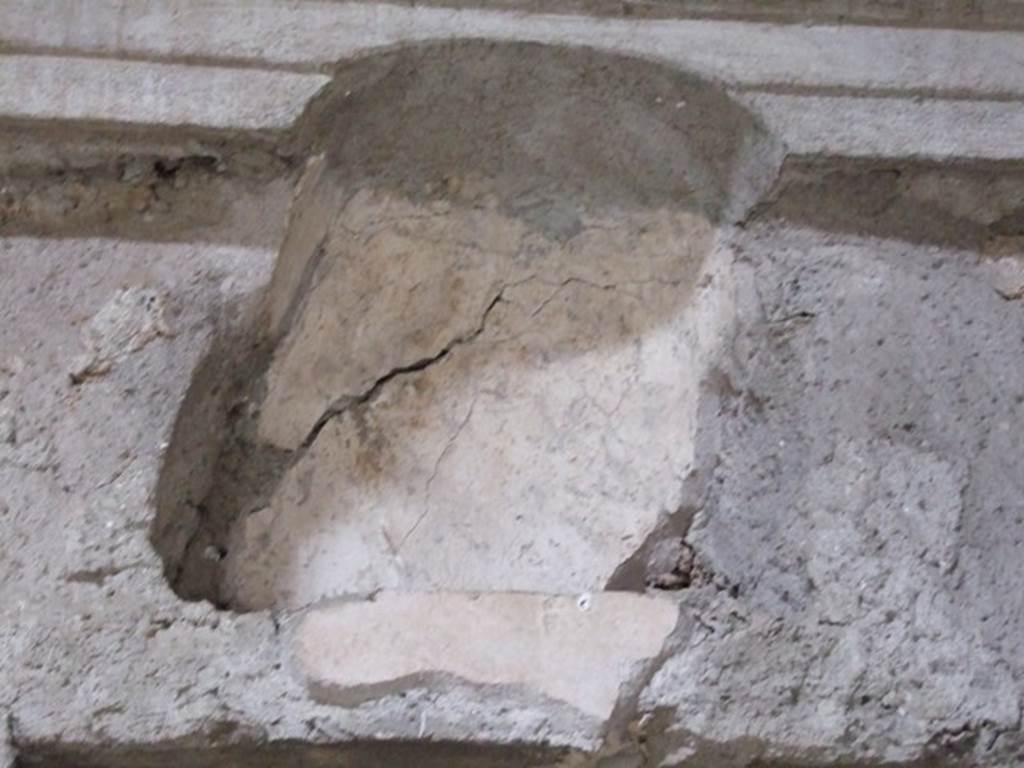
IX.10 Pompeii. House on west side of insula, south of IX.10.1. June 2024.
Sacrarium room 32 west wall with blue decoration, showing niche in red with figures either side.
On the left is the divinity of Summer. On the right is the divinity of Winter.
A similar pattern exists on the east wall with representations of the divinities of Autumn and Spring.
See PAP 15-E-Journal-Sacrario-Regio-IX.pdf, fig. 12. p. 12,
See also photos in the E-Journal (pages 12 and 13) of: Summer – fig. 20, Winter – fig. 21, Autumn - fig. 22 and Spring - fig. 23.
Photograph
© Parco Archeologico di Pompei.
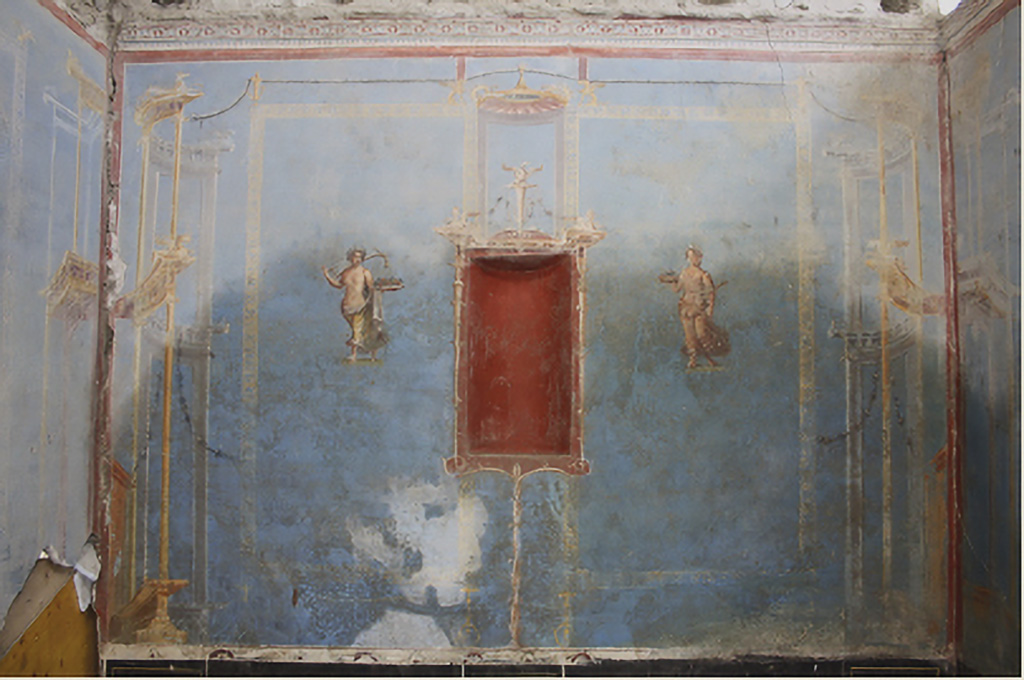
IX.10 Pompeii. House on west side of insula, south of IX.10.1. June 2024.
Sacrarium room 32 south wall with blue decoration, showing niche in red with figures either side.
On the left is an allegorical agricultural image with a female figure carrying a form of plough on her shoulder and a tray with first fruits in her hand.
On the right is an allegorical agricultural image with a female figure holding out a basket of first fruits and with a curved stick under her arm.
See PAP 15-E-Journal-Sacrario-Regio-IX.pdf, fig. 14, p. 9, and detailed photos of the two figures, fig. 18, fig. 19, p. 11.
Photograph
© Parco Archeologico di Pompei.
IX.12.6 Pompeii.
Room “n1”. Lararium painting, with preparatory sketch, and an altar against west wall.
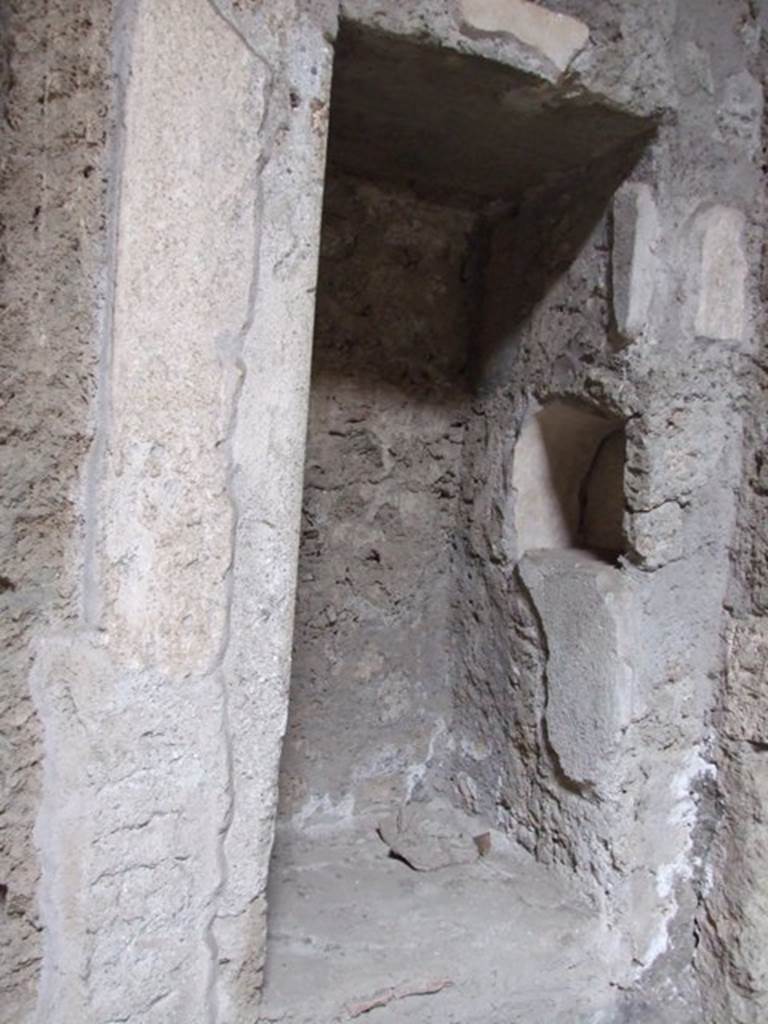
IX.12.6 Pompeii. July 2024. Room “n1”, with lararium painting on west wall. Photo courtesy of Johannes Eber.
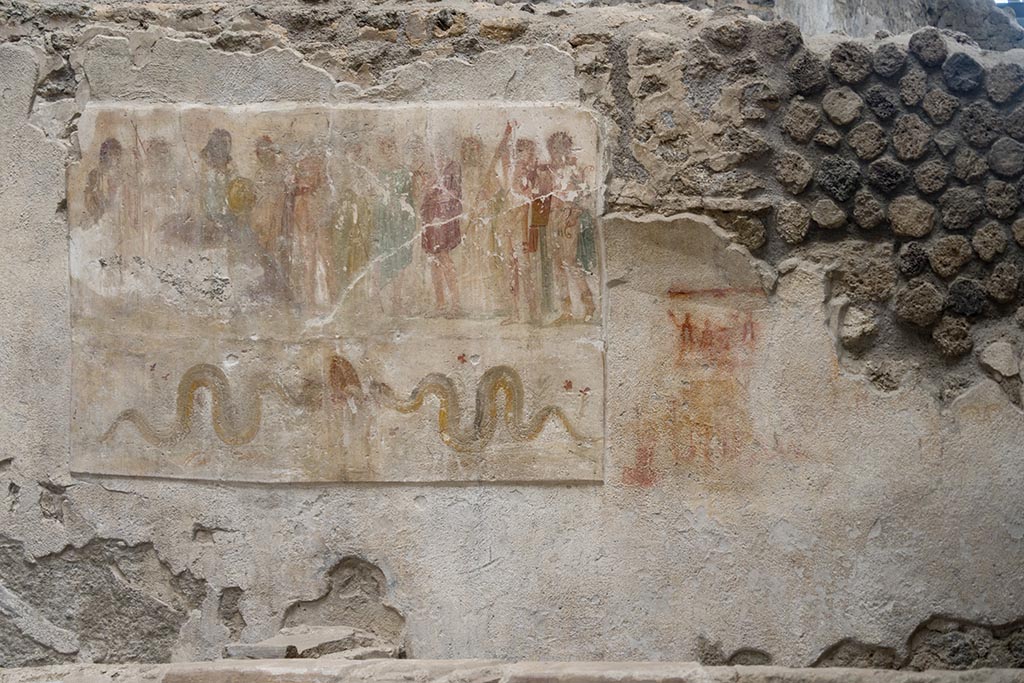
IX.12.6 Pompeii. July 2024.
Room “n1”, west wall with lararium painting, on the right is the preparatory sketch. Photo courtesy of Johannes Eber.
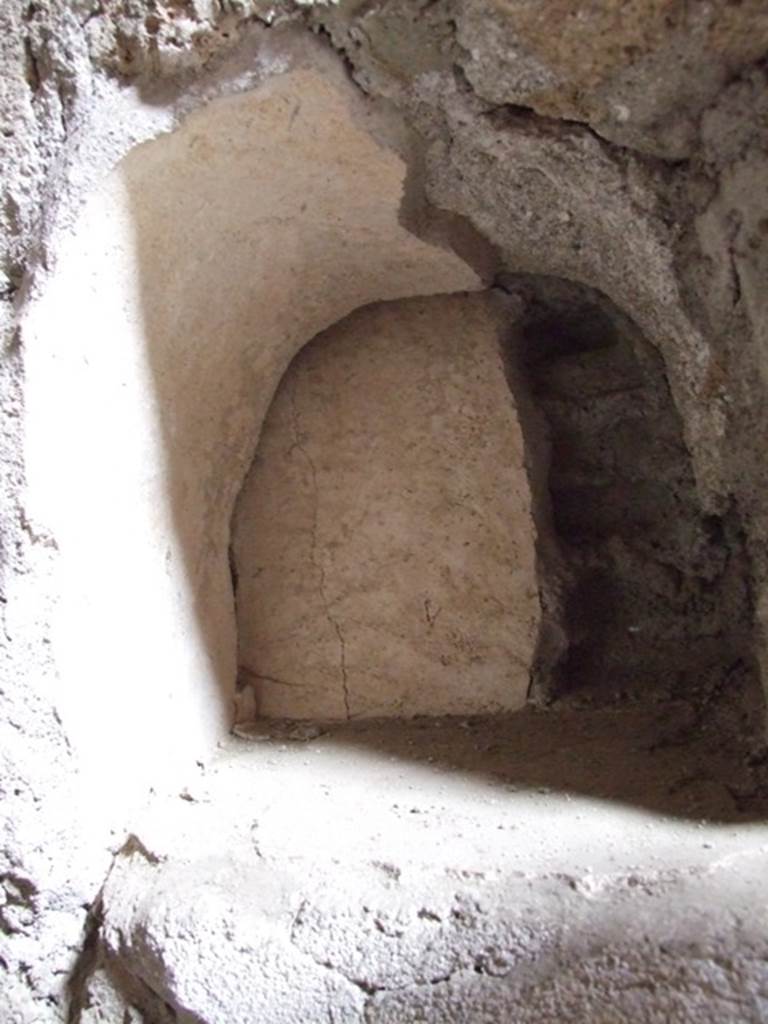
IX.12.6 Pompeii. July 2024.
Room “n1”, lararium painting on west wall, showing Hercules being presented to the twelve gods in the upper part.
Underneath are two serpents approaching an altar.
To the right are the remains of a possible preparatory sketch for a lararium painting?
Photo courtesy of Johannes Eber.
IX.12.6 Pompeii. July 2024.
Room “n1”, preparatory sketch for lararium, on west wall. Photo courtesy of Johannes Eber.
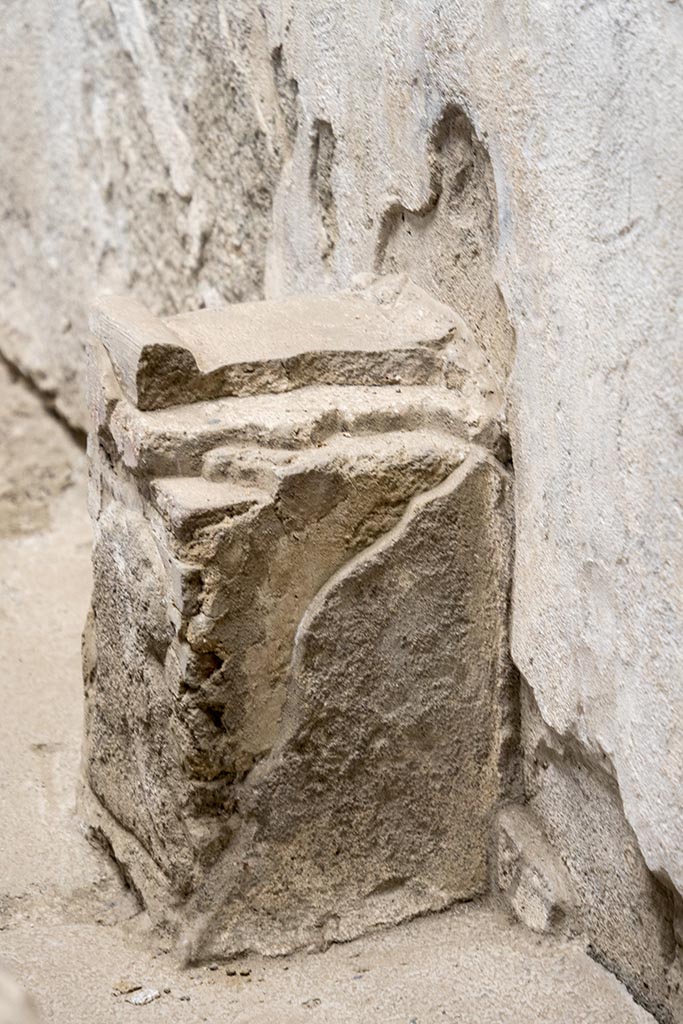
IX.12.6 Pompeii. July 2024.
Room “n1”, altar against west wall of internal garden. Photo courtesy of Johannes Eber.
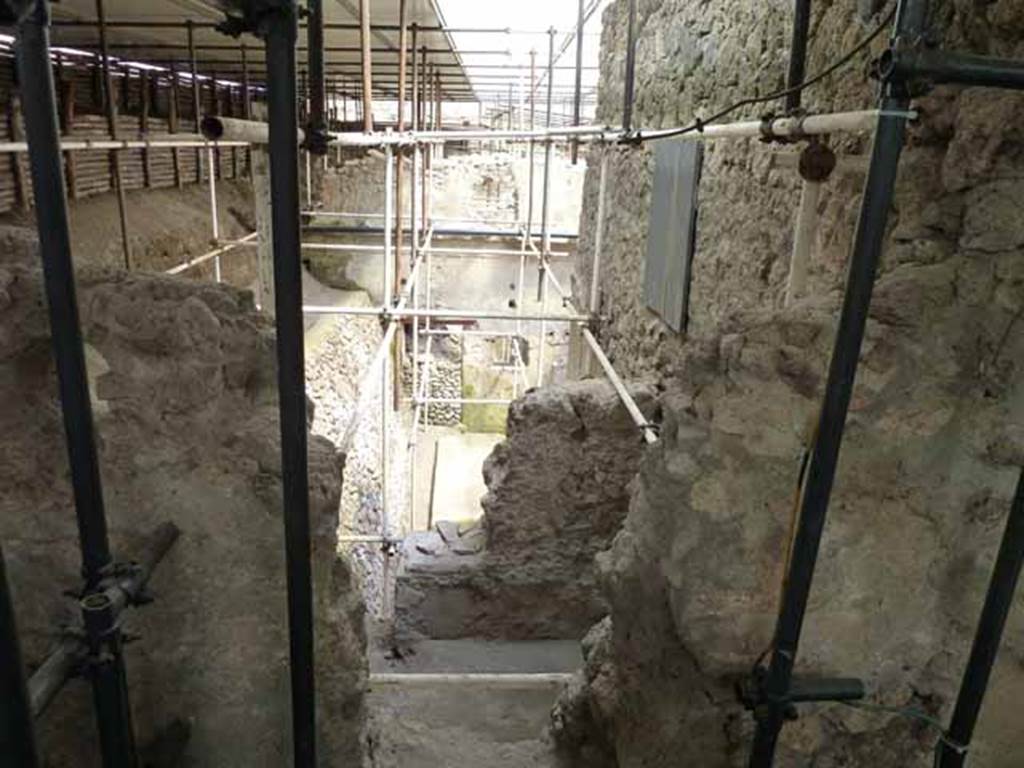
IX.12.6
Pompeii. February 2017.
Room
“n1”,
west wall with lararium, and preparatory sketch, on right.
Photo
courtesy of Johannes Eber.
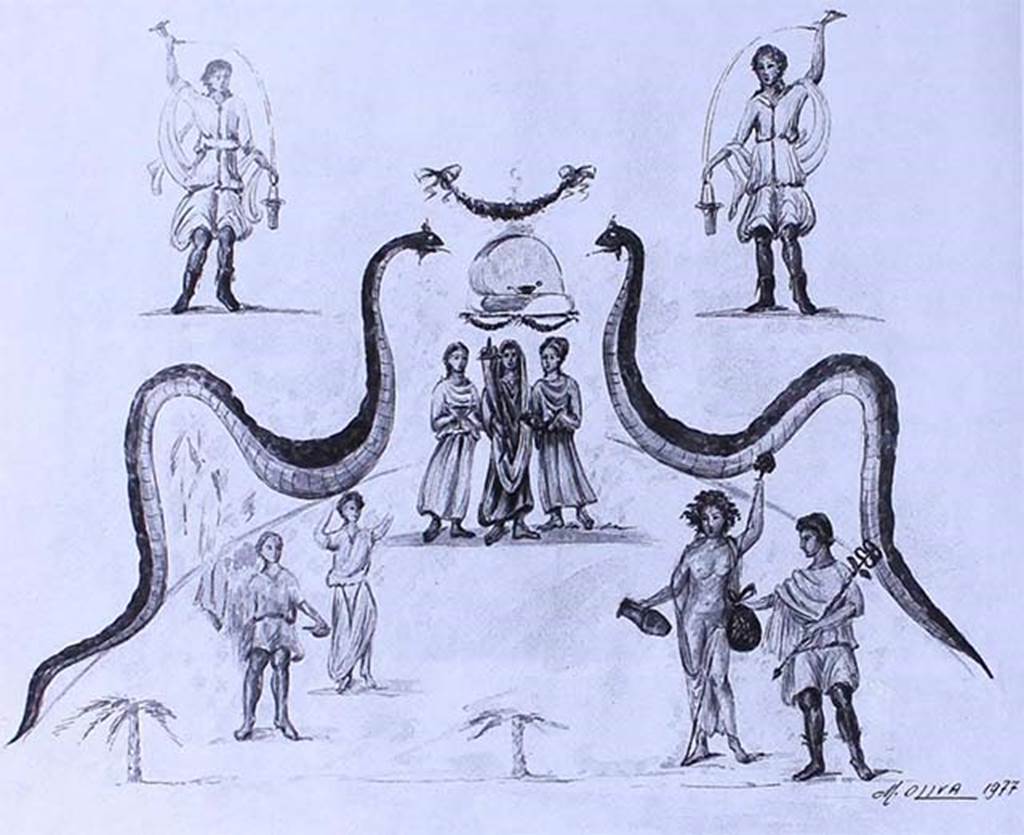
IX.12.6
Pompeii. February 2017.
Room
“n1”, looking south along west wall towards lararium with altar below.
Photo
courtesy of Johannes Eber.
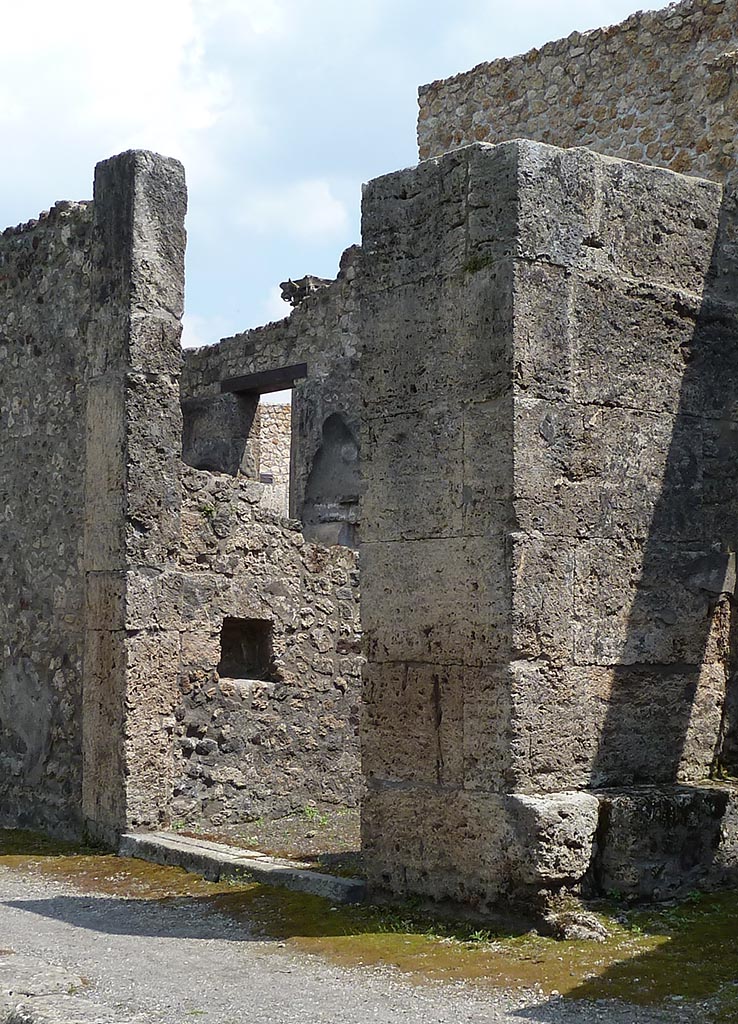
IX.12.6 Pompeii. March 2009. Room “n1”, west wall, detail of the preparatory sketch for a lararium painting?
See Nappo, S., 1998. Pompeii: Guide to the lost City. London: Weidenfeld and Nicolson. (p.57).
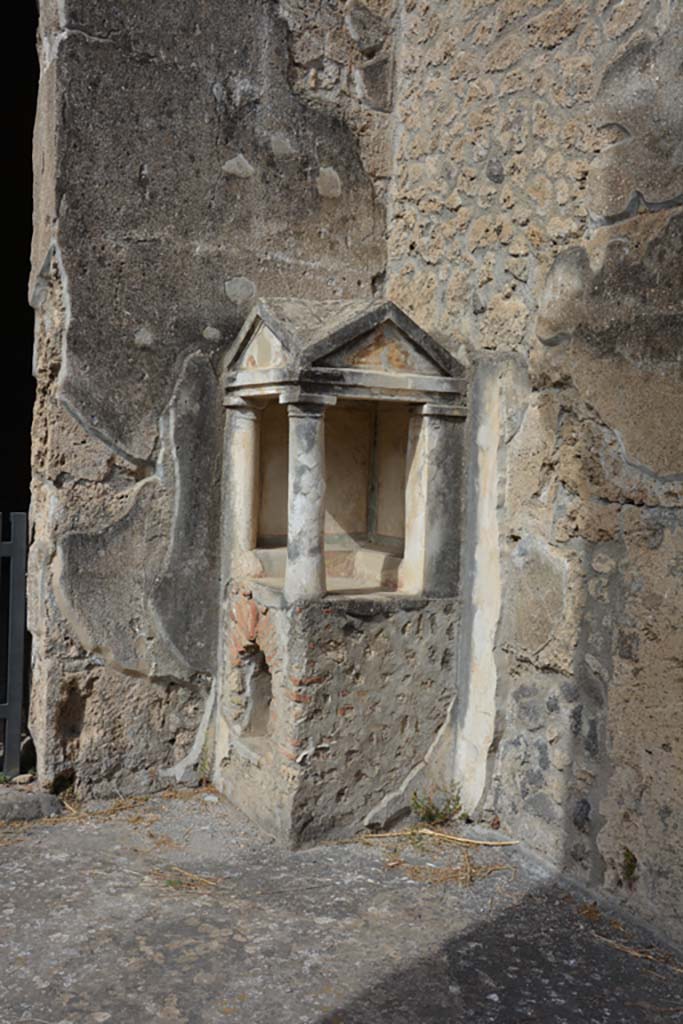
IX.12.6 Pompeii. May 2010. Room “n1”, west wall with lararium painting, from doorway at IX.12.8.
Room “f”, niche in north wall in north-west corner.
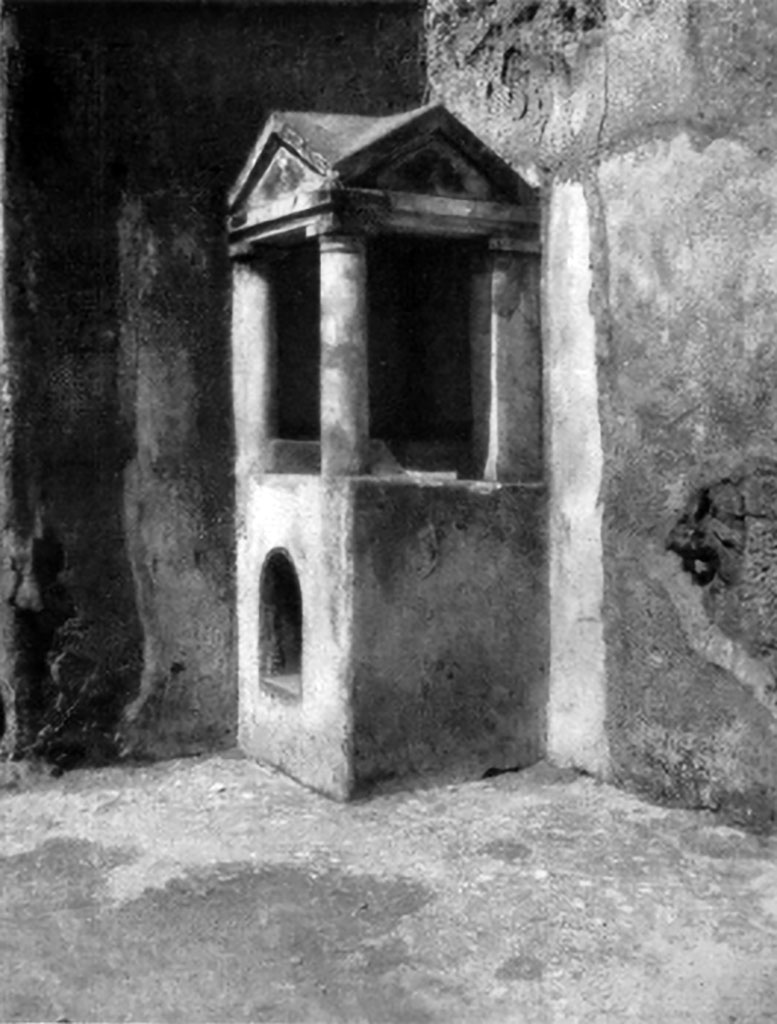
IX.12.6
Pompeii. February 2017. Room “f”, north-west corner of bakery, with niche in
north wall. Photo courtesy of Johannes Eber.
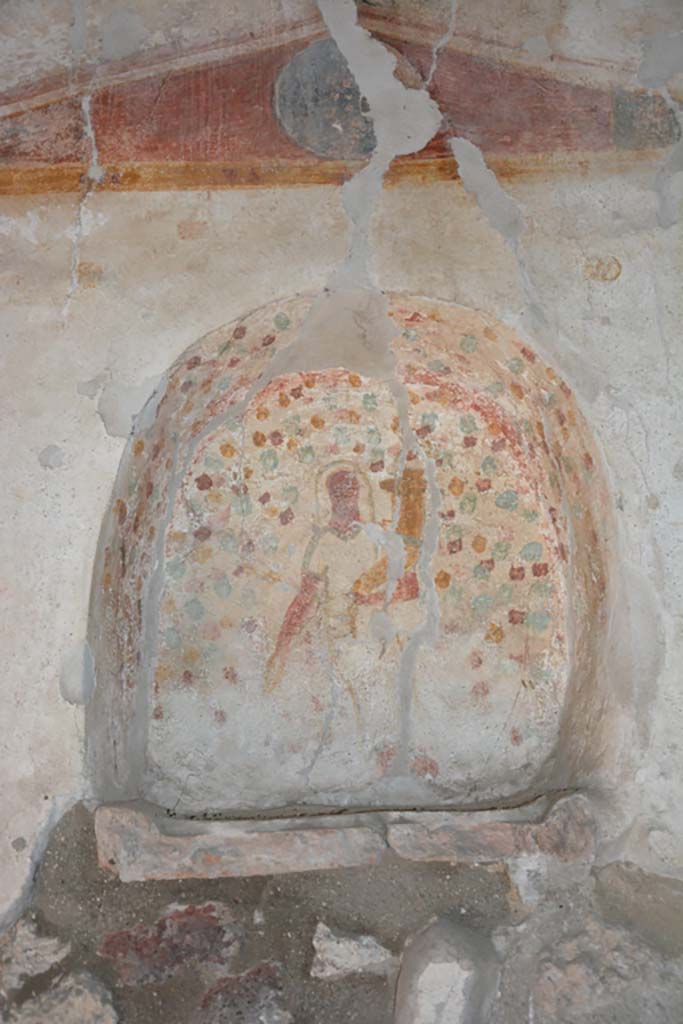
IX.12.6 Pompeii. March 2009. Room “f”, niche in wall in north-west corner.
Room “g”, behind the niche, has the stone bench against the wall.
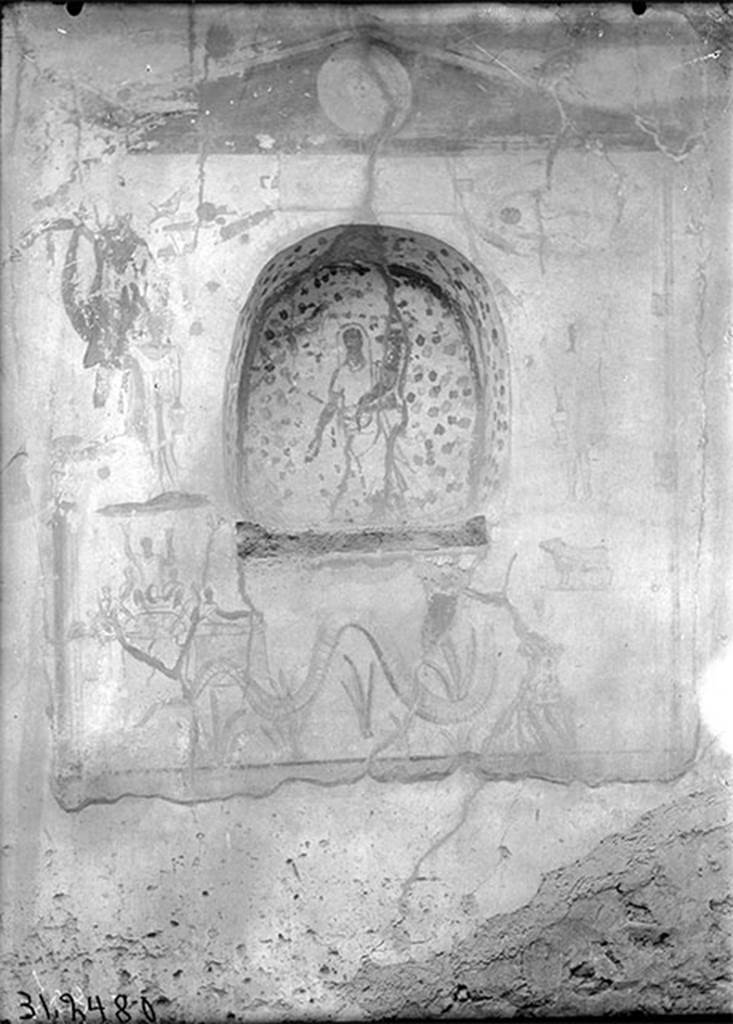
IX.12.6 Pompeii. March 2009. Room “f”, niche.
IX.12.B Pompeii.
Lararium painting on west wall of kitchen “a”.
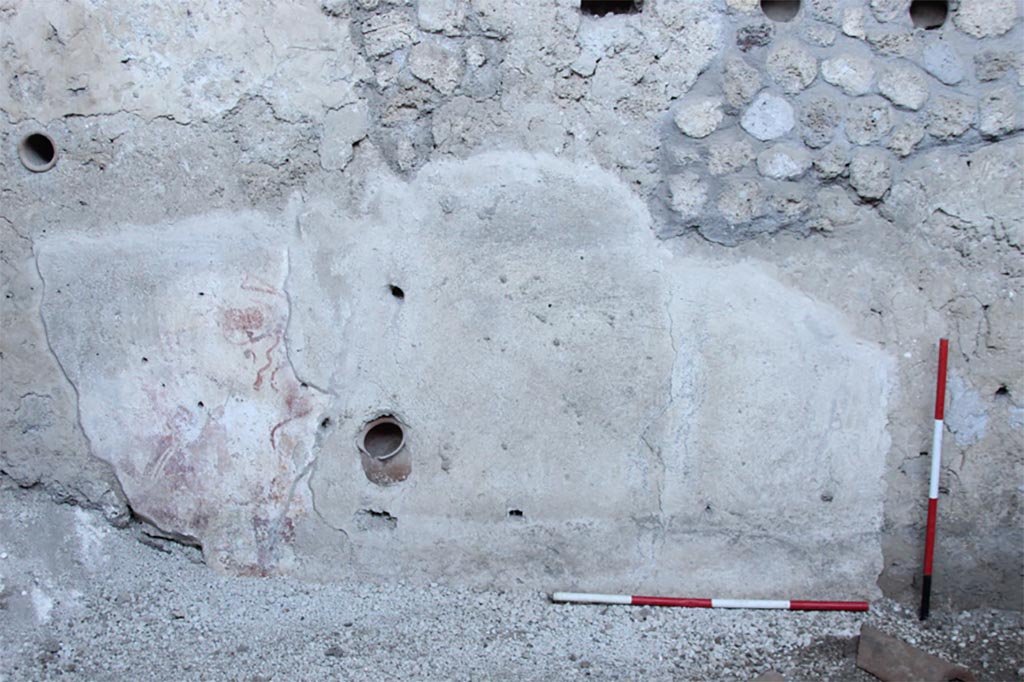
IX.12.B Pompeii. May 2023.
Room “a”, west wall of kitchen. Next to the room where the skeletons were found was a kitchen, with a stone counter.
Above the kitchen counter were traces of a
domestic shrine in the form of a fresco which appears to depict the household
gods (Lares) and a ceramic pot partly set into the wall which may have been
used as a container for religious offerings.
See PAP: New victims from Pompeii emerge from the excavation of the house of the chaste lovers
Ambiente “a”, parete ovest della cucina. Accanto alla stanza in cui sono
stati trovati gli scheletri c'era una cucina, con un bancone in muratura.
Sopra il bancone della cucina, le tracce di un Santuario domestico sotto
forma di un affresco che sembra raffigurare i Lares della casa et un vaso di
ceramica parzialmente incassata ne muro che potrebbe essere stato utilizzato
come ricettacolo di offerte religiose.
Vedi
PAP:
Pompei due scheletri rinvenuti sotto un crollo di muro
Photograph
© Parco Archeologico di Pompei.
See/Vedi
E-Journal, Scavi di Pompei, Vol. 1, May 2023, p. 4, Fig. 3 PAP
E-Journal_01 (PDF)
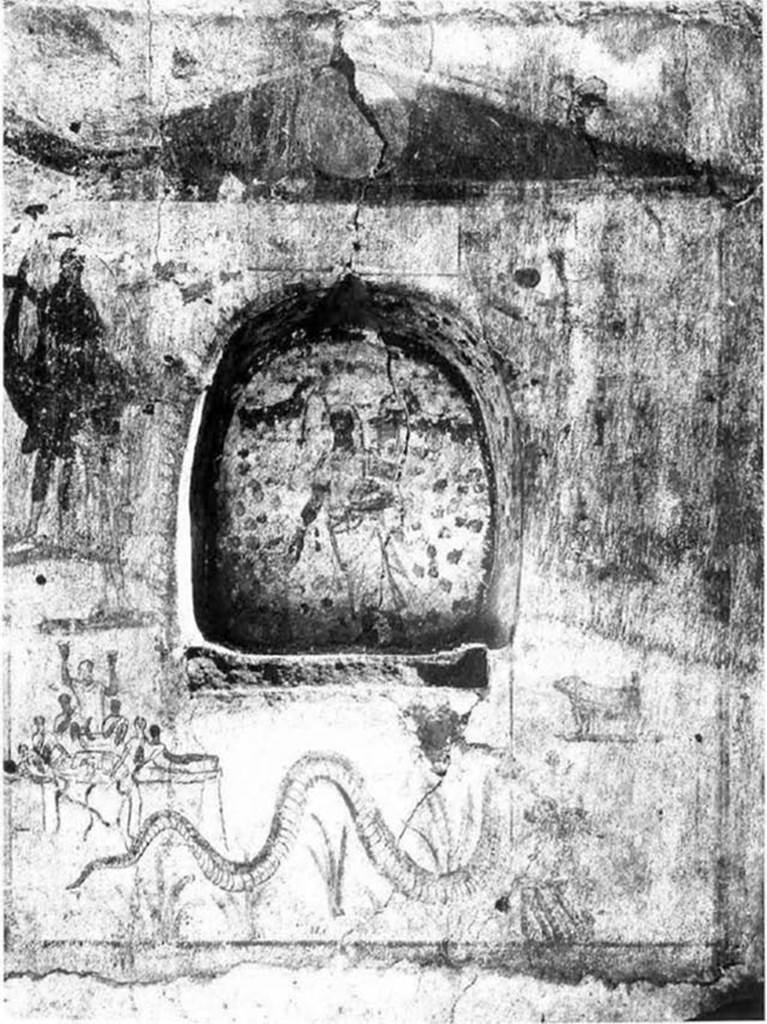
IX.12.B Pompeii. May 2023.
Room “a”, south wall of kitchen.
A male figure with a short tunic and cornucopia, interpretable as a lar.
Ambiente “a”, parete sud della cucina.
Una figura maschile con tunica corta e cornucopia, interpretabile come
lare.
Photograph
© Parco Archeologico di Pompei.
See/Vedi
E-Journal, Scavi di Pompei, Vol. 1, May 2023, p. 4, Fig. 2 PAP
E-Journal_01 (PDF)
The south-west corner retains traces of a
decorated plaster in a poor state of conservation which must have referred to
the first documented decorative phase. Despite the non-optimal state of
conservation, it is possible to read on the plaster that covers the southern
wall to the west a standing male figure with a short tunic and cornucopia,
which can also be interpreted on the southern portion of the western wall,
continuing with the same figurative scheme. In fact, two partially preserved
male figures can be glimpsed and arranged in different registers, while
snake-like motifs are visible on the sides. The plaster is covered by a
subsequent preparation which incorporates a common ceramic olla (rim diameter
13.5 cm) with everted rim, housed in the wall and facing outwards (Fig. 3). The
kitchen counter (h. 71 cm. length. 133 cm.) leans against the south and west
perimeter walls. It was built in opus incertum with the north-east corner
composed of blocks of yellow tuff of regular dimensions (24-31 cm. x 9 cm) also
used for the plinth.
See
E-Journal, Scavi di Pompei, Vol. 1, May 2023, p. 4, Fig. 3 PAP
E-Journal_01 (PDF)
L’angolo sud-ovest conserva tracce di un intonaco decorato in cattivo stato
di conservazione che doveva riferirsi alla prima fase decorativa documentabile.
Nonostante lo stato di conservazione non ottimale, è possibile leggere
sull’intonaco che riveste ad ovest la parete meridionale una figura maschile
stante con tunica corta e cornucopia, interpretabile anche la porzione
meridionale della parete occidentale proseguendo con lo stesso schema
figurativo. Si intravedono infatti due figure maschili parzialmente conservate
e disposte su registri diversi, mentre ai lati sono visibili motivi
serpentiformi. L’intonaco è coperto da una preparazione successiva (USR 32) che
ingloba un’olla di ceramica comune (D. orlo 13,5 cm) con orlo estroflesso,
alloggiata nella parete e rivolta verso l'esterno (Fig. 3). Il banco della
cucina (h. 71 cm. lung. 133 cm.) si appoggia ai muri perimetrali sud e ovest. É
costruito in opera incerta con l’angolare nord-est composto da blocchi di tufo
giallo di dimensioni regolari (24-31 cm. x 9 cm) impiegati anche per lo
zoccolo.
Vedi E-Journal, Scavi di Pompei, Vol. 1, May
2023, p. 4, Fig. 3 PAP
E-Journal_01 (PDF)
Niche in north wall of portico.
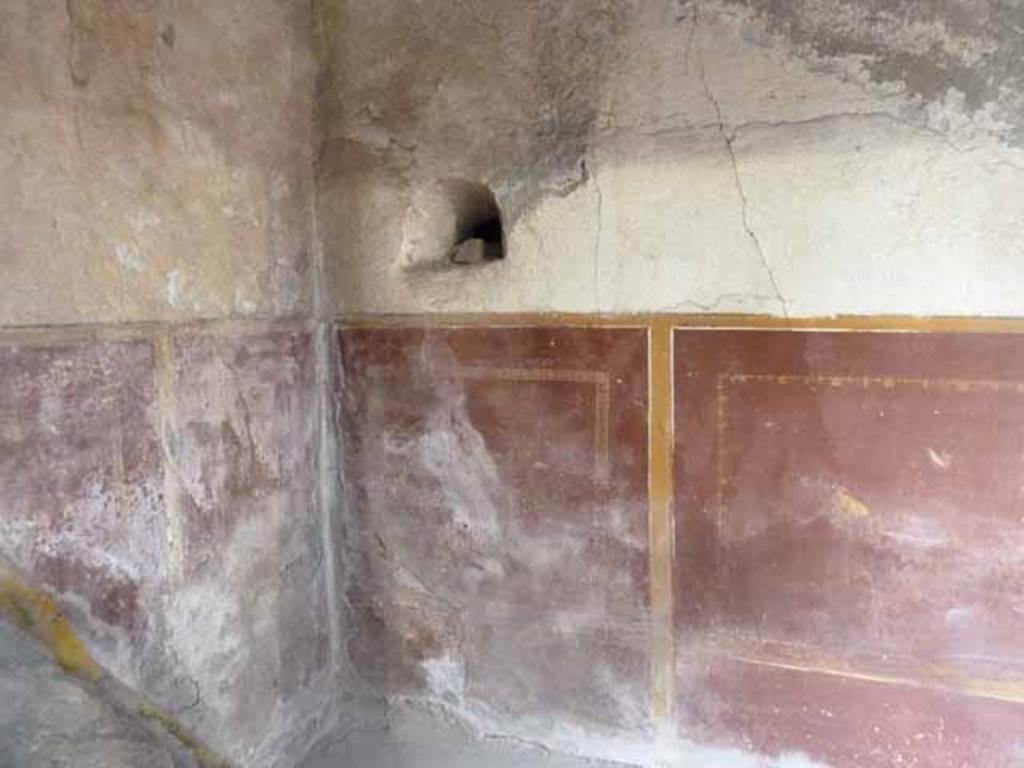
IX.12.9 Pompeii. May 2010. Garden area 8, north-west corner of portico.
IX.13.1-3 Pompeii.
Niches, atrium, to the side of the east wall of corridor leading to peristyle.
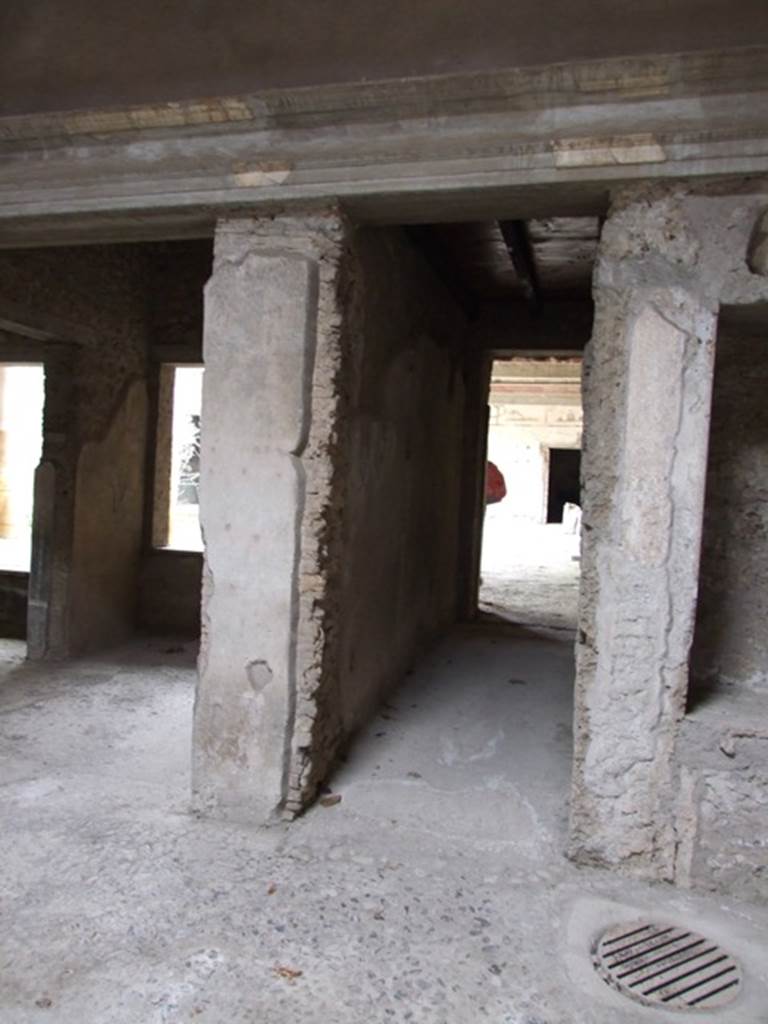
IX.13.1-3 Pompeii. March 2009.
Room 7, corridor to peristyle and rear rooms,
with recess/niche on east side.
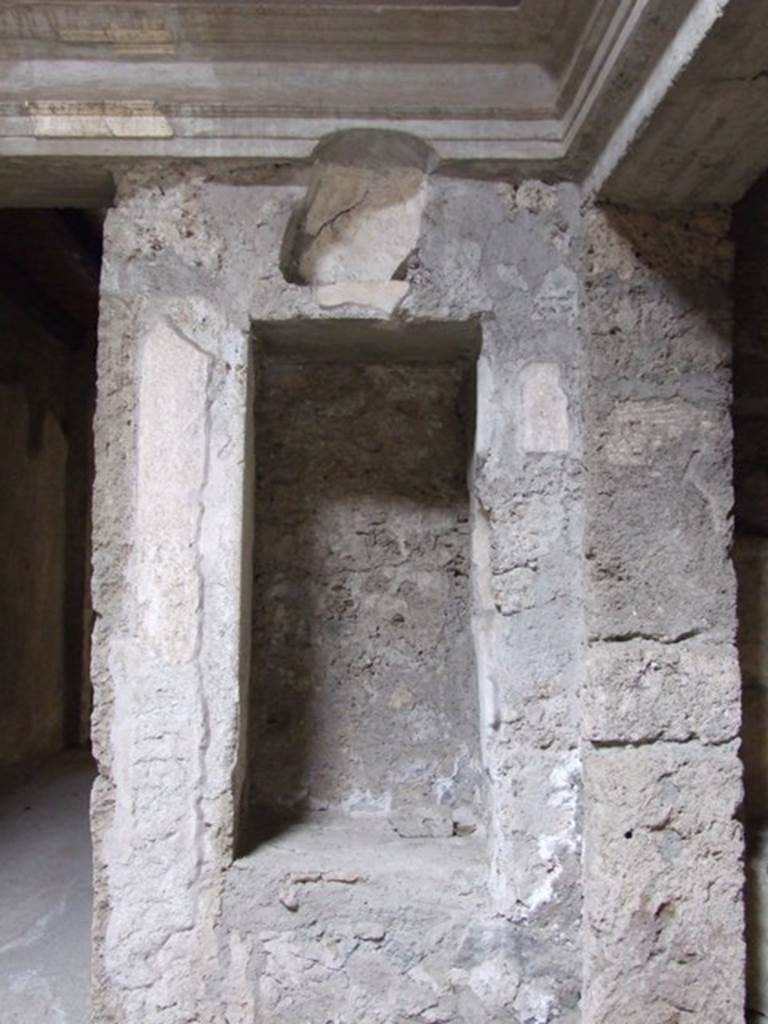
IX.13.1-3 Pompeii. March 2009. Room 2,
north-east corner of atrium. Recess with 2
niches.
See Giacobello, F., 2008. Larari Pompeiani: Iconografia e culto dei Lari in ambito domestico. Milano: LED Edizioni, (p.250, no.A41)
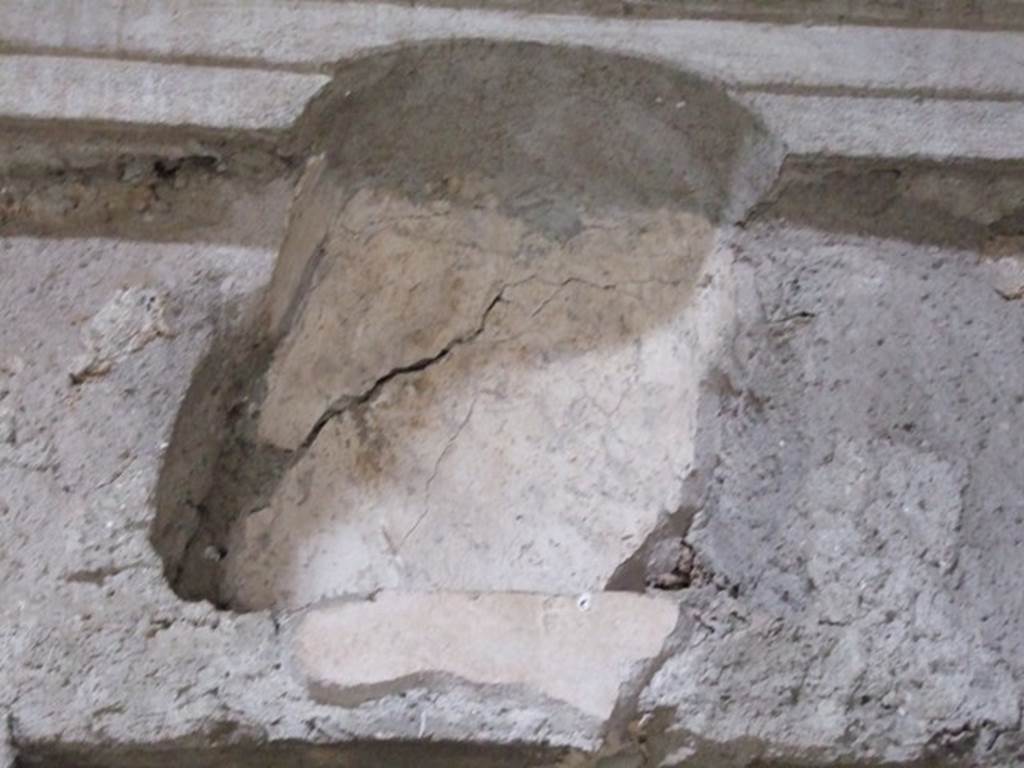
IX.13.1-3 Pompeii. March 2009. Room 2,
atrium. Niche above recess.
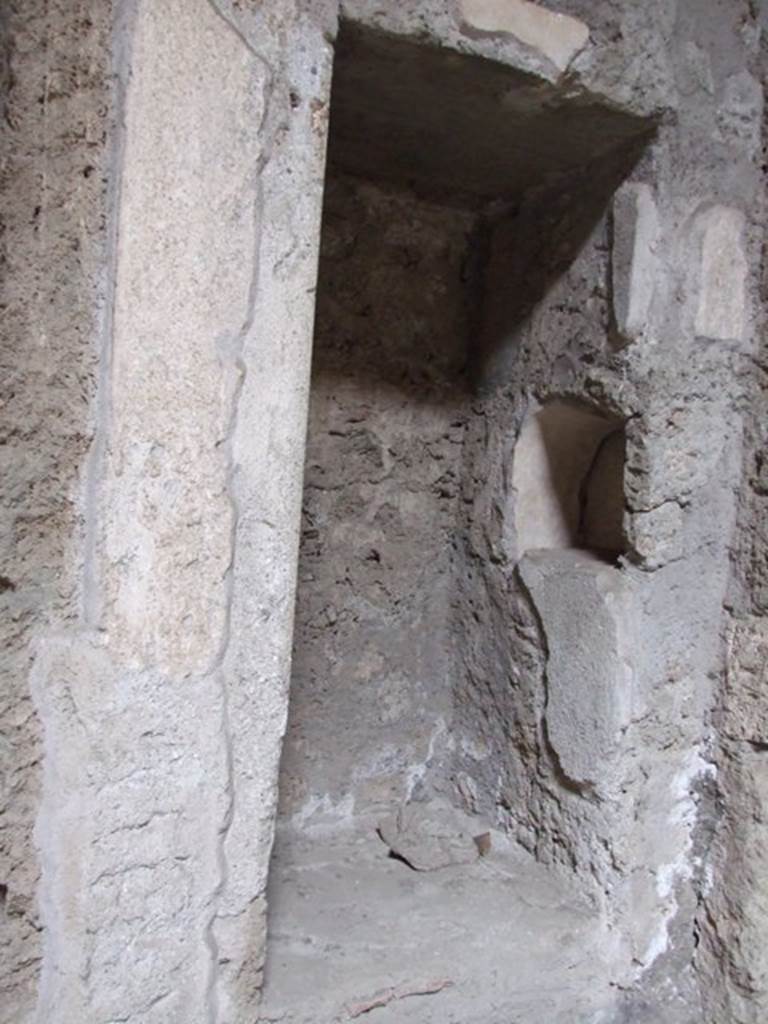
IX.13.1-3 Pompeii. March 2009.
Room 2, north-east corner of atrium. Recess
with 1 niche above, and 1 niche in east side.
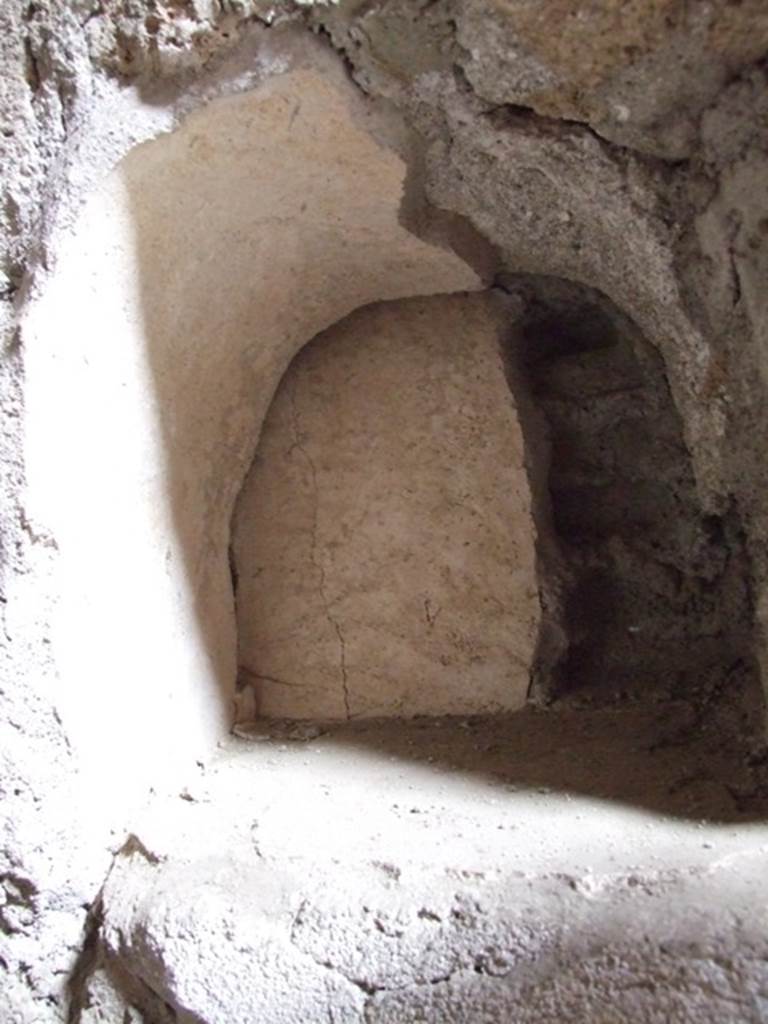
IX.13.1-3 Pompeii. March 2009. Room 2,
atrium. Niche in east side of recess.
Lararium painting, west wall of corridor of entrance into kitchen.
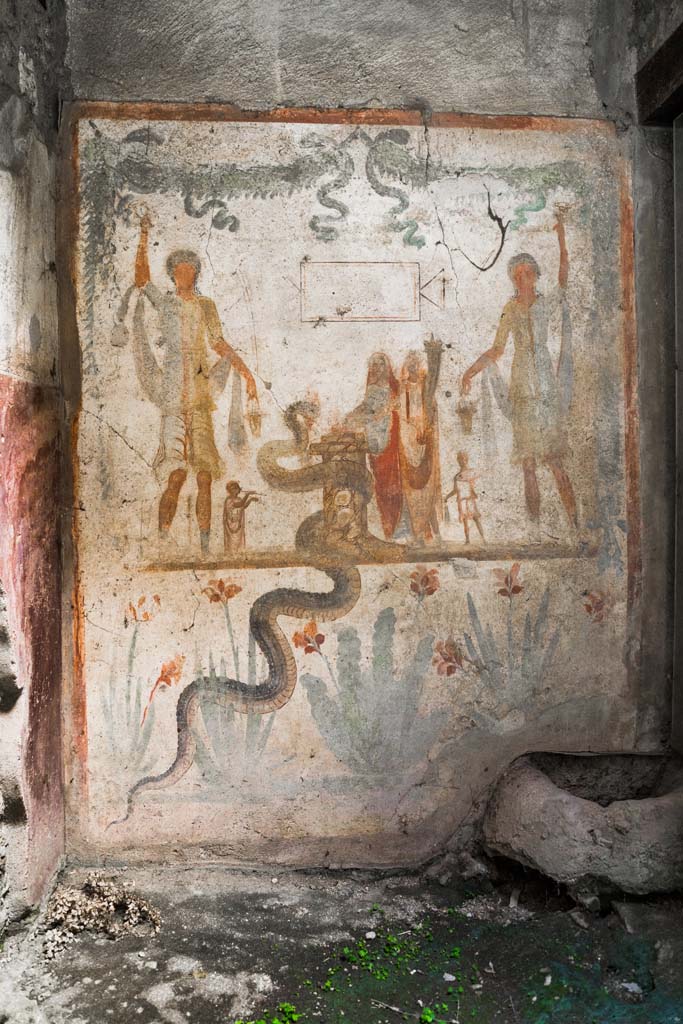
IX.13.1-3 Pompeii. October 2021.
Room 21, lararium in south-west corner, west
wall of services atrium. Photo courtesy
of Johannes Eber.
See Fröhlich, T., 1991, Lararien und Fassadenbilder in den
Vesuvstädten. Mainz: von
Zabern. (p.298, L109, Taf.14,2).
See Giacobello, F., 2008. Larari Pompeiani: Iconografia e culto dei Lari in ambito domestico. Milano: LED Edizioni, (p.216, no.113).
IX.13, house on north side of IX.13.1-3, Pompeii.
Painting and niche, south wall of open garden area.
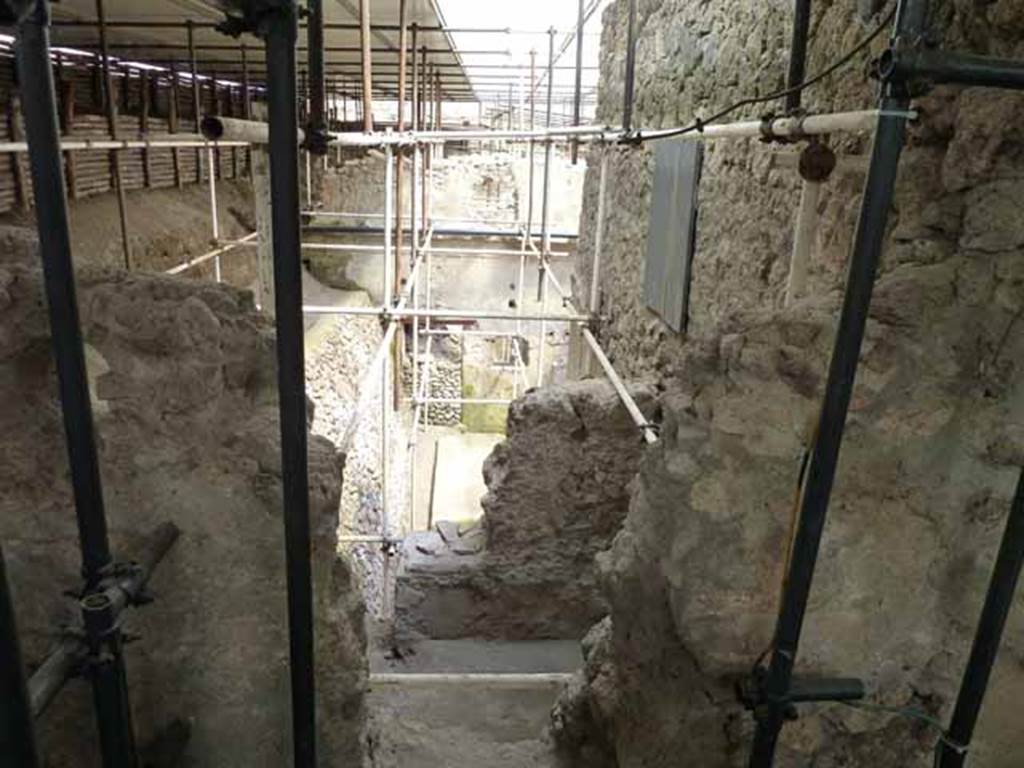
IX.13 Pompeii. May
2010. Excavation behind IX.13.1/3. Looking east from Vicolo di Giulio
Polibio.
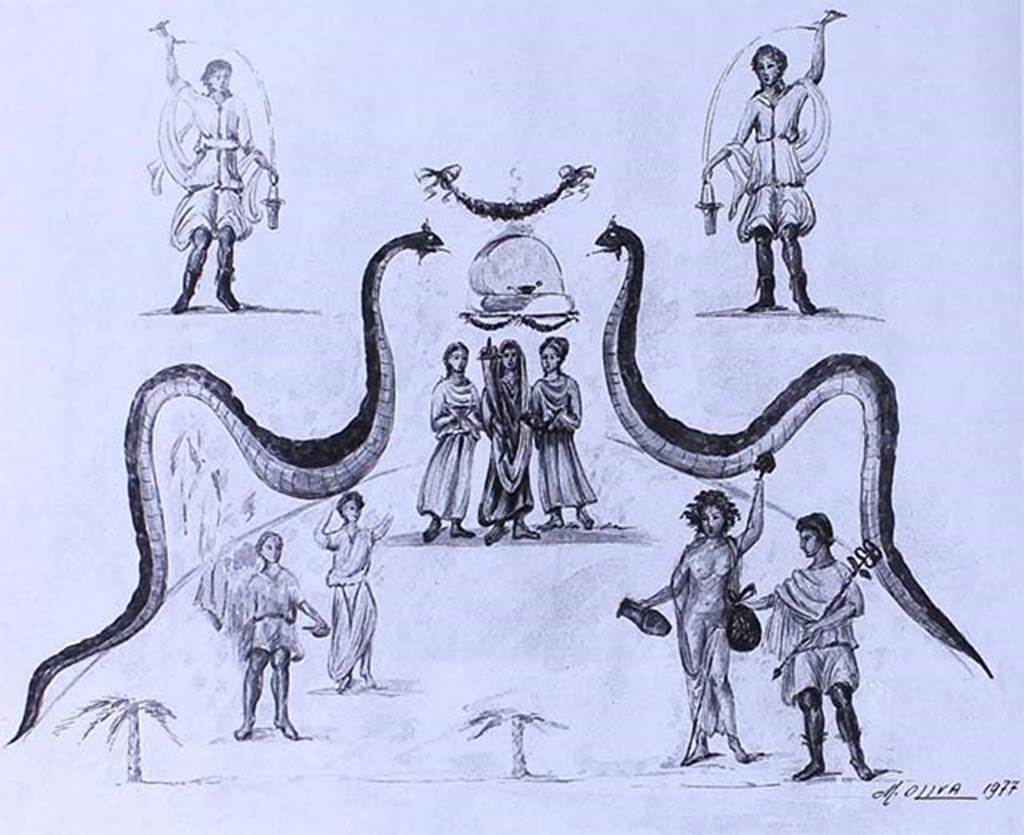
IX.13, house on north side of IX.13.1-3. 1977 drawing by M. Oliva of a lararium discovered in a garden to the north of IX.13.3.
A small niche, which
contained a lamp, has a garland above and two serpents approaching, one from
each side.
Two Lares are in the
upper zone, one on each side.
Below the niche is
the genius and two female figures.
Bottom at the right
are Bacchus and Mercury.
Bottom at the left
are two figures.
Two palm trees are
also shown at the bottom.
See Kuivalainen, I., 2021. The Portrayal
of Pompeian Bacchus. Commentationes
Humanarum Litterarum 140. Helsinki: Finnish Society of Sciences
and Letters, (F22, p.176).
According to Fröhlich : Niche and lararium painting on the back wall of an open-plan room in a rustic utility wing with kitchen and repository.
White-ground wall surface with an arched niche in the centre.
The small arched niche, above which a garland is painted, is flanked by two Lares on separate ledges. In addition, two snakes arranged pyramidally on a rounded mound move towards the niche.
Seven figures stand on the mound between the large serpents' bodies: at the top, directly below the niche:
In the centre, perhaps the genius with the horn of plenty in his right arm, to his left and right women in long robes, the one on the left with a youthful parted hairstyle, holding a kantharos, the one on the right with a melon hairstyle, holding a headband or hair ribbon. A pair of gods is depicted in the lower right corner. On the left, Bacchus with right leg, crowned and wearing a cloak, grasping the thyrsus with his raised left hand and holding a jug in his lowered right hand. On the right, Mercury, with his weight on his right leg, in a short tunic and wearing a pallium and winged shoes, holding the Marsupium in his right hand stretched out to the side and carrying the caduceus in his left arm. At the bottom left, looking towards the gods, a woman in a long robe, raising both arms, and to her right a man in a short tunic, holding an unrecognisable object in his left hand. At the lower edge two small palms. The two figures described last appear to be standing in front of a planted field and probably refer to agriculture.
See Fröhlich, T., 1991, Lararien und Fassadenbilder in den
Vesuvstädten. Mainz: von
Zabern. (p.298, L110, (Taf.50,2).
See Giacobello, F., 2008. Larari Pompeiani:
Iconografia e culto dei Lari in ambito domestico. Milano: LED Edizioni,
(p.287 no. V86).
IX.14.3 Pompeii.
Square lararium niche in east wall.
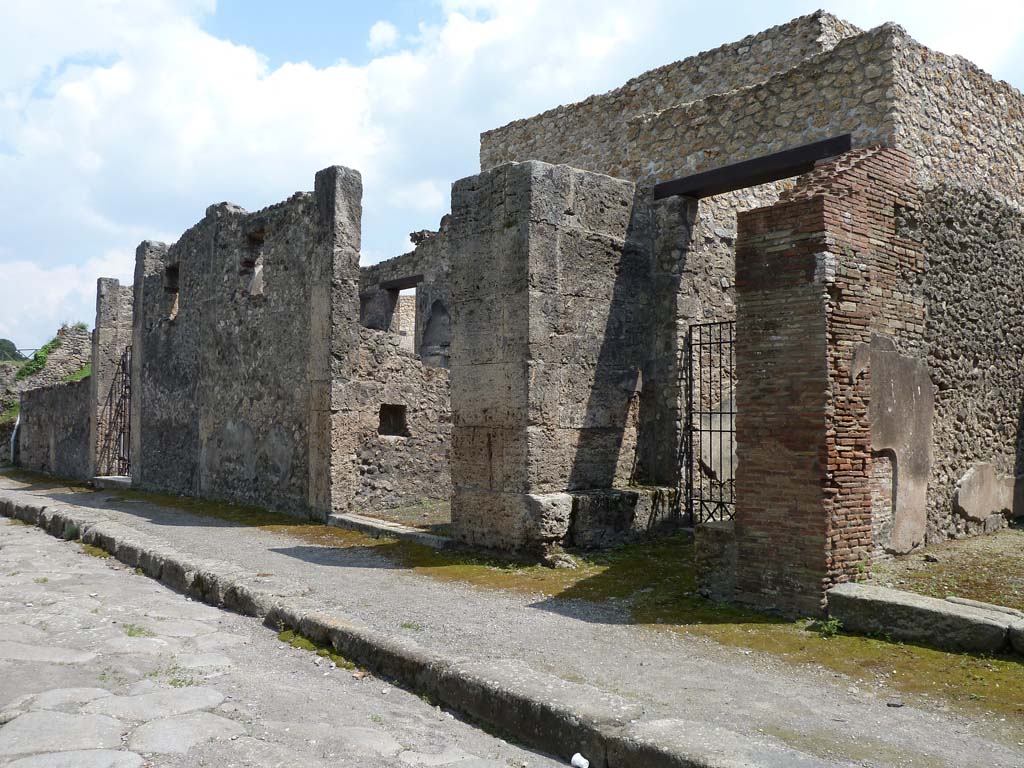
IX.14.3 Pompeii. May 2010. Entrance doorway to east of IX.14.2, with square niche visible.
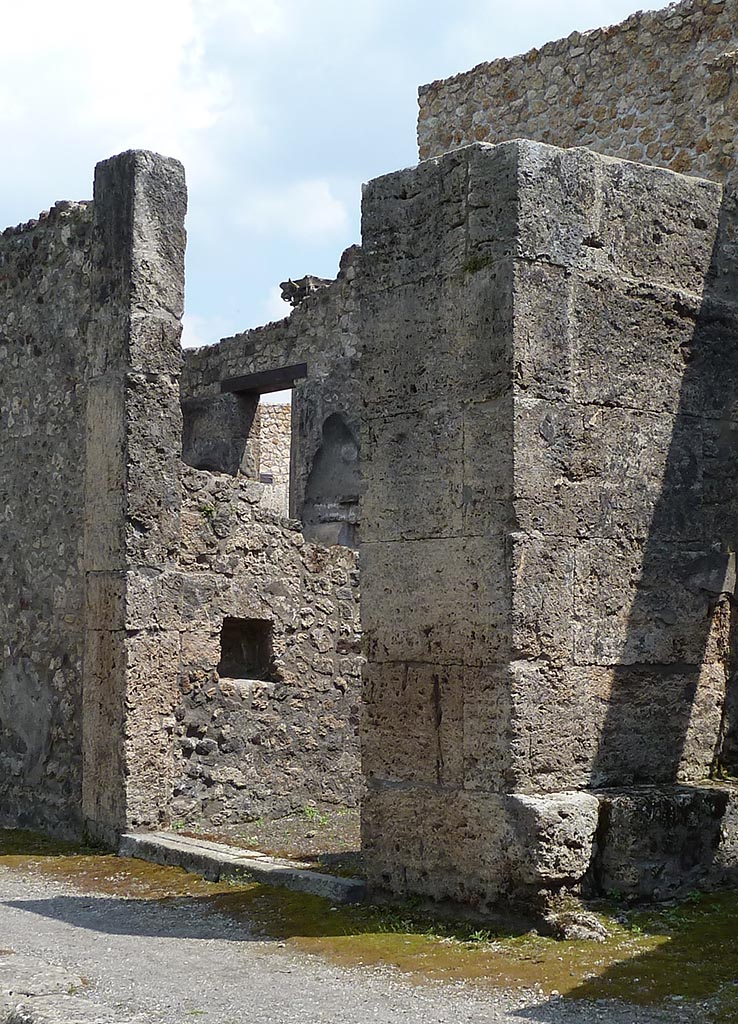
IX.14.3 Pompeii. May 2010. Entrance doorway looking to east wall.
According to Boyce, in the east wall was a square niche painted white within.
See Notizie
degli Scavi di Antichità, 1911,
351.
Boyce gives the location as Reg. III, Taberna located to the east of the entrance into the smaller atrium of Domus Obelli Firmi.
See Boyce G. K., 1937. Corpus of the Lararia of Pompeii. Rome: MAAR 14. (p. 31, no. 69)
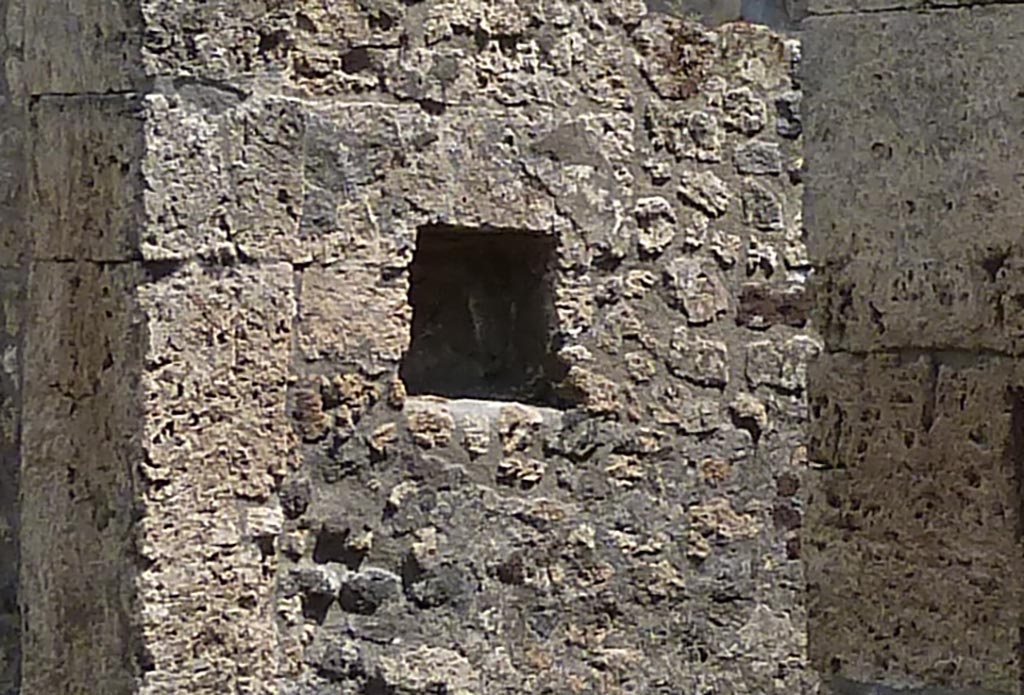
IX.14.3 Pompeii. May 2010. Detail of niche on east wall.
IX.14.4/2 Pompeii.
Aedicula lararium, north-west corner of atrium (b).
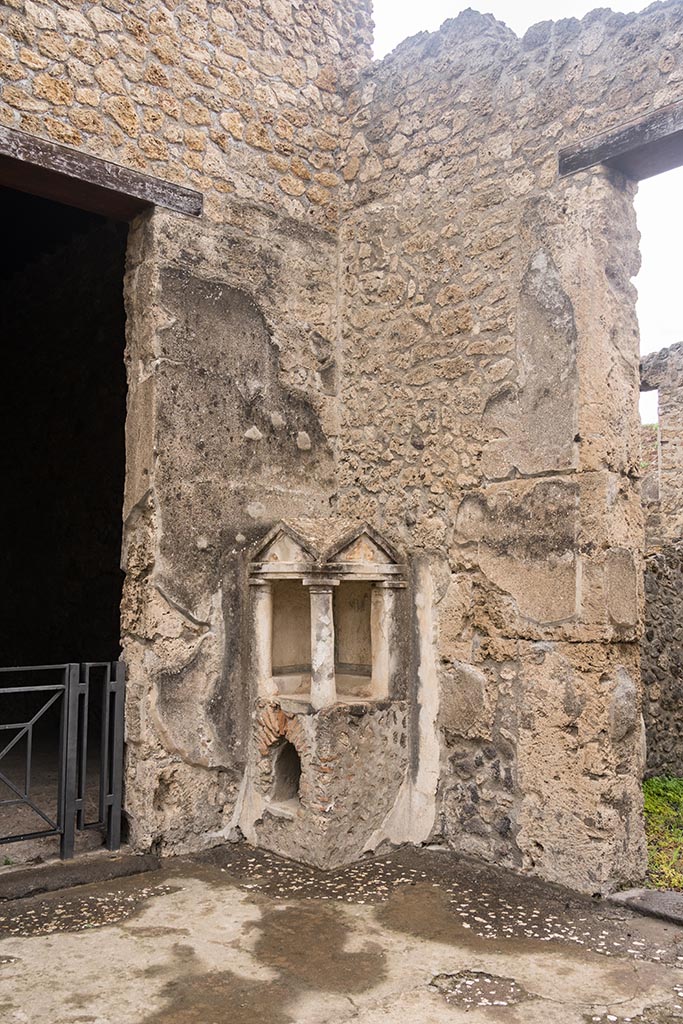
IX.14.4 Pompeii. July 2024.
North-west corner of atrium with lararium shrine. Photo courtesy of Johannes Eber.
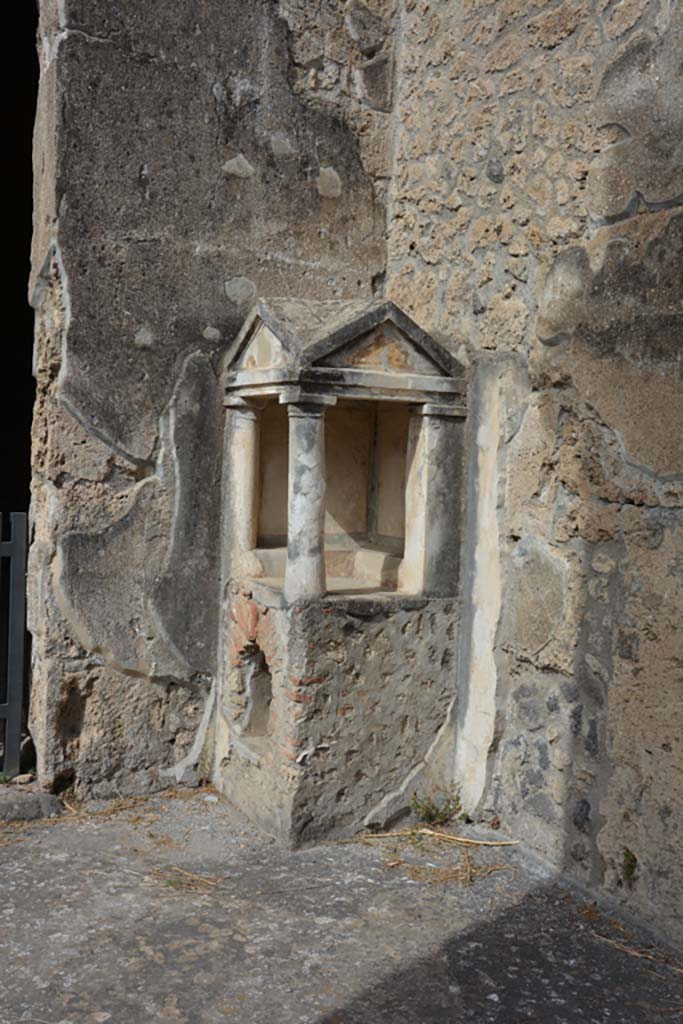
IX.14.4 Pompeii. September 2019. North-west corner of atrium with lararium shrine 32.
Foto Annette Haug, ERC Grant 681269 DÉCOR.
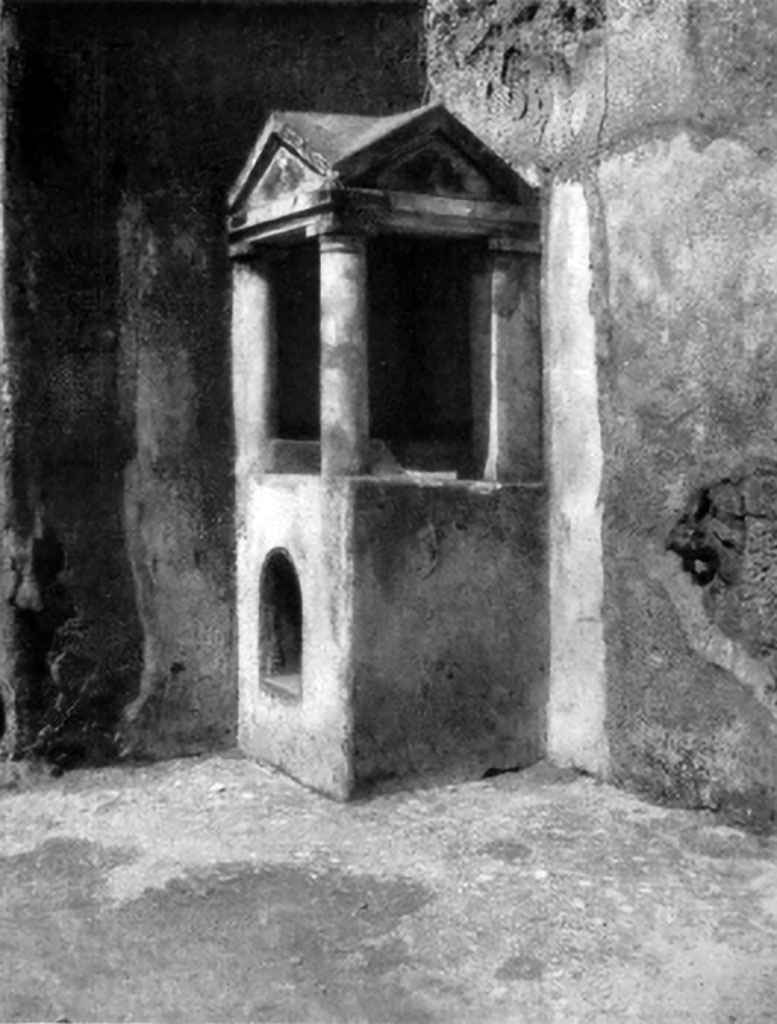
IX.14.4 Pompeii. 1930s photo by Tatiana Warscher. Aedicula household lararium shrine 32 in atrium.
See Boyce G. K., 1937. Corpus of the Lararia of Pompeii. Rome: MAAR 14. (p. 30, no. 67 and Pl.29, 3).
See Giacobello, F., 2008. Larari Pompeiani: Iconografia e culto dei Lari in ambito domestico. Milano: LED Edizioni, (p.251, no.A42)
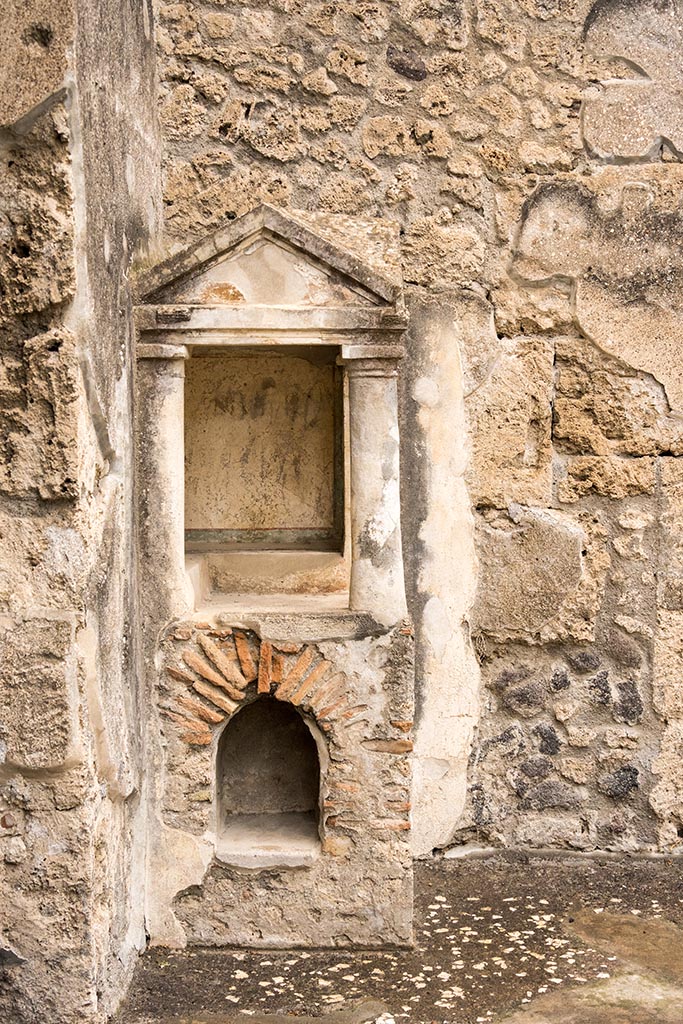
Looking north to Aedicula household lararium shrine. Photo courtesy of Johannes Eber.
Painting and niche, south wall in kitchen.
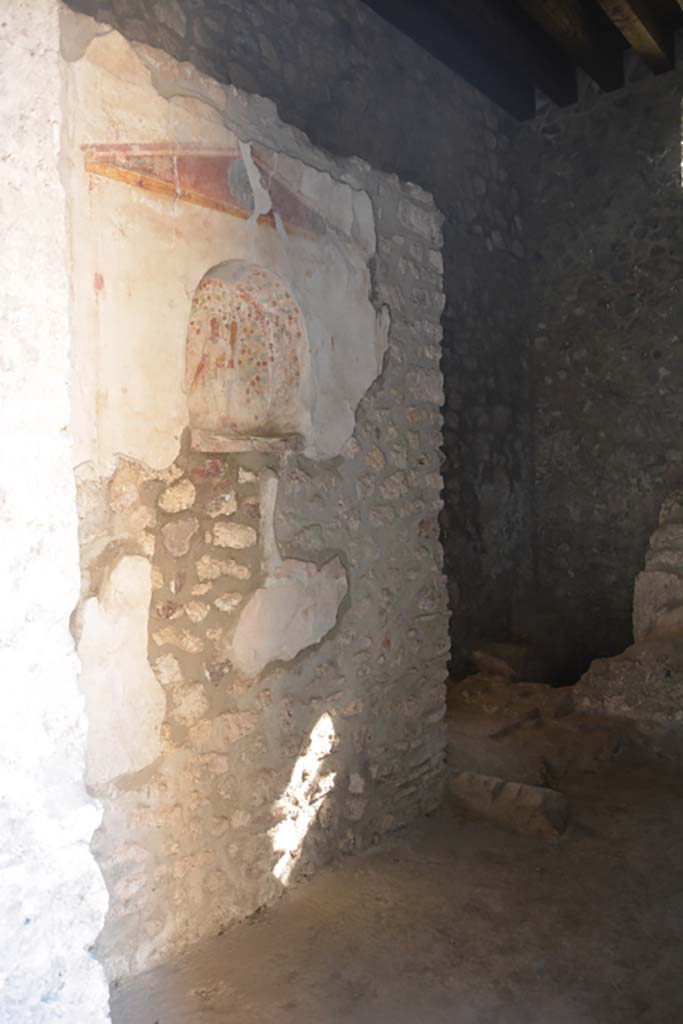
IX.14.4 Pompeii.
July 2017.
Kitchen 18, painted
niche lararium on south wall, with latrine in south-west corner, on right.
Foto Annette Haug,
ERC Grant 681269 DÉCOR.
According to Boyce,
a rectangular space was enclosed within a simple painted aedicula of slender
columns supporting a pediment.
The pediment
represents red marble with insets of green in the centre and at each lower
corner.
The inside walls of
the arched niche are thickly covered with spots of yellow, green and red.
On the rear wall is
a figure, which the report in Not. Scavi called Fortuna, but which certainly
represents the Genius.
He holds cornucopia
in his left hand and a patera in his right. There is no altar.
In the spaces at the
sides, and below the niche but still within the painted aedicula were the
following painted figures –
On each side of the
niche was a Lar. Above each Lar was a garland with a bird perched on it.
Below the level of
the niche was, on the right, a hog advancing to the left, and on the left was a
banqueting scene with six persons upon a triclinium, three men and three women.
Immediately below
the niche was a single serpent gliding right amongst the plants.
Between the entrance
doorway to the room and this Lararium was painted a figure of Hercules with the
club upon his shoulder.
The whole painting
is very crudely executed.
See Notizie degli Scavi di Antichità,
1911, p. 214, with photo p. 217.
See Boyce G. K., 1937. Corpus of
the Lararia of Pompeii. Rome: MAAR 14.
(p.31, no.68 & Pl.13, 2)
See Fröhlich, T., 1991. Lararien und
Fassadenbilder in den Vesuvstädten. Mainz: von Zabern. (p. 299, L111, T. 48,1).
See Giacobello, F., 2008. Larari Pompeiani: Iconografia e culto dei Lari in ambito domestico. Milano: LED Edizioni, (p.218, no.114).
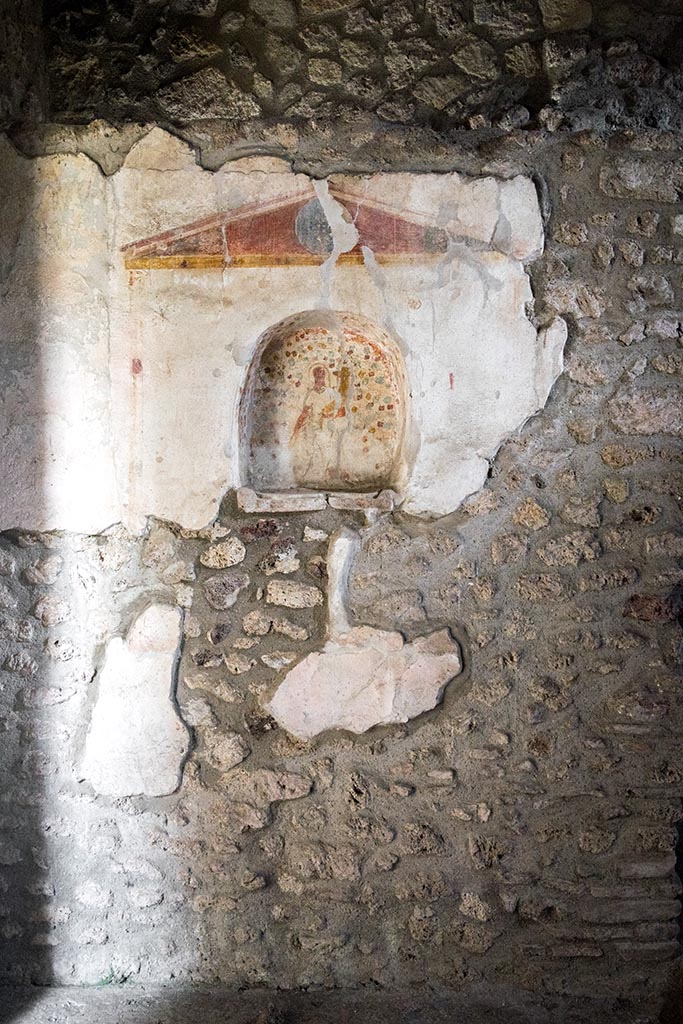
IX.14.4 Pompeii. July 2024.
Painted niche lararium on south wall of kitchen. Photo courtesy of Johannes Eber.
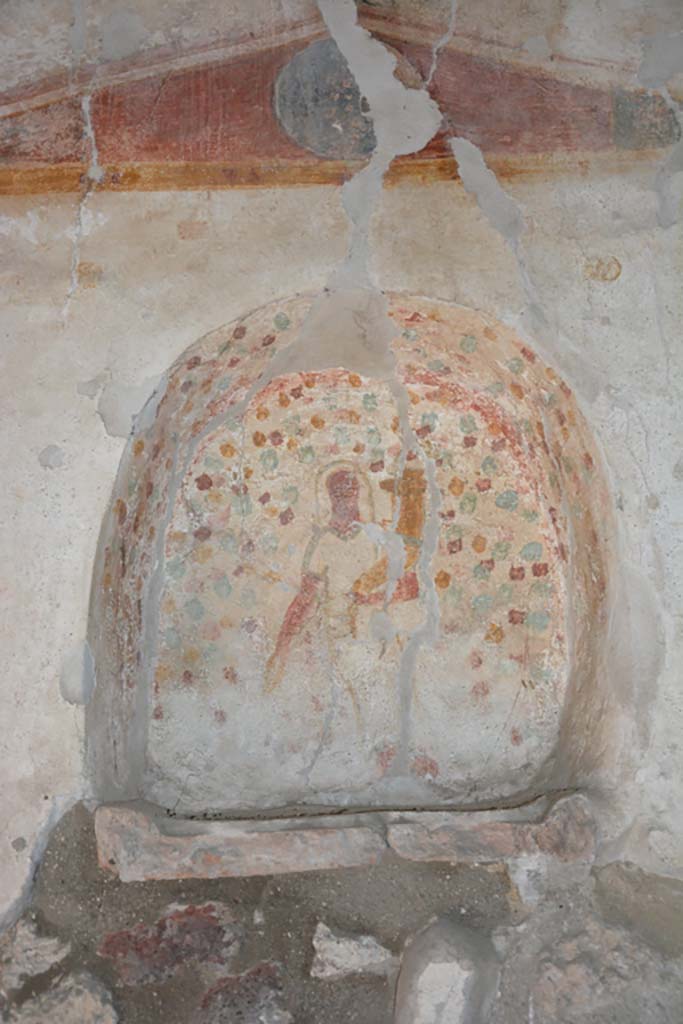
IX.14.4 Pompeii. September 2019.
Kitchen 18, detail of painted niche of
lararium set into south wall.
Foto Annette Haug, ERC Grant 681269 DÉCOR.
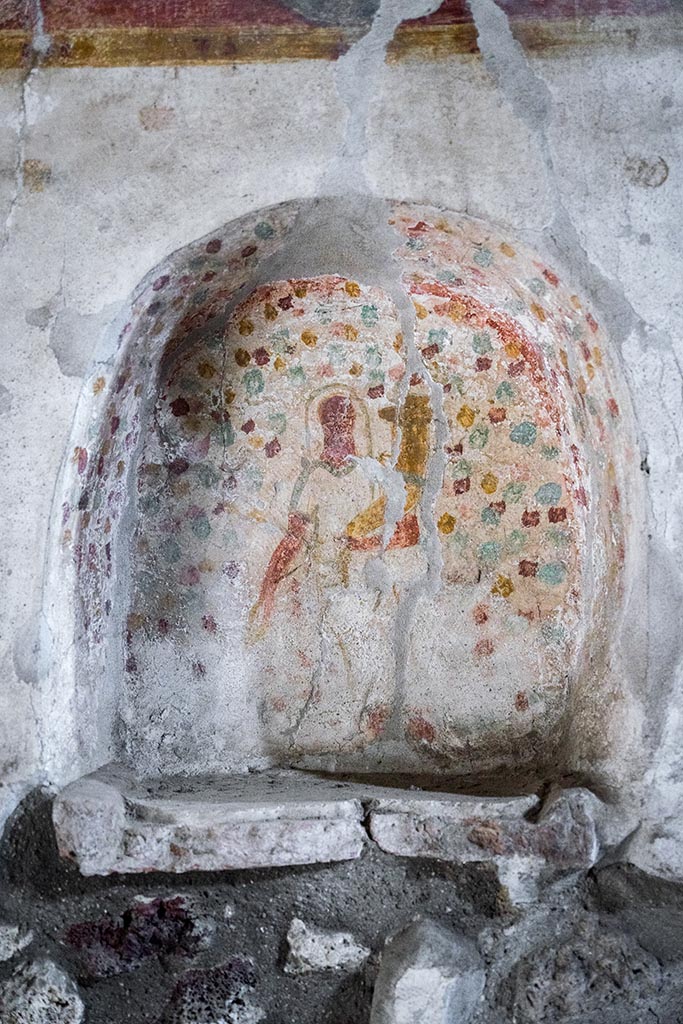
IX.14.4 Pompeii.
July 2024.
Detail of painted niche of lararium set into south wall of kitchen. Photo courtesy of Johannes Eber.
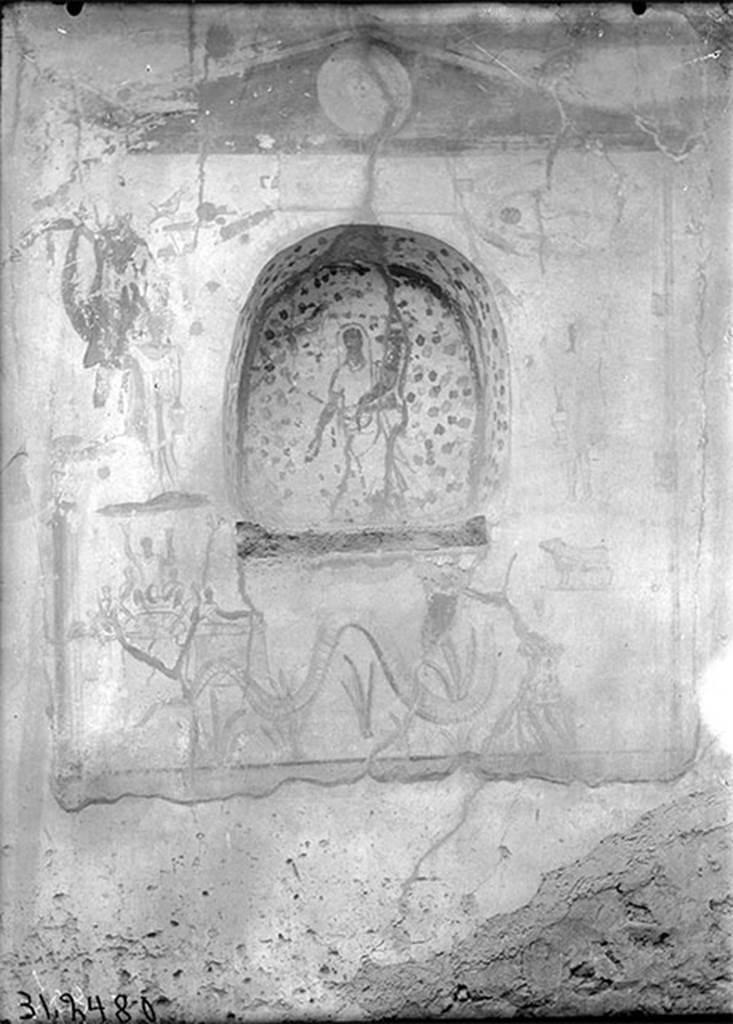
IX.14.4 Pompeii.
1931. South wall of kitchen, with painted niche.
DAIR 31.2480. Photo © Deutsches Archäologisches Institut, Abteilung Rom,
Arkiv.
See Boyce G. K.,
1937. Corpus of the Lararia of Pompeii.
Rome:
MAAR 14. (p. 31, no. 68 & Pl.13, 2)
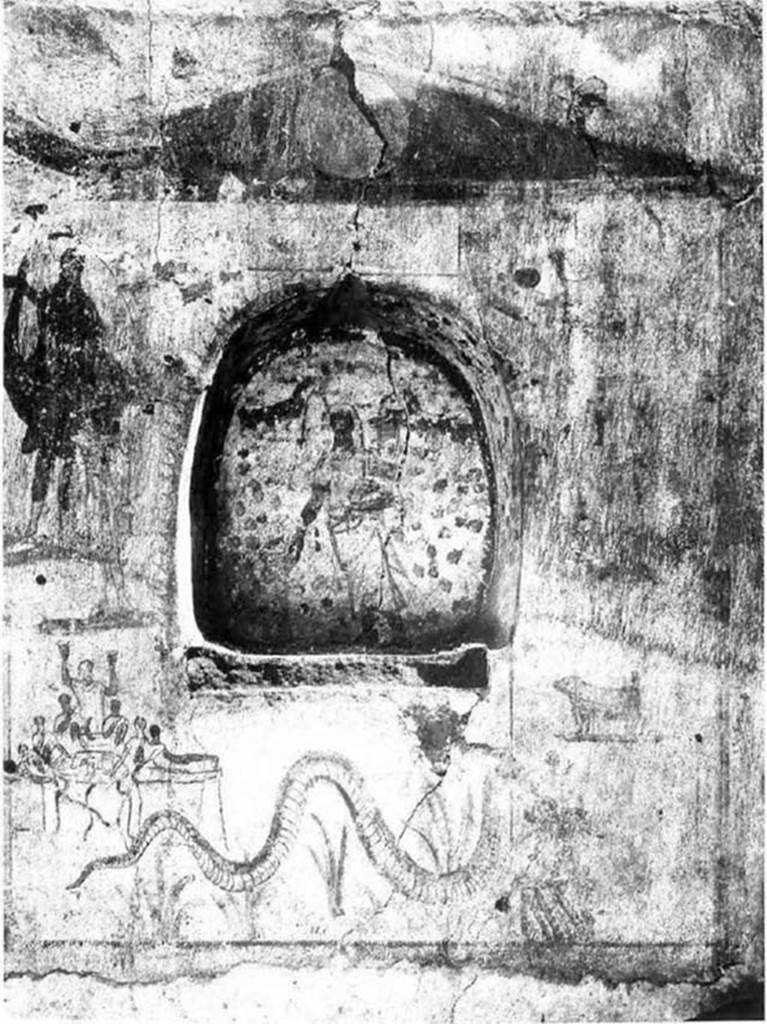
IX.14.4 Pompeii.
1911. Lararium in kitchen 18 at the time of excavation.
See Notizie degli Scavi di Antichità,
1911, p. 217, Fig. 3.
Back to household shrines list
